Midgard Campaign Setting by Libertad!
Intro
Original SA post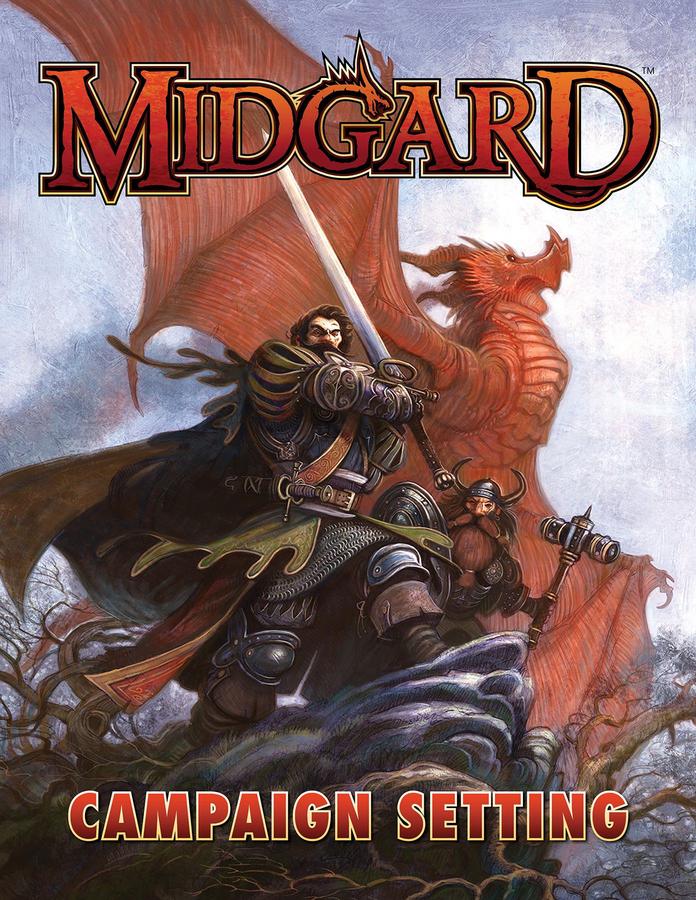
Hello everyone. I'm still riding the writer's high from my Northlands review, so I'm striking while the iron's hot to cover another realm of which I have a great passion. The Midgard campaign setting is the brainchild of Wolfgang Baur, a world he's developed for his home campaigns since he was 14 years old. But unlike a lot of similar long-running projects which often turn into humanocentric low-fantasy, Midgard distinguished itself among the pack. The first glimpses utilized evocative world-building. Central and Eastern European folk tales served as major inspirations, and the initial products centered around a clockwork city that sat on the edge of foreboding forest (which may or may not have a mind of its own). Over time more material was released for Midgard in Kobold Quarterly and Open Design, Baur's gaming periodical and publishing house respectively. There were also crowd-funded "patronage projects" which acted as a sort of ur-KickStarter for fans.
A proper campaign setting sourcebook was released in 2012 for Pathfinder/AGE System (Dragon Age/Blue Rose), but throughout its lifespan experimented with variant rulesets. To my knowledge, material for Midgard is available for the 3rd through 5th Editions of Dungeons & Dragons, Pathfinder RPG, 13th Age, Swords & Wizardry, and the AGE System. As of 2018 it released a mostly system-neutral World Book which advanced 10 years from the original setting. There's also a Player's Guide, Hero's Handbook, and Guidebook for Pathfinder, 5th Edition, and Swords & Wizardry systems to go together with the World Book as "sister supplements." The World Book is the one we're reviewing today; as the owner of both it and the 2012 version, I'll do my best to illustrate the major geo-political differences whenever they crop up.
Our book opens with some in-universe fiction by Wade Rockett, where a group of adventurers are on a quest to discover what troubles the World Serpent's sleep in order to save their city from an undescribed darkness. The adventurers all contain character aspects from the setting, such as an undead ghoulish monk and a clockwork priestess undeterred by the cold blizzard sweeping over the land. I'm not really one for fiction in sourcebooks, so I don't have much to say other than it demonstrates how a Midgard adventuring party can include more exotic options of races.
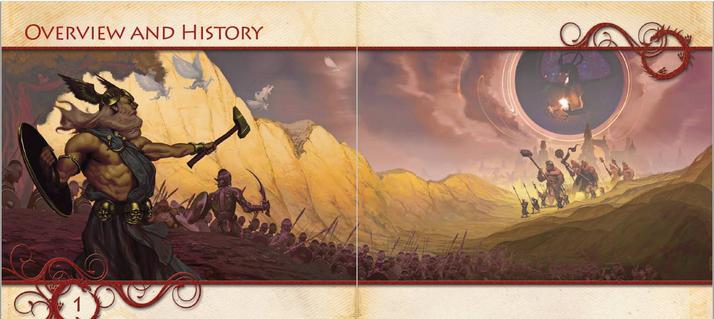
Right from the outset, the Midgard World Book highlights several major aspects which set it apart from other settings. It acknowledges that there are many pseudo-medieval fantasy worlds on the market, so the Seven Secrets of Midgard are meant to be played up to make gaming sessions here feel like a truly different realm. I like this concept: with the wealth of 3rd-party material out there, it's very hard to commit to purchasing a new sourcebook that several others don't do already.
- A Flat World: Instead of a sphere, the world of Midgard is a floating disc-shaped object encircled by Veles, a serpent-god biting its own tail. Few have truly made it to the edge to see this great beast for themselves. The cosmos is similar, with a moon and stars, and there are rumors that a civilization of fey live on the "bottom half" of the world.
- Elemental Dragon Lords: Dragons in Midgard are strongly keyed to elements rather than alignment and the good metallic/evil chromatic set-up. Several centuries ago most dragons combined their resources into forming a vast empire, realizing this could get them more influence and power than fighting amongst each other in hoard-filled caves. The Mharoti Empire is the most populous and powerful country in the known setting. It is here scaled races, from dragons on down to the lowly kobolds, are the dominant social force.
- Gods That Dabble and Plot: The gods in Midgard are very active in the mortal world, although they wear masks to conceal their true identity. The reason for this is that one gains a god's power via murder or enslavement, and as such the masks make it so that the true number of existing gods is unknown. Deities may take a different name (and even moral code and teachings) from culture to culture yet are united by similar themes (Perun and Thor both command lightning).
- Hidden Races: Midgard has several major races who had a prominent place in the world from the outset. But there are other peoples who are isolated enough that they only recently have been discovered to the point that they can interact with wider society.
- Ley Lines and Shadow Roads: Magical energy known as ley lines rushes through the world, and enterprising mages can tap their power to fuel their spells. An ancient elven empire used said lines to create shadow roads capable of long-range teleportation to link their empire. Both sources are keyed to specific locations in the world and are prized by heroes and villains, kings and archmages alike, for the power they contain.
- Shifting Borders and Falling Kingdoms: Midgard is not meant to be a static world where published material takes place within the same year in perpetuity. As you can imagine, Kobold Press has a sort of metaplot going for the setting in terms of published material. But this section is more personal advice for GMs to make politics, revolts, etc change the world around the PCs whether by changing things directly or from situations beyond their grasp.
- Time Flies, and Status Matters: This part is expressed in two optional rules, one of which is detailed later. Time Flies is meant to cover longer-term campaigns over a period of months and years as personal progression is meant to be a significant undertaking of one's life. Going from apprentice to archmage in a year is not the presumed standard. Aside from time-sensitive missions and dungeon crawls, the rules suggest that the timeline advances by twice the real-world time that has passed between game sessions. For long-form sagas, it is two months of game-time instead. The Status rules are detailed later, which is meant to bake ancient-world style social status into a trait for characters.
Personally speaking I like most of these iconic setting traits. I am a bit more wary of metaplots, and the time flies rules should be more subjective than definite; I prefer the Northlands approach, where individual adventures are spaced between each other by in-game years regardless of how many gaming sessions it takes to complete them.
History
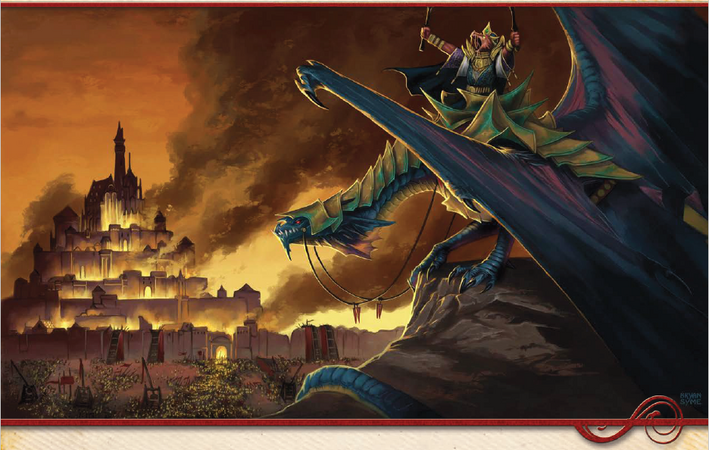
After this we get a timeline of events of Midgard, from the creation of the world to the modern day. The creation is subject to multiple interpretations, and the various races and cultures all have their own tellings. Dragons claim that the world was created by Veles for them to rule over, whereas the giants' insist the world was fashioned by the gods from the corpse of their murdered progenitor Aurgelmir. Regardless of the truth, it is known that the gods formed factions upon Midgard and warred against each other. The dwarves claimed that during this time they were created by the smith god Volund and the thunder god Thor to fight against the elves, giants, other races serving under the banner of enemy gods. During this time the dwarves achieved great deeds, but their halls fell from war and natural disasters. Historians have different reasons for this: some say they pushed they gods away and so were punished, while others say that elven sabotage and magic brought them low. The dwarves split in a diaspora with different cultural groups settling into new homes across Midgard.
Around 5,000 years ago the mighty pseudo-Egyptian Kingdom of Nuria Natal arose among a ley line-powered riverbank. Their civilization is the oldest continuous human kingdom, surviving through times when the rest of Midgard was brought low into war and barbarism. Two-thousand years later there was also a technologically-advanced island nation of Ankeshel which had flying carriages, lightning spears, and other marvels. It fell beneath the waves from the horrors living under the sea. And 800 years after that, a second great nation of elves created a new empire connected by shadow roads. They even ruled humans and other races, who by this time saw their rule as preferable to the centuries of chaos preceding their founding. But over time new generations knew only of elven rule, and Young Kingdoms seeking independence grew in lands the elves chose not to govern. Many of these dynasties still exist in some form today, albeit more in legacy than in unbroken succession. Krakova and Zobeck number among them. 800 years ago a war known as the Black Sorceress' Revolt broke out in the western nations of Bemmea, where human mages relied upon risky pacts with dark powers to summon into Midgard as soldiers. A mutual arms race between humand and elves arose out of this. In desperation some elves threw their lot in with similar dark powers, creating the subraces known as the shadow fey among the elves and the tieflings among the humans.
Shadow roads were shut down to prevent hellish forces from traveling Midgard at will, but not before the forces of the elven nation of Thorn marched through them long last time before disappearing completely. This began the start of the Great Retreat 482 years ago, when the elves withdrew in mass numbers from the mortal world. They left their empire barren in but a week. Other races stepped in to loot and occupy the empty lands, with the only elven enclave of Arbonesse remaining and closed off from outside contact. Gnomes, halflings, and servitor races were now free and directionless.
300 years ago a wise and powerful dragon known as Mharot created a political pact between others of his kind to create a Sultanate. As no dragon was willing to put another with supreme authority over them, they chose a human puppet prince to rule day-to-day affairs. The Sultan/Sultana paid tribute to the greatest dragon lords, and lesser dragons below them served as nobles administering their traditional lands-turned-imperial-districts. Utilizing legions of kobolds, dragonkin, and other subjected races, their power expanded across three continents by force or by treaty. They managed to crush the minotaur city-states and send their people scattered, but the dragons suffered their first major defeat from the god-kings of Nuria Natal. Even so, the Mharoti Empire still desires to claim the riches and land of Midgard under nobler guises. During this time the vampire and darakhul (ghoul) kingdoms of Morgau and Dhoresh formed, using the advantages of undeath to wage war at night and in winter. And the elves are starting to reappear in Midgard with little explanation on their part, seeking out ley line nodes, lore, and old religious sites.
We end this section with a series of recent events within the past 50 years. More nations enter into defense pacts against the Mharoti, the formerly-imprisoned sea god Nethus is freed from his prison but brainwashed by the goddess Hecate into believing himself her loyal husband, the darakhul conquer the nation of Krakova to absorb into Morgau, the shadow fey hatch an unsuccessful plot to take over Zobeck, the Queen of Dornig falls into an enchanted sleep, the Mharoti Empire's former Sultana flees the throne due to a coup from her previous military failures, among other things.
People of Midgard
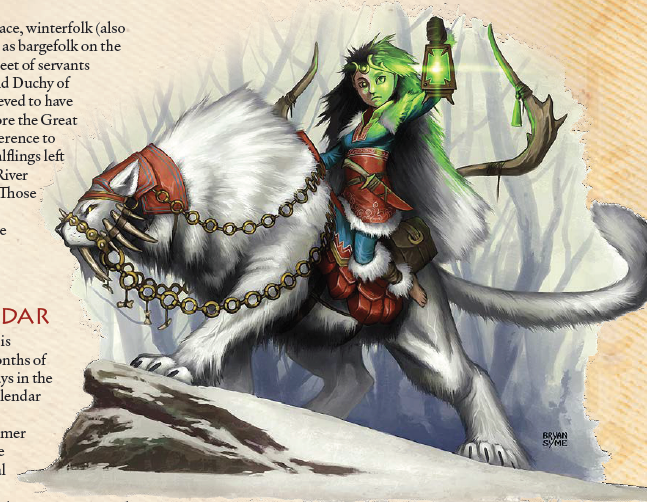
We get a brief overview of the major regions of Midgard, which will be covered later in their own chapters. Midgard has seven major races, defined more by their representation in major world events and in some cases their commonality. There's also 8 minor races who have their place in Midgard. The races and their magical traditions are entirely in "fluff" (no game mechanics) but we're referred to appropriate system-based sourcebooks for Pathfinder and 5th Edition for actual rules. Each of the major races besides humans have a brief entry on cultural magical traditions which arose among them.
Before covering the races we have the optional Status rules. Basically it is a score every character has. It can range from 0 (slave) to 60+ (legendary heroes, demigods). It is either a flat 4 if point-buy is used, or with a roll of 1d6+1. A PC adds their Charmisma modifier to their starting status, and one's race (and class if using the Pathfinder rules) can further alter it. In short, in an adventuring party NPCs will address the PC with the highest Status as the default party leader. There is a table provided to be used as a yardstick for an average NPC's social standing. Personally I find it rather arbitrary in places: what separates a "peasant" from a "commoner," and why is an archer's status just below a guild leader or bishop? It's also a bit restrictive, in that it may lock out certain character concepts with a bad roll. You wanted to be a noble scion wizard struggling with familial obligations of rulership when they'd much rather bury their nose in books? Too bad your Charisma is 10 and you rolled a 1 on the d6. Welcome to serfdom!
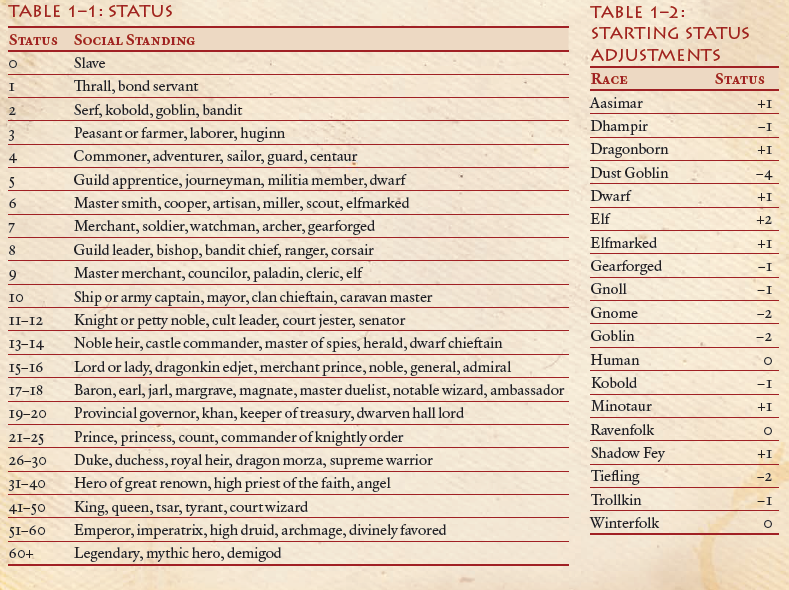
Humans are a farflung group and inhabit all sorts of social structures and kingdoms. We get a rundown on the major ethnic groups and their cultural languages. Caelmaran live mostly in the western lands and are closely associated with dark magic (sometimes unfairly, sometimes not). The Dornigfolk are humans living in traditional elven lands and as such adopted the language and culture of "the last bastion of the empire of Thorn." Kushites are people of Nuria Natal, the Mharoti Empire, and many Southlands kingdoms. The Madgar hail from the kingdom of their name and live among the Rothenian Plains; they are also skilled in animal husbandry and sadly prone to drunkenness. The Northlanders are pseudo-Scandinavians who hail from a martial culture. The Roshgazi are mostly a sea-faring folk who share close ties with the minotaurs. The Septimes (who call themselves the Manzaro) are the people of the Seven Cities whose realms are notable for their methods of ritualized, honor-based warfare.
Finally there's mention of numerous smaller human ethnic groups and a perception among other races that humans are more prone to supernatural corruption.
Dragonborn (known as Dragonkin in the 2012 sourcebook) are the youngest race of Midgard. They are humanoid reptilians imbued with elemental traits of a draconic lineage and organize their ethnic groups along these lines (interbreeding is possible). They comprise a huge portion of the Empire's military force where their breath weapons (and elemental resistance) are incorporated into military tactics and formation. As a culture tend to be very arrogant and patriotic, pointing out how relatively fast their civilization grew in spite of their race's youth. Dragon magical traditions focus on the elements and there are rituals capable of turning members of the reptilian races into "higher" forms (kobold to dragonborn, dragonborn into drake).
Dwarves are divided into three major cultural regions. The dwarves of the Northlands are the most tradition-based, favoring the gods Thor and Volund and making continual warfare against the monsters of the northern realms and raiding coastal territories of the south. The dwarves of the Ironcrag cantons are focused in the crossroads and famed for their advanced technology, including gunpowder and airships whose construction is a closely-guarded secret. The dwarves of the Southlands live primarily in Nuria Natal and are integrated into the dominant human culture as bodyguards, warriors, creators of clockwork servants, and engineers of god-king's pyramids. Dwarven magic is believed to be learned from Wotan and are the mutual traditions of rune magic (which even non-mages can use) and ring magic.
Elves once lived in a grand empire of Thorn, and although not the eldest race they take pride in teaching the human and dwarves "the art of civilization." As of now the few elves remaining in Midgard are part of three groups: the ruthless and duplicitous shadow fey, the nomadic Windrunners of the Rothenian Plains, and the river elves of the kingdom of Arbonnese. The Elfmarked are humans with traces of elven blood which sometimes manifest in ways such as pointed ears. Arbonesse elves have three names: a birth name by parents, a personal name taken upon adulthood, and a lineage/family name. Dornig law forbids those without elven heritage from appropriating elven names, but there's a brisk trade in genealogy in that realm for tracing one's ancestry in hopes of claiming this social status. Elven magic tends to be ritual-based and tied to the shadow roads.
Gearforged are deceased souls imbued into an artificial clockwork body, first created by the priesthood of Rava. They were made to serve as soldiers in the city of Zobeck, and their bodies rely upon a combination of magic and technology to function. Their magical traditions involve soulforging (the creation of transplanting souls into gearforged bodies), and a tradition of Clockwork Magic focused around machinery.
Kobolds were the slaves of dwarves long ago, suited to menial labor and minework. Many live in the fringes of society in dwarven kingdoms, and in the city of Zobeck are confined to a large ghetto. They learned to adopt unorthodox tactics to survive, such as trapsmithing, creation of small warrens, and dirty fighting. They dominate the mining industry in many lands, and in some cases they own their own mines which they guard fiercly. The Mharoti Empire is an exception to their otherwise low social status: there they are treated as being above humans yet still below dragonborn and dragons. Many kobolds throughout Midgard either aspire to travel there or view the realm as one of liberation. There is no mention of kobold-specific magic.
Minotaurs are a searfaring race of warriors. They are fond of self-decoration, whether carving patterns in their own horns, shaving or dying their fur in certain ways, ritual scars, and braiding hair with tokens of fallen enemies. They are great lovers of food and many communities devote significant time to finely-prepared cuisines during festivals and important events. Minotaurs who have their horns broken face considerable stigma and must constantly prove their worth, which ironically has produced some of the most famous members of their race among the "brokehorns." Minotaur magic focuses on labyrinthine themes, from confusing illusory charms to traps and abjuration. Said magic is forbidden to be taught to non-minotaurs.
Ravenfolk are also known as huginn or heru. They have small settlements all across Midgard and distrusted for associations with spies, thieves, and being all-purpose troublemarkers. The exception is in Nuria Natal where they are honored and serve in high positions in temples of Horus. But whatever culture they live in, ravenfolk take pride in being messengers for the gods; they do not choose which god seeks an individual, and it is an unlucky Ravenfolk who brings the attention of one of the Dark Gods. They claim to have invented or shared the runes of the All-Father, and tend to focus on prophetic and shadow spells.
Shadow Fey are believed to be elves and goblins who swore an oath of service to Sarastra, the goddess of night and magic. They gained great power and prestige in the Shadow Realm, at the expense of being cut off from their former allies and an aversion to sunlight. They still adhere to the cultural traditions of their elven ancestors, and their magical traditions involve the manipulation of shadow and starlight.
The Minor Races are low in number, too scattered or isolated to match the power and legacies of the major races. Their entries are much shorter here. The Aasimar are human descendants of angels concentrated in the realm of Ishadia and are engaged in a war of attrition with the Mharoti Empire. Bearfolk are anthropomorphic bears who live in roving bands concentrated in the Northlands and Shadow Realm. Centaurs roam the Rothenian Plains and have a violent history of banditry. They've even destroyed small nations and entire cities. Darakhul are undead akin to ghouls who feed upon the living. They have a pact with the Dark Gods and live in in an underground of Doresh. Dust Goblins are people who refused to be conquered or negotiate during wartime, but due to being on the losing side of many wars got pushed to the most inhospitable regions of Midgard. The text contradicts itself on the "no masters" part by mentioning that worgs and nightgarms treat them as pets and servants and in turn the goblins worship them. Dust goblins scavenge among ruins for relics to trade in cities, thus earning the "dust" moniker. Gnolls are raiders of the southern kingdoms and tend to be xenophobic, but have integrated to various degrees in Nuria Natal. Gnomes are a people whose ancestors earned the wrath of Baba Yaga and thus turned to the aid of devils for protection. They now mostly live in the forest kingdom of Neimheim of which little is known. Tieflings once dominated the noble families of western magocracies but are now reviled for being "hellborn," although shadow fey, gnolls, and gnomes tolerate them. Trollkin are people with mixed giant and fey bloodlines; they are known for being ferocious warriors as well as having powers over spirits and the roads between worlds. They have their own kingdom in the Northlands. Finally the halflings, or Winterfolk, left with their elven masters during the Great Retreat. Those few who stayed behind in Midgard are rarely seen and ply their trade on the rivers of the Grand Duchy of Dornig.
Miscellaneous Stuff
There's quite a bit of entries here for various cultural details. I'm not going to treat them as their own sections, instead surmising them.
Time and the Seasonal CalendarWe get an explanation of Midgard's calendar system (12 months, 360 days and 6 intercalendar festival days) along with days of the week of the most populous cultures. We have a discussion of how various people mark their years.
Travel, Trade Fairs, and Festivals: This has detailed accounts of the passage of days between well-known cities of Midgard both by foot and by horseback. Daily pay for guards is listed based upon
profession, and there's a list of trade fairs based upon their location, date, and what goods are their specialty. Major holidays festivals around Midgard focus around seasonal changes. Some of the more interesting ones include the Lantern Festival during the Winter Solstice where a torch-light vigil to the sun-god parades around town; New Year's Dawn where people gather to watch the sun rise and bang pots and ring bells to drive away bad spirits; Hatching Day for reptilian races in which many of them are said to have their first birthday; and the Day of Misrule where a child is pronounced high priest or king/queen and the adults seek to fulfill their pronouncements.
Ley Lines and Shadow Roads: Ley lines are primarily used to empower spells beyond their base capabilities. They come in three varieties based on strength: weak, strong, and titanic. The specifics for their game effects differ depending upon the rules system, but in general grant beneficial effects for free and/or add to the numerical values of spells. However, manipulating their power is no sure thing and mages risk backlash of varying magnitudes if they fail to concentrate the power. We also get a map of the known ley lines of Midgard:
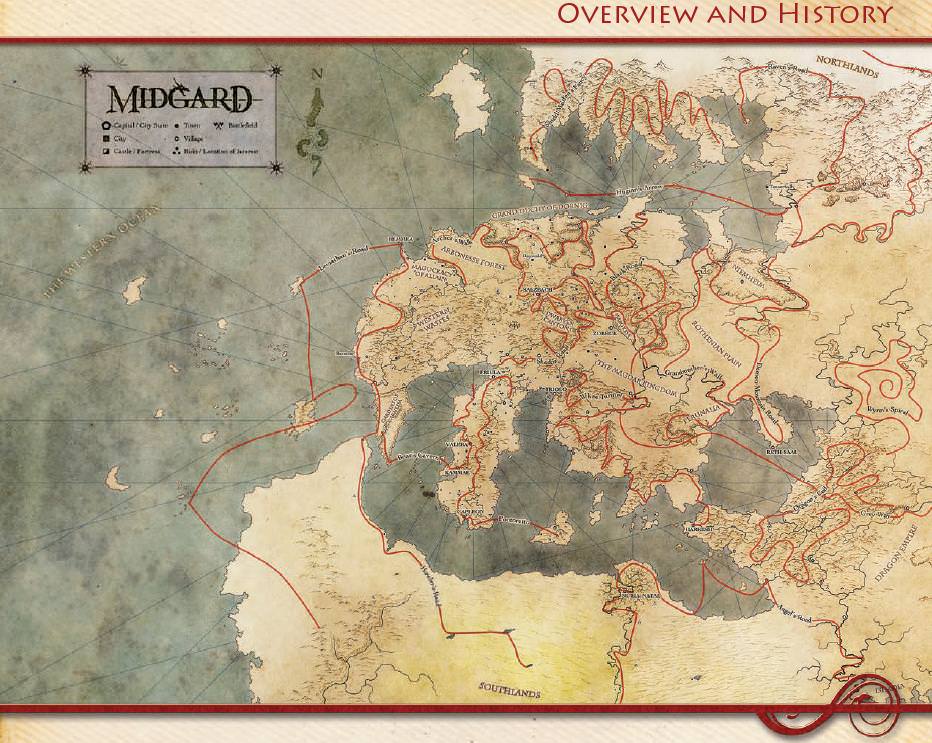
The arrangements are not coincidental. More than a few nations based their territories on ley lines, such as Nuria Natal whose line more or less goes along the riverbanks. The Greast Wastes of the western realms are screwed up from the elf-mage wars and so has only one reliable line in the far west.
Shadow Roads are basically fast-travel networks. The best-maintained ones are in the former elven lands of Dornig and can take 1d3 days of travel, but beyond there the travel times are longer (particularly in the Great Wastes where 1d12 is the standard). Not all shadow roads are safe. They may be guarded by celestial, fiends, fey, and other dangerous entities. In order to travel a shadow road, you must know its location and be able to open it via a Shadow Road spell or Key of Veles magical item. Some have additional prerequisites for their function, like only being usable on a full moon.
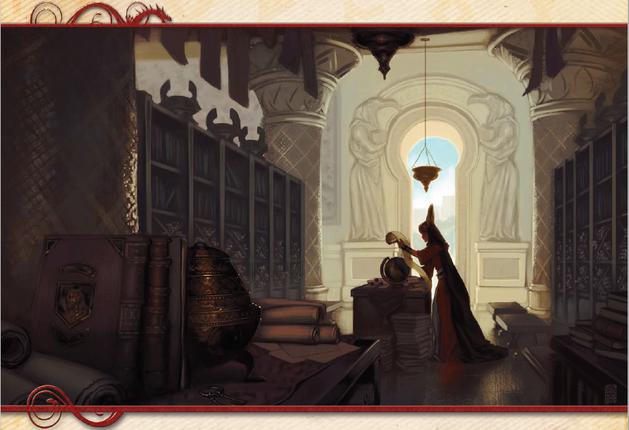
Magic and Scholarship: This section highlights the major magical colleges of Midgard and their specializations which aren't always wizardly in nature. Colleges tend to be specialized rather than generic, able to study a variety of magic but with a major emphasis on certain kinds. For example the Arcane Collegium of Zobeck is notable for clockwork magic as well as alchemy and illumination magic, whereas the Great Linnorm House is built out of the bones of dragons and makes heavy use of runic spells and has an all-female order of celestial magical practitioners.
Languages: There are 28 major languages of Midgard. Whereas this would be a vestigial feature in most games, language has a folkloric effect and some of the more supernatural and stranger tongues grant speakers unique abilities. For example, mastery of Void Speech (spoken by alien gods and beings of the outer darkness) adds +1 to the DC of fear-related spells and skill checks, while Whisperium (a silent language of gnomes and diabolists) allows the speaker to cast a spell silently once per day. Many tongues grant a bonus on social skill checks related to their dominant culture 1/day. This both shows that the speaker's knowledge of their culture and phrases rather than being an outside, and reflects how concepts are more easily understood in one's native tongue.
The World: The final section of this chapter talks about the setting's cosmology and the planes of existence. We know already that Midgard is a disc-shaped realm surrounded by Veles, but the Elves retreated to a land on the opposite side of the coin alternately called the Bright Land, Elflands, and similar names. Between these two sides is the Shadow Realm, a dark and forlorn place of nightmares. The heavens are geocentric, meaning that the sun, moon, planets, and stars orbit Midgard. The sun is the chariot of Khors, or Aten, or whatever dominant culture views as their sun god. There is a single primary moon and seven lesser moons known as the Mage's Stars for their symbology in arcane magic. Stars (not moons) in the sky are intelligent living creatures capable of coming down to Midgard, whether just to visit people or in need of great heroes.
Six planets orbit Midgard, but most people only know of five and the sourcebook does not say if they too are disc-shaped. They are associated with various elements in alchemy or believed to hold sway over various aspects of the world. Asaph is believed to influence the seas of Midgard; Ermoan is a small and fast planet which some believe to be a comet or a lost court of shadow fey; the darkened planet known as Melgros is only able to be seen by those with the keenest eyes and thus earned the name "Archer's Planet" because most who see it happen to be legendary archers; Temperos is believed by the giants to be home of the gods; Tiomoutiri is most visible at sunrise and as such has a sacred spot among sun-worshipers; finally, Zuhal is considered to be responsible for controlling all magic.
As for other planes of existence, they are the domains of the gods and their servants. There's the tortuous Eleven Hells; the gluttonous Evermaw which is the afterlife for all undead; the voidlike realm of the Ginnungagap full of alien, maddened creatures; the great marketplace of Lingedesh where anything can be bought and sold; Ravatet the Plane of Rusty Gears where forgotten treasures lurk among the junk piles and strange scavengers; Silendora, a mythical land believed to be where the Elves retreated; and Valhalla/the Storm Court, where gods of the North and of war come to meet and hone their blades.
And connecting all the planes together is Yggdrasil, whose World Trees are its branches that poke into Midgard and allow travelers to visit other realms. They are revered almost everywhere they grow, and druids and worshipers of the Northlands pantheon treat their spells as if they were 1 level higher when on such sacred grounds. We get a list of known World Tree locations, including some of which became corrupted by dark powers.
Thoughts So Far: Midgard has a sort of storybook feel in the set-up of its world, what with masked gods and talking stars and a flat world. The racial magical traditions, association of planets with alchemic metals, and list of colleges for spellcasters point to a high fantasy and high magic style of setting. Having the most powerful country be a non-human realm is also novel, and I do like how they gave learning languages mechanical benefits even if not all options are equal. The bulk of the rest of the book covers the various lands of this wonderful world:
Next chapter we'll cover the Crossroads, the geographic and cultural heart of the continent!
Zobeck and the Crossroads
Original SA post
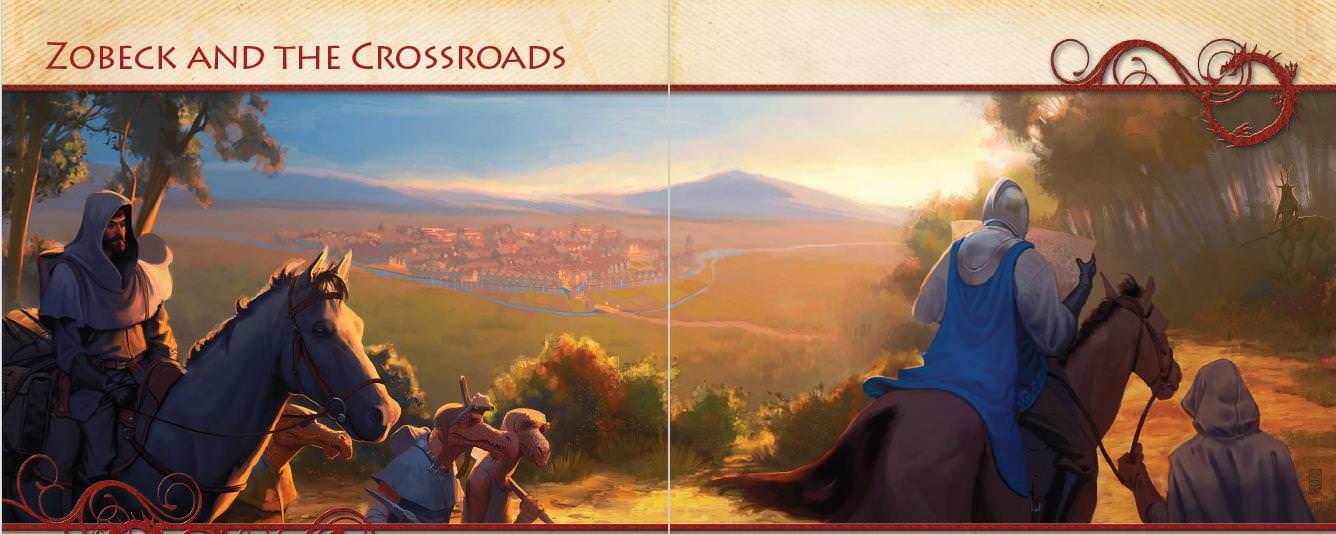
The second chapter of the book, and the first regional chapter, covers the Crossroads. Each major region of the setting has a sort of theme going for it, and the Crossroads is "feudal European trading hub." A fair portion of this chapter focuses on Zobeck, given its relative prominence in the setting, and has a bit more pseudo-steampunk elements in its gearforged and clockwork overtones. The Crossroads trades with all its neighbors, although some of them such as the undead kingdoms to the north and the Mharoti dragons to the south aren't above trying to strike hard bargains at swordpoint.
Before covering the countries and city-states we learn about the cultural customs in the form of great gatherings and celebrations. Daughter's Feast takes place in Perunalia and sometimes the god Perun himself and his divine family attend; the Dwarfmoot is a seasonal open forum/court in the Ironcrags where all matter of deals and disputes are resolved; Knight's Call is a social gathering of warriors from various lands seeking to test their martial prowess against each other; and the Queensmeet is a grand tournament where knights and vassals compete for a bejeweled helmet set with a gold band whose champion must compete yearly to defend their holding of it.
Additionally the section talks about how Ironcrag dwarves make use of indentured servitude from prisoners of war. They usually ransom them back to villages, but when people are unwilling or unable to pay they are used as a labor force for 10 years. Although Ironcrag law forbids starvation and torture of thralls and a decade is not long in a dwarf's lifespan, the practice alternately breeds fear and resentment. The former is beneficial to the Ironcrags in that many mercenary companies are less willing to perform operations in dwarven territory, but the latter is detrimental in that it gives rise to vengeful warriors who feel their lives have been stolen from long captivity.
The Free City of Zobeck
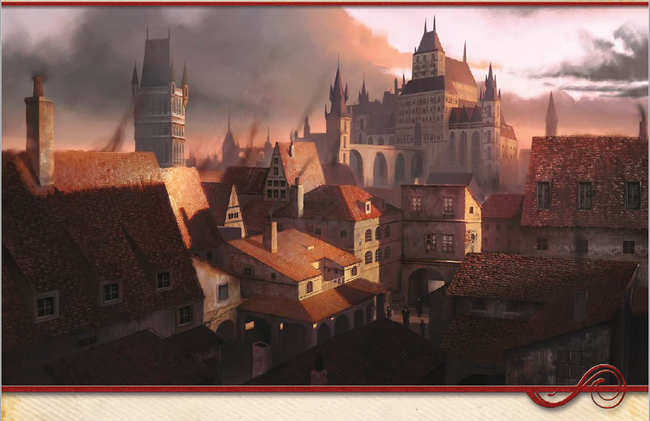
Zobeck was once a feudal realm whose people suffered under the nobility of House Stross. But a Great Revolt among the common folk overthrew the crown and instituted a new form of government. Consuls comprised of merchants and politically-connected people, serve 5-year terms, and from among their number they appoint a mayor of the city to serve a 10 year term. Many Zobeckers prize the way of mercantilism, an ideal where commerce and personal skill are the pathway to success rather than a royal bloodline. This ideal is far from realized; in spite of their participation in the revolution, Zobeck's sizable kobold minority are denied employment and living space in most of the city. Most of them live in the cramped confines of the Kobold Ghetto which may as well be its own world apart legally and culturally.
Zobeck is separated into 5 main districts, with 6 smaller ones. The Citadel District is where the wealthiest burghers live and is home to the knightly Order of Griffon Riders who act as an aerial cavalry in wartime. This District also sports the Free Army and its famed Zobeck Hussars. The Collegium District caters to the famous Arcane Collegium and the needs of scribes, mages, and intelligentsia. The Collegium spares no expense in protecting its assets, from clockwork traps to gargoyle guardians. In spite of its small student body of 40 it has state-of-the-art laboratories and libraries. The Dock District sits along the city's river and is the busiest area of the city. It is home to the gnomish Blue Barbers of Wharf Street who have hair-restoring tonics, but are rumored to be spies for the Shadow Fey. The Gear District sees to the maintenance of clockwork and steam-powered devices and is where the gearforged congregate for repair and socialization. The city government pours considerable expense into continual creation of gearforged soldiers, about one a month in addition to creations made via private donations. The Kobold Ghetto is a warren of streets no more than six feet wide with interconnecting roofs keeping out the sun.
During the age of House Stross the Ghetto was a giant labor camp, and in spite of terrible conditions it produced more than a few kobolds responsible for valuable inventions but whose names are lost to history. After the Great Revolt the kobolds re-purposed the camp to be more generic residential space even if living standards are still poor. An unofficial network of linked iron chains and barrels act as impromptu river bridges for smugglers and other never-do-wells. The most infamous den of ill repute is the Pit of the Fierce Lynx, an underground gladiatorial arena where the winner is treated like royalty in the Ghetto for a week and a day.
Beyond this we have brief mentions of minor districts, such as Lower Zobeck where the poor working classes live, a series of old mining tunnels known as the Cartways once used by House Stross for private parties, the Merchant District which has all manner of mundane goods along with strange magical items brokered at the Shadow Fey Exchange, and Upper Zobeck which is home to the Free City's centers of administration and government. We end our time in Zobeck proper with Places of Interest, such as the Old Stross Public Bathhoue which is a favorite social gathering spot for rich and poor alike, a bar of scum and villainy known as the Weathsheaf which welcomes gangsters, diabolists, and and "legitimate businessmen" operating under a tense neutral space, and the Winter's Kiss Shadow Fey Embassy whose location on Alchemist's Folly street seems to shift every so often.
METAPLOT: Lord Mayor Karillian Gluck was a relative non-entity in the 2012 edition, and after a threat on his life by the Shadow Fey a dwarven woman known as Constantia Olleck now fills his shoes. She made a small fortune off of mule trains, and is forging alliances with neighbors in the wake of the Mharoti Empire annexing the city-state of Illyria (which is in the Seven Cities region).
The Shadow Fey originally did not have an open presence in Zobeck save among informal traders, but the adventure Courts of the Shadow Fey involved their attempt in taking over the city. I do not own this book so I can't speak much of specifics, but while they haven't been driven out for failing in this endeavor they are kept at arms' length by just about everyone in the city.
Outside the city walls we get some information on nearby villages and fortresses. Most of them don't have anything of note to mention in this reivew besides the Freehold of Obertal. This military garrison is commanded by a pair of wedded Griffon Knights who are abusing their authority to extort "protection fees" from travelers. There are entries on the most common trade routes, the prominent trading houses both domestic and foreign, and the mercenary companies. The latter group has the most interesting people, such as the Black Brotherhood who purse war for the sake of Mavros the War God, the gnoll band Hrothgar's Marauders whose leader is possessed by a dormant demon suppressed deep within his mind, and the mostly-gearforged Clanking Legion whose recent military victories are due to miraculous magic of unknown origins.
We do have a wordy section on people daring enough to trade with the shadow fey. These elves view haggling for gold as beneath them, and instead prefer to trade unique magical goods for a fraction of a mortal's memories, "just a sliver" of a year or day of life, or sex. The last part is because such an activity provides a brief sense of "warmth" and intimacy among an otherwise jaded people. A pair of merchants named Jabber and Tuck Marick grew immeasurably rich from their deals with the fey, but in recent years things changed. Now most trade goes through the Shadow Fey embassy or Exchange, and the market for moonsteel-forged weapons (shapechanger bane) dried up as every fey merchant makes a prospective buyer swear an oath to never utilize these armaments against their people.
Not claimed by Zobeck but a stone's throw away, the Margreve Forest is a woodland realm which has existed since time immemorial. Although there is no proof, the forest seems to have a mind of its own and those who pay it proper respect find their travels within easier...and those who despoil its bounty find that the very natural world turns against them. Doting parents and jaded elders alike caution people to stay away, and among monstrous horrors it is also home to the feudal ruins of House Stross, bandits, and even the secret mines of kobolds. There is but one trade road cutting through it, but as that road leads into the undead-ruled kingdoms of the north, it too has a grim reputation. Although it has a brief entry in the World Book, the Margreve Forest is very much a Grimm's Fairy Tales style of deep, dark wood. The Tales of the Old Margreve adventure compilation expressed these themes very well.
Free Cantons of the Ironcrags
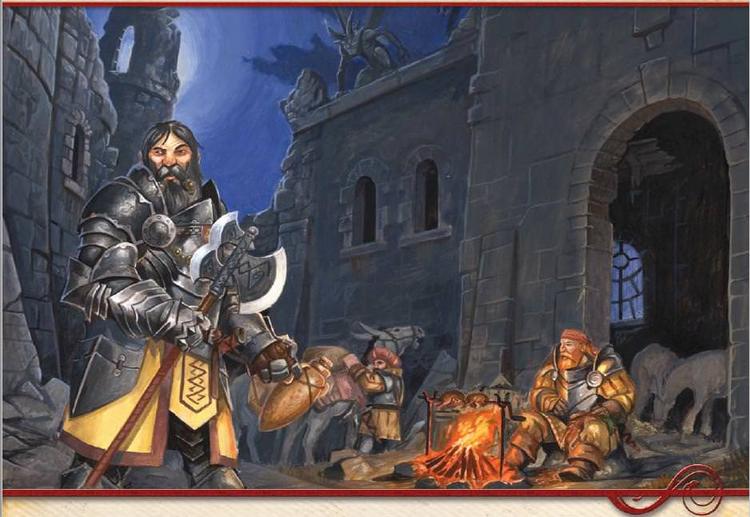
The dwarves of the Ironcrags organize into socio-political units known as cantons which center around a major settlement which has existed for at least a century. Although there are 13 presently the number of cantons fluctuates throughout generations as old ones fall, incorporate their neighbors, or break up into smaller cantons. They are autonomous, with their own customs, laws, and coats of arms. Like Zobeck the dwarves choose their own rulers rather than an hereditary aristocracy. The Bundhausen canton is the most open to outsiders and home of the yearly Dwarfmoot, making it one of the most politically powerful. Grisal's territory is claimed by both the Duchies of Dornig and Morgau, although the devoutly-religious dwarves put up a good fight in keeping the undead at bay. The Gunnacks are born travelers and lack not for natural resources. Kubourg's territory centers around a well-defended castle with extensive underground chambers. Hammerfell is named for its peerless artisans who produce famed magical runic Hammershields. Tijino is a gathering point for mercenaries who broker deals with southern cities to march to war. Finally, Wintersheim is home to a famed ranger society, the Order of the White Wolf, and shares many cultural traits with its Northlander kin. They even have a resident friendly white dragon named Hrothvengr.
We get a look at some minor cantons who each have a unique theme to set them apart. For example, Bareicks are impoverished berserkers, while the canton of Templeforge has a holy shrine where they create airships. Our section on the Cantons ends with talk about lost halls and ruins.
The Magdar Kingdom
The Magdar Kingdom is your stereotypical Goodly-Good Knightly Realm. The Toussaint to the Witcher's Temeria, the Minas Tirith to Tolkien's Mordor. It is a monarchy where two major knightly orders serve Khors, god of light, sun, and justice; Lada, goddess of healing, love, mercy, and dawn; and Perun, god of war and storms. It is a stable realm in spite of regular skirmishes with the Mharoti Empire. In fact it is due to this regular warfare that the Magdars perfected the creation of iron-reinforced war wagons capable of linking up to serve as mobile walls and fortresses. Its cities are glorious fortified affairs, from the beautiful capital of Cronepisht, to Khorsburg whose white-golden marble cathedral is the site of many pilgrimages. Wizards help local industry in the creation of region-famous wines and whose war-mages reinforce military regiments. We get detailed descriptions of cities (who tend to center around a single economic aspect like brewery or smithing) and reinforced castles and citadels.
METAPLOT: King Stefanos and his eldest son Zsigismond died at the battle of Marroc's Stand. This was a joint operation between their country and Illyria against the Mharoti Empire. Unfortunately it failed, causing the Mharoti warbands to go south and conquer the latter country. Now Queen Dorytta sits upon the Madgar Throne, grieving at the loss of her family yet redoubled in her efforts to repel the draconic threat.
We get detailed descriptions of the two knightly orders: the Order of the Undying Sun is a military regiment supplemented by divine spellcasters of Khors and Lada, and whose paladins of the former god comprise their most elite units. The Order of the Storm is a mostly-cavalry order who worship Perun and have a bit of a rivalry with the Undying Sun. Both knighthoods were allied to House Stross and as such are not well-liked in Zobeck. However a mutual defense pact between the kingdom and the Free City against the Mharoti Empire shelves these hostilities for now.
Perunalia
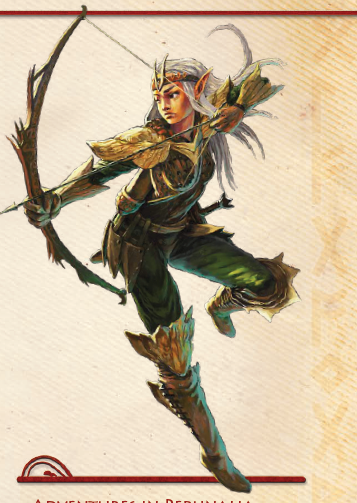
Also known as the Duchy of Perun's Daughter, this nation controls land and trade routes on the shores of the Ruby Sea. It is also a matriarchal society ruled by the demigoddess Vasilka Soulay whose very father is the god of war and thunder. It is a major center of lore and education, and the royal palace's library is open to the public one day a week. The Duchy is also a matriarchal society, where men are viewed as too driven by emotion and baser urges to be trusted with government and defense. Manual labor is considered the only proper venue to temper their impulses, and they are limited in rights in education, property ownership, and handling of money. The rest of Midgard, which is mostly a patriarchal setting in government and social mores (the bulk of Mavros' clerics are men for instance), finds Perun a strange culture at best or "shameless women" to be carried away in war and taught their place at worst. Perunalia is also known for producing peerless archers, and virtually every girl is gifted a bow at age 14 as a rite of passage. Villages and cities alike host archery tournaments for them to test their skills.
Personally, Perunalia rubs me the wrong way. Midgard has a tendency to write up cultures which have oppressive traditions yet whose inhabitants are not necessarily stereotypically evil: Zobeck segregates of kobolds as an example of their hypocrisy of self-determination, and in spite of some legal protections the Ironcrags' slavery system breeds a lot of resentment. But in this country's case the overwhelming majority of NPCs in government are good-aligned, and quite a few of them are paladins to boot! I am reminded of the debate over Paizo's handling of Erastil, a Lawful Good nature god who was fond of traditional gender roles for women. This ended sparked a most idiotic debate among players over whether systemic sexism can ever be "good." Although Perunalia does not have the same bad taste as Erastil in that almost every society IRL is patriarchal and thus does not commonly map to "lived experiences," it still feels weird.
As for cities and towns, Perunalia was historically part of elven rule and much of its architecture preserves this style. In some cases cities still retain their elven names. The Storm Court of Perun is a floating fortress and literal home of said god which visits the city of Orkasa once a year. However its presence can no longer be commanded by the Duchess: theories as to why include divine disfavor to the god's distractions from other wars and prayers committing his time. The Summer Gardens of Queen Osilessi was once a planned elven city of arts which sat at a shadow road nexus, but during the Great Retreat it has now become a ruined city haunted by griffons, drakes, and various monsters of the briars. Even a detachment of Mharoti soldiers where unable to claim it, and the surrounding forest is guarded by a group of armed bandits led by an elven enchantress known as the Apple Baroness.
METAPLOT: The Electoral Kingdom of Krakova, along with the Principalities of Morgau and Doresh and the Cloudwall Mountains, were once counted as being part of the Crossroads region. But after the former's invasion by the latter they are now one greater kingdom which is covered in the next chapter.
Thoughts So Far: The Crossroads are perhaps my least favorite region. It is way too close to cliche fantasy tropes from Chivalric Knightly Realm to Dwarven Mountain Kingdoms. The regions I enjoy the most, Zobeck and the Margreve Forest, really shine in their own sourcebooks but whose entries here are too brief to show off their most unique features. Ironically, Zobeck's use of certain titles such as burghers for wealthy citizens and hussars for elite military units make it the most authentically Central/Eastern European realm in comparison to the other nations. At times the chapter reads like a medieval economics survey where there's more focus on common trade goods for companies and cities in lieu of interesting adventuring opportunities in said places.
Fortunately things get a lot less bland in the next chapter where we cover the Dark Kingdoms! Vampires, ghouls, and gnomes, oh my!
Dark Kingdoms
Original SA post
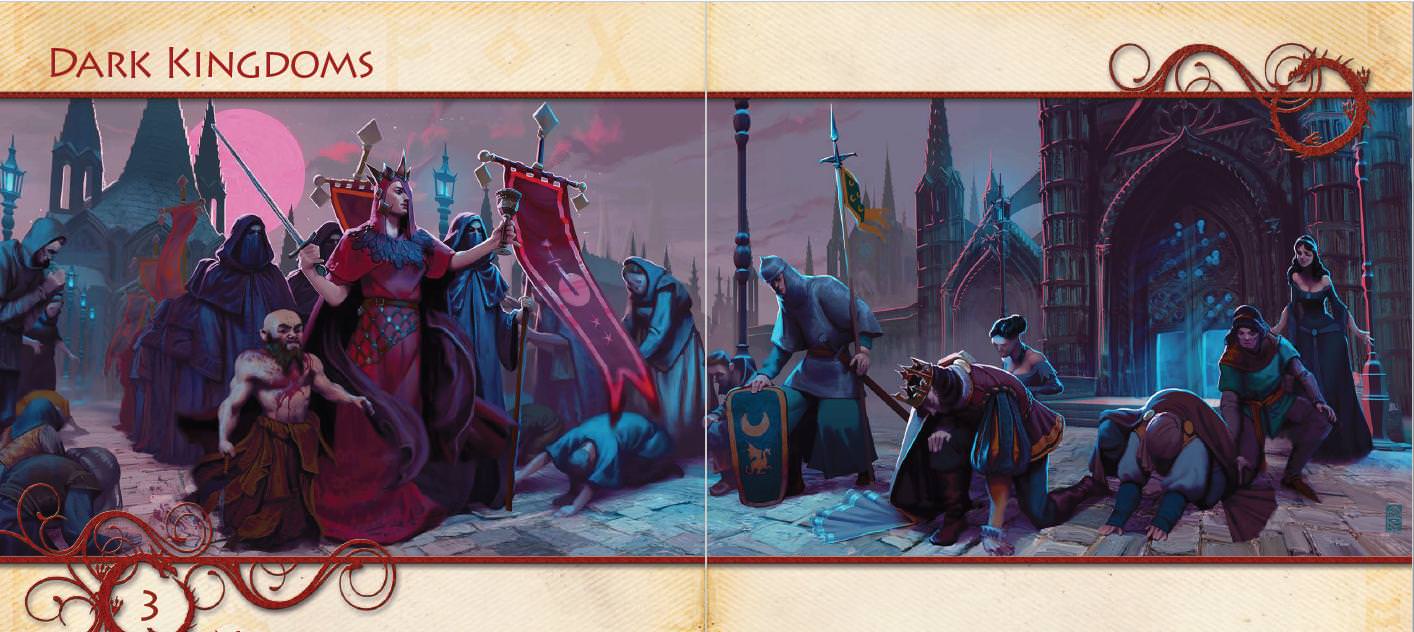
Northeast of the Free City of Zobeck and past the perilous woods of the Margreve Forest lies a realm of darkness. The twin Principalities of Morgau and Doresh were once feudal realms like so many others. But now an undead aristocracy of vampires rules over the land exacting taxes of blood and coin from an oppressed populace. Politically separate from them is the Ghoul Imperium, an underground kingdom stretching from beneath the Ironcrags up to the former Electoral Kingdom of Krakova. The new province of Krakovar was once a realm whose King was chosen by vote among the noble families, yet its government was overthrown by a joint effort between tunneling darakhul troops and the vampire kingdom's Order of the Knights Incorporeal. Temples to Marena the Red Goddess and evil gods abound, and the vampiric aristocratic structure is a hierarchical pyramid of sirers and their spawn. It is not unknown for enterprising slaves seeking undeath to hire assassins to kill their would-be master once the blood-draining's complete so they can be undead and free.
We open this chapter discussing the power groups of the Blood Kingdom: King Lucan (formerly Prince Lucan) is the most powerful monarch and the one who masterminded the overthrow of the living rulers 300 years ago. After that we have various noble families favored by Lucan and/or sired directly by him who tend to be managers of armies and large fiefdoms. Below that are administrators of smaller territories, and some can be darakhul or even prominent humans in addition to vampires. The Order of the Knights Incorporeal is the elite military arm of the Blood Kingdom's armies. The noble titles use Slavic descriptors, such as "voivode" or "voivodina" for generals or governers, and "gospodar" or "gospoda" which is Slovenian for "lord" and "lady" respectively.
The Church to Lucan's State is the priesthood of Marena the Red Goddess, who has an aspect as a deity of death as well as one of lust and fertility. Marena's church has various female-focused social orders collectively known as the Blood Sisters, such as the Cantri Abbey which safeguards pregnant women and the Temple of Aprostala which is a pilgrimage site home to many violent sacrifices. The Blood Sisters are spreading their influence beyond Morgau and Doresh by setting up secret temples in good-aligned cities posing as brothels, where they gradually gain new converts with members-only orgies.
You know, between the Northlands' Trotheim chapter and this, I'm beginning to see a theme of fiendish prostitutes in gaming material.
METAPLOT: Originally the vampires' relationship with Baba Yaga has been complex where the witch would sometimes aid them, but she mostly stayed away from their realms. However, the Greater Duchy of Morgau established friendly relations with the gnomes of Niemheim, who are enemies of Baba Yaga. As of now the witch has not acted openly, but the queen-in-exile of Krakova is seeking to align with her against the undead; nothing has come of it so far, as her chicken-legged hut is notoriously hard to find even for her spy network of "mice."
Lay of the Land
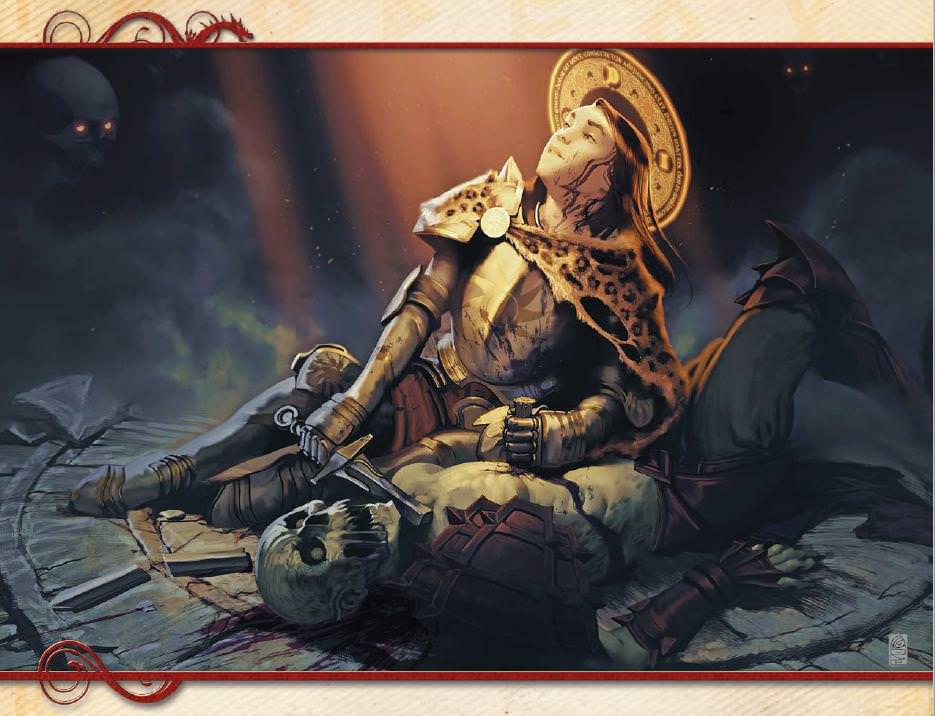
The Blood Kingdom of Morgau is made up of three former kingdoms: Duchy of Morgau, the Barony of Doresh, and the newly-gained northern province of Krakovar (formerly the Electoral Kingdom of Krakova). The first two kingdoms are gifted with forested highlands, and the Cloudwall Mountains to the east and the Margreve Forest to the south serve as natural defenses. Mist is common at all times of year, and the fields are richly fertile and the woods abound with game. Bratislor is the capital whose grim castle has a no-living policy. This changes during each solstice, where 100 unlucky citizens are invited and only one person ever leaves alive with their eyes and tongue gouged out. Hengksburg meanwhile is the most stable city and center of the Blood Kingdom's slave trade. The cult of Mammon is growing among the merchant class, and its undead Lord Mayor Rodyan demands a blood tax from each trader. Rodyan is also infamous for having a thing for teenage girls, and has went through 300 wives as he invariably ends up killing them during sex.
METAPLOT: Recently a vampiric hunting party captured Dajan Savirne of Clarsaya, a 15 year old girl of Perunalia who is already an accomplished archer. She is going to be presented to Rodyan as an "amazon bride." Enraged, the paladins of Perunalia mounted a failed rescue mission through the Cloudwall Mountains. After only one survivor came back, they instead are focusing on strengthening the borders against further vampire raids.
So there's a recurring element in this chapter of sexually predatory people in power. Beyond just the above example there's an example of Koschei the Deathless who arrives at King Lucan's balls with a new frightened woman in each arm; a satyr King of Rags who marries the daughter of the Lord of the city of Twine on her 16th birthday each generation as part of a fairy-tale style pact and whose lord seeks an end to this tradition; additionally the satyr's own daughters are drunkards who angrily attack those who refuse their sexual advances; the High Priestess of the Temple of Aprostala imprisons and sacrifices pilgrims who refuse to have sex with her; and the Cloudwall Mountains is home to ogre warbands who kidnap travelers to take as slaves and mates. I'm not going to complain of just one example in a book, but when you have five or six within the very same chapter and two of them involve victimized adolescent girls, I can't help but picture this as lazy writing for shock value.
Vallanoria is a military city which is home to Marena's warlike devotees in the Temple of the Scourging Goddess. The town brutally crushed several rebellions, and there are rumors that the crows who fly about are disguised secret police.
The Wendestal Forest and the Stale Wood is administered by Lady Chemaya, a lich of dubious loyalties whose alliances among the vampires shifts as often as she changes robes. The Stale Wood is a dark, cold place where no sunlight pierces through. The only true authority here is the King in Rags, an 8 foot tall satyr whose very presence corrupts the surrounding land in rot.
The Cloudwall Mountains is the private hunting grounds of King Lucan and his favored servants. It is home to many dangerous monsters from two-headed eagles and rocs to ogres and yeti. Criminals and unlucky people picked out as human prey to hunt are sometimes let loose in the mountain range. Any lucky enough to make it over to the Rothenian Plains to the east earn their lives and freedom, although precious few complete the harrowing journey.
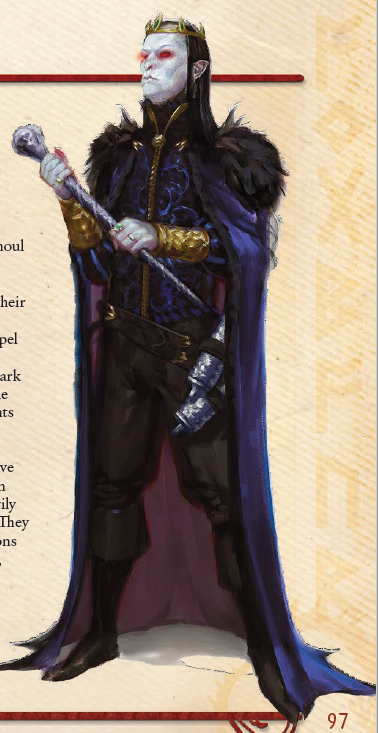
We get a half-page sidebar discussing the Ghoul Imperium. The wide-ranging nation is a vast connection of tunnels and caverns whose geographic center hosts Darakhan, the White City. Many underdark races such as dark creepers/stalkers, drow, derro, dwarves, and svirfneblin are conquered subjects. They have either joined the undead legions of the darakhul ghouls or were spared so that they and their descendants can act as cattle. The undead immunity to exhaustion means that army legions can travel 48-72 miles a day on foot (depending on the weight of their armor), and unintelligent zombies are used as "army rations" instead of the delicate nature of living cattle. It is only due to the ghouls' aversion to sunlight that they have not made inroads into the surface world, save their alliance with Prince Lucan against Krakova. The 2012 edition of the setting treated the Empire of the Ghouls as its own country entry, with some brief detail on its cities. These aspects are excised, although the entry was one and a half pages long so it's not a big cut by any means.
Castle Lengrove and the Great Necropolis house the last tombs of the pre-Lucan nobles, a testament to what has changed. There is a large cavern opening to the Ghoul Imperium nearby which both countries use as a trade network. Leander Stross (recognize that name?), the darakhul ambassador to Morgau, lives here. Before moving on to Krakovar we have some discussing on the Grisal Marches and the frequent wars against the dwarves of the same-named Canton; Cantri Abbey whose safeguarding and helping of pregnant mothers is perhaps the Red Goddess' only positive social service; Temple Aprostala and its pilgrimage rites; Fandorin Keep whose has a secret portal to the famous Stross Library in the ruined Castle Shadowcrag; and the Blood Vaults of Sister Alkava which is a published dungeon crawl whose new priestess found a novel yet gruesome way of preserving extracted blood.
The Province of Krakovar once chose its own kings. But now Lucan appointed Princess Hristina, Grand Marshall of the Ghost Knights, as the ruler of the newly-occupied territory. The landholding nobles known as the Slahta are still living yet forced to tow Hristina's line after she made several bloody examples of those who resisted. The old temples of Wotan and Perun were razed and converted to shrines of Marena and Mavros. The Ghost Knights have their work cut out for them here: Krakova's old spy network known as the "mice" are active and making alliances to stymie their occupiers, and a group of reaver dwarves from the Northlands established a new territory known as the Wolfmark in its northern coast. What's more, Krakovar's population is 7 times that of Morgau and Doresh combined and all but young children remember the days before unliving tyranny. Trolls and Khazzaki raiders care not for the change in administration and raid the eastern border.
Krakova, City of the Mermaid is still open to trade. Reminders of its past glory, from the Assembly Hall of Magnates to Mermaid's Island where each new king was voted in and crowned, fell into disrepair and were barred off-limits by Hristina. The World Tree Temple in the city of Varshava was razed to the ground, much to the dismay of many citizens yet whose burning fumes sparked magical gifts in those who breathed it. Gybick, City of Scribes, is famed for its book trade. Spymaster Velda Lupei of the Krakovan "mice" is hiding out here, having burned most of her organization's records to prevent from falling into enemy hands. Yet still she hid some precious volumes containing information about the most senior spies and rebel leaders in an extradimensional space. The vampires of Wallenbirg are fond of hunting fey in the nearby woodlands, which inevitably makes the peasants suffer as the fairies kidnap children and command swarms of mice to strip the granaries bare in revenge. The ruins of Yarosbirg Castle was home to a religious order of light and life dedicated to the goddess Sif. A shield maiden named Sister Adelind fought bravely against the Ghost Knights, managing to incinerate the vampire lord Otmar the Sallow with a shining spear. Although legions of ghouls killed her, she earned sainthood and martyrdom among Krakovans and others defiant of King Lucan's rule. Many secretly visit the castle to leave tiny wooden shields and white flowers as offerings.
METAPLOT: The entire section of Krakovar is pretty much a metaplot change. In the 2012 edition it did not have much in the way of internal or external conflict besides nobles jockeying for kingship. Ironically, Wallenbirg's relationship with the fey was still poor due to logging and the kidnapping/grain destruction methods of punishment were still the same. This time however it's the vampires' fault. If anything, the metaplot made this country a lot less boring!
Our final entry for this chapter are the Nine Cities of Neimheim. A long time ago the gnomes were friendly folk: they taught humans the art of magic, eager to discuss the finer points of mundane occupations, and traded with the people of Krakova. But 200 years ago things changed for the worse when a gnome prince betrayed an oath to Baba Yaga. One by one gnome villages disappeared overnight as night-haunts, strigoi, and other servants of the witch hunted them down. The adult's beards were used for pillow-stuffing and the children cooked in her stew pots. The gnomish people seemed destined for destruction, but then a smoldering horned gentleman made a very generous offer to the King of the Gnomes.
Ever since the gnome kingdom of Neimheim has lived under a diabolic specter. Temples to the lords of Hell are everywhere and devils preside over their towns as wardens against Baba Yaga's forces. Niemheim's borders are protected by magical defenses known as glower stones: crude structures in the shape of hunching gnomes who smile at those allowed entry, but glower and in some cases unleash magical spells on those not permitted to enter the forest. Once a month the gnomes must make blood sacrifices; if no strangers come into their seemingly-comfy little towns, they must provide from among their own people. As a result gnome traders and illusionists visit roadside inns and taverns to trick people with rumors of wealth and glory beneath their pine boughs whose inhabitants seem harmless enough with their red caps and pointy-toed shoes. With every band of travelers or foreign raiders that disappears within their borders, the gnomes send out a new batch of high-quality knives, tallow candles, pottery, leather, vellum, and other goods their forest home is ordinarily incapable of creating on its own. Nobody questions its origins.
King Redbeard lives in a hidden palace in the Great City of Holmgard. His castle is a well-warded structure which can only be found when one receives an invitation: if such a boon is granted, the person wanders the streets at dawn until they somehow find their way to the front gates. Although an amoral snake-in-the-grass, the fate of his people is a heavy burden on Redbeard's shoulders. His greatest hope is to somehow make peace with Baba Yaga and save his kingdom from diabolical influence. His people are divided between wanting to pretend to live as normal a life as possible, and the other half fully embrace their encouraged evil.
METAPLOT: Redbeard's ace-in-the-hole is the Offering Bowl, a secret cauldron shrouded against devilish detection. Carved from the oldest trees, it is guarded by his most trusted and loyal servants and Unera, one of Baba Yaga's daughters who uses magic to hide its presence. Redbeard hopes that if the Bowl is filled with the blood of innocent mortals, this will make up for his ancestor's wrongdoing to the great witch.
MORE METAPLOT:It's not just Redbeard who is seeking loopholes. The unique invention of the Red Cap hat can shroud a gnome from Baba Yaga's eyes outside the forest proper by taking a bit of the forest with them. Plants, lichen, and mushrooms are packed into a linen scarf tied under the wearer's chin. As long as the flora within is fed and kept alive it will work, but the fear of losing it or having said plants die keeps all but a handful of gnomes from venturing outside Neimheim. Additionally, a blind gnome warlock by the name of Halivimar the Charred perfected a means of expanding Neimheim's borders: the planting of seeds brewing with foul magic can grow as much as 5,000 square feet of "sproutings" in less than a day. He's hired a group of scouts to plant these seeds across the Rothenian Plains and establish small enclaves.
As for specific areas, we have the corrupted World Tree of Suf, which is used by infernal travelers on business in Midgard and whose acorns can be brewed into a brimstone-infused liquor. The cities of Volvyagrad and Holmgard see a lot of trade from non-gnomes although said people rarely seek to stay long-term. There are brief mentions of lesser towns, such as Hexen rumored to be home to a college of witches and wizards or Königsheim which has a temple to Chernobog home to an order of anti-paladin cavalry known as the Hellspurs.
Thoughts so far: The "evil kingdoms" of Midgard are interesting places full of story fodder. The many factions, from vampire nobles to dwarven reavers and Krakovan spies, provide ample factions for PCs to ally with or turn against each other. The gnomes of Neimheim have a twisted fairy tale aspect of malicious fey. Yet in spite of the influence of devils there's a significant portion of their populace privately unhappy with the state of affairs and can make for an interesting PC exile concept. My only real complaints with this chapter is the repetition of weird sex stuff.
Join us next time on the Rothenian Plains, where we explore the oft-unused fantasy counterpart cultures of the Eurasian Steppes!
Rothenian Plain
Original SA post
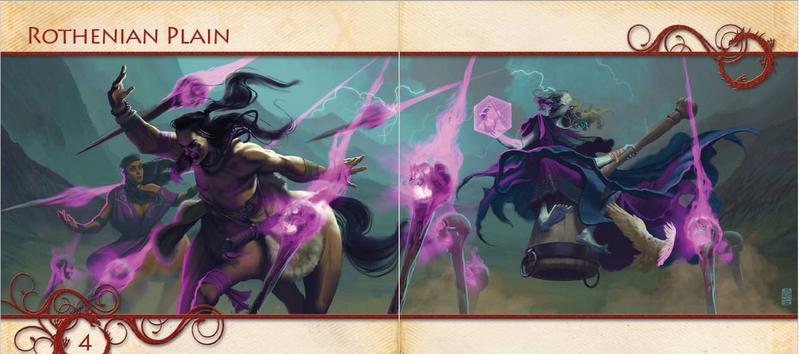
The Rothenian Plain is a huge open grassland of the east whose size dwarfs all but the largest of empires. The nomadic way of life is the norm here, and the only standing proper nation is the poor but proud Kingdom of Vidim. The steppes are the favorite stomping grounds of Baba Yaga, who plays the various factions against one another from year to year. And beyond are the mysterious lands of the Utter East who have yet to be detailed in any sourcebooks.
Our first entry is not a nation or culture, but on Grandmother Baba Yaga herself. She's one of the major power players of Midgard, and although not a deity herself kings and gods alike treat her with a mixture of respect and fear. There is just as much fact known about her as folktales, and it's not uncommon for scholars compiling books about her to have the ink on their pages vanish or turn into paper-eating worms. But Baba Yaga's knowledge is boundless, from the last thoughts of the dying star Tovaya to the Words of Unfounding which can never be spoken lest they unseat the gods. She is willing to part with her unmatched knowledge for a high price, which usually takes the form of a fairy tale-style quest or sacrifice such one's own final breath. She lives in a mobile hut with enormous chicken legs capable of leaping in mile-long jaunts, and the interior is supernaturally large with all manner of rooms.
Baba Yaga has an unknown amount of daughters, all beautiful fey known as vila. They too are powerful in the magical arts and have their own (albeit smaller) chicken-legged huts. It's not uncommon to see them cavorting in the halls and palaces of Midgard's nobility where some have the lord's ear. The less witting servants of the great witch are mystics who went mad from the knowledge imparted by her and who look for her influence in signs and portents. In addition to lore, Baba Yaga has a secret garden with unique ingredients capable of healing any affliction, tended to by mindless slaves who angered or failed her along with earth elemental guardians. But her most famous minion is perhaps Koschei the Deathless, a wicked immortal whose soul is embedded within an egg hidden inside a duck, which is nestled within a hare that rests within a goat. The egg's destruction means Koschei's destruction, and so Baba Yaga keeps the goat's location hidden to make Koschei do what she wants.
METAPLOT: The kingdom of Domovogrod was the only other sedentary culture besides Vidim upon the plains. It was founded by Sivinvoya Vellaraya, a silver dragon who cared not for the Mharoti Empire's political goals and instead journeyed north to settle near a World Tree known as the Winter Tree. He taught the surrounding humans advanced farming and healing techniques to found the kingdom of Domovogrod. Although the dragon is long-gone, his human descendants ruled in his example. But now the kingdom's overrun by ogres, trolls, and giants of the Northlands, its capital city claimed by a gluttonous warlord unable to rise from his very throne. The Winter Tree now sits unattended beyond a small band of winterfolk druids and rangers. The last human bastion is a small town of fur-traders seeking vengeance against the giants.
Khanate of the Khazzaki
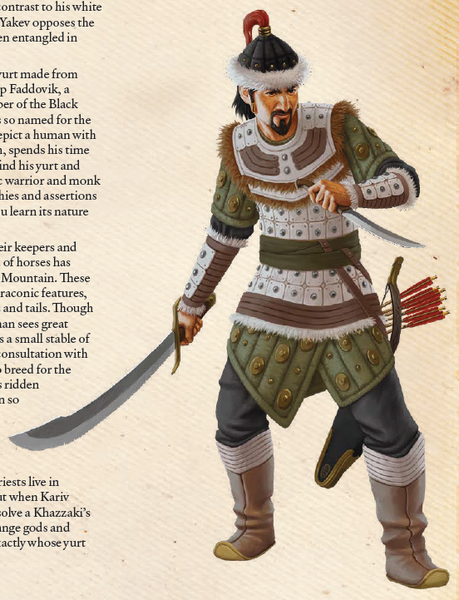
The Khazzaki are a band of human and centaur nomads who live as horse and ox herders, warriors, and occasionally farmers. Their settlements are tent-like yurts, their leader is a Khan who has a military-like hierarchy of generals and soldiers spread among the clans. Although they have traditional lands, they are a far-flung people who can show up anywhere from the Crossroads to the Utter East. They warred against the Mharoti Empire, and Khan Bodhan Zenody is prepping for an all-out assault on either them or one of the greater nations for loot and glory. After successful raids and campaigns it is customary for Khazzaki to travel to the Red Mounds of Rhos Khurgan, a set of 32 burial mounds created by a forgotten race. One of the mounds is cursed and thus avoided. The Khazzaki treat them as sacred sites and pour wine on their soil as offered drink. For unknown reasons divine magic is warped and stymied around the mounds. The Khanate's closest thing to a proper city is Misto Kolis, which is more akin to a traveling carnival and has a sizable Kariv population.
METAPLOT: One of the greatest scourges of the Khanate recently is not war but a disease afflicting their horses known as the Black Strangles. It spreads fast and affects even centaurs, and the Khan is hoping that a mysterious group of allied druids known as the Grassweavers of Perun may discover a cure. There's also individual tents of great fame, such as the Yurt Monasteries home to sorcerer-priests of obscure gods, the Black Wagon whose doom-saying oracle is a bad omen to encounter on the plains, and the Krasni Yurta whose wizard occupant enchanted its silk to be as strong as steel along with a pocket dimension only he and his guests can access.
We finish this section with mention of the Khan's Three Great Treasures: Draugir the horse who only lets the true khan ride it and was won from Koschei over a riding contest; the An'Ducyr bow which was forged from the heartwood of a World Tree which grants magical sight to one who draws its bowstring; and the Dragoncoat, armor forged from the scales of a wind dragon which grants immunity to poison as well as enchantment and evocation spells of all kinds.
We have a brief sidebar on Demon Mountain, a sulfurous place of foul reputation ruled over by a tiefling archmage known only as the Master. He claims to be the noble scion of Vale Turog and lives in a palace of bones he can never leave, but sends all manner of mortal and demonic minions to scour the lands. Fun fact: as he fathered dozens of tiefling children he sent out into the world in order to discover a way to undo his imprisonment. As such he was presented as a possible backstory for tiefling PCs
Centaur Hordes of the Plain
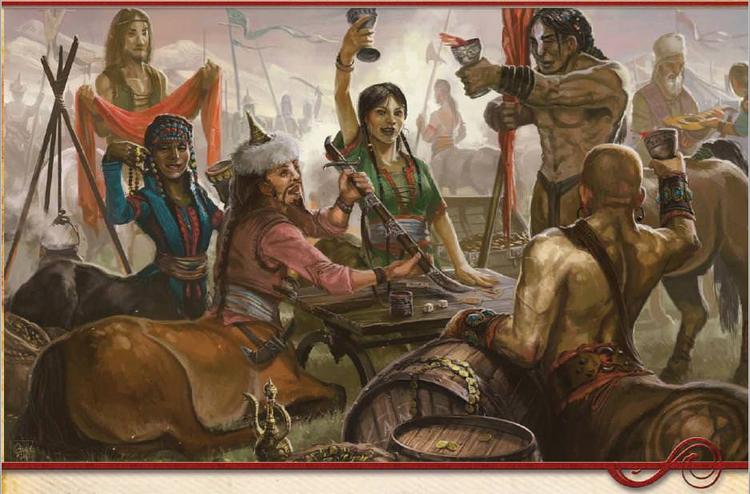
The centaur clans are individually small yet possessed of a mighty reputation. They are mercenaries of great skill whose services have been purchased with meager oats and cheese. They are fiercely independent and although willing to work for others almost never acquiesce to assimilating into sedentary cities. They believe that true freedom is found via a nomadic lifestyle. The centaurs believe that their creation was by the god Perun after his previous creations failed. Humans had the ability to craft great tools but whose bodies were too slow and weak, while horses were fast and strong but too dumb and herd-like to produce cunning hunters and great heroes. It was the mocking of his wife that convinced Perun to give it his all and create the centaurs, combining the best traits of his earlier creations.
We get a brief rundown of centaur culture: they herd goats and sheep and mark passage into adulthood when one can create and live in their own tent. They are nomadic but have favored locations to return to twice a year, and their mages are predominantly druids. Men are encouraged to be warriors and women are discouraged from journeying beyond the confines of their clan group. There is talk by the Chieftain of the Yendge Clan to unite the race under a single banner which the smaller tribes find amenable for strength in numbers. The Black Strangle disease is a growing plague among centaurs and known as the Long-Teeth among them. It causes their teeth to grow twice their normal size, makes the sensation of bright light painful, and causes excruciating pain to walk or stand. The final stage is the most dire, as it encourages the centaur to seek out others of their kind to bite and infect, now hardly better than a mindless cannibal.
METAPLOT: The Grassweavers of Perun created a herbal poultice to prevent the disease from reaching this final stage, although centaur and Khazzaki both seek a true cure. There is rumor of a remedy in the city of Trombei.
We finish this entry with a talk on centaur clan structure. They tend to be either steppe nomads, mercenary companies, or bandits, and all of them elect their Chieftains and war leaders via majority vote. The six clans listed here are the Dargit who are famed archers; Morav, whose bards' stirring odes strike inspiration into their allies and fear into their enemies; Ogol, a clan governed by druids who serve Perun and are on the hunt for the legendary spear Zonbol believed to be wielded by their god; Rhoet, a sadistic mercenary band with ties to Demon Mountain and the realm of Misto Cherno; Sarras, expert wine-makers; and Yengde, mercenaries and bandits who are famed for dual-wielding spears.
Kingdom of Vidim
Vidim's origins lie in a mutual defense pact between humans and huginn against dwarven and giant raiders. The kingdom makes the majority of its wealth through sea trade along the Nieder Straits, and most of its population are subsistence-based farmers known as serfs. Beyond the agricultural serfs are the boyars, nobles and vassals trusted with physical defense from foreign threats and local uprisings. Then there are the huggin, who act as a spy network who inhabit a rookery (impromptu ravenfolk neighborhood among a city's towers and multi-story structures) not far from the tsar's Scarlet Palace. The boyars and huginns do not trust each other, and the tsar is unable to quell the numerous duels and murders which crop up between both sides.
The Tsar's judgment is unraveling due to his madness, which is kept secret by his inner circle to avoid the loss of national morale. Although they do their best to guide him to wise actions, this is not always possible. There are those suggesting the eldest Princess ascend the throne, although she's devoted to her father and brooks no talk of deposing him. His palace's major feature is the skull of a Thursir giant slain by the current tsar's father and is considered a good luck charm by many.
We get brief descriptions of of three smaller cities of Vidim, as well as a natural feature of five pillars in the sea known as the Salt Fingers. The last one is so named because its foundations mysteriously bend and reform into new gestures on the eve of the winter solstice. Many astronomers, mages, and priests used to make pilgrimages here, but in recent times a group of violent merfolk sunk ships which get too close to the Fingers.
Our time in Vidim ends with a talk of the capital's temple of Wotan which is a labyrinthine palace, and those huginn who live inside it experience a strange molting of feathers: blue-black hues are replaced with silver and gold, quite often followed by dreams of the Storm Court. Nobody knows for sure whether this is a gift from Wotan, trickery by Loki, or some other god's scheme.
Wandering Realm of the Kariv
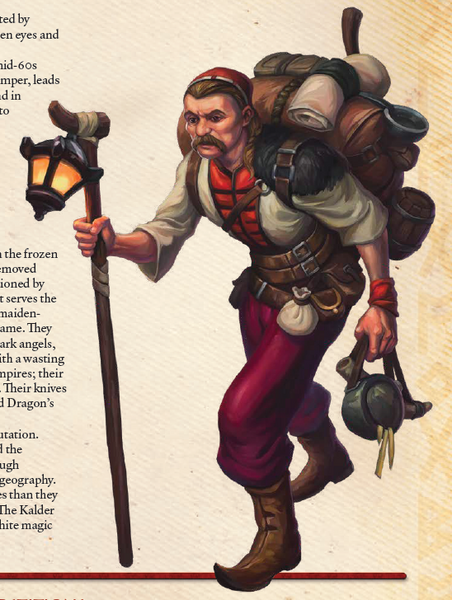
The Kariv are the other major nomadic ethnic group of the Rothenian Plains, although their travels take them to the Crossroads and other realms. They are more or less Hollywood Roma/Romani people: they dress in colorful clothes, are ruled by matriarchs who often have some form of magical talent, and are compelled to never put down stakes in a single location due to a curse afflicting their fertility if an individual stays in one place for more than several months at a time. The Kariv are divided into extended family units known as clans, although they have a king whose authority is weighed by every clan leader.
METAPLOT:The current King Iqbal Lovari has recently gone missing for unknown reasons. Due to this many accusations are going about, particularly between the Lovari and Gallati families. There's also the King's would-be successor, Sanash, a young oracle who is skilled in divination and believed to be prophesied to unite the clans and redeem the Kalders. Ruling in Iqbal's place are Sanchari and Innessa, a pair of twins who are actually two souls sharing one body, but a third evil sister is currently asleep within and unknown to all.
As for the curse affecting the Kariv, the Wander Curse is of unknown origins yet whose ultimate effects render the settler-to-be infertile. It takes place in stages, from a loss of creative arts and energy to having all their clothing and personal possessions fade into dull grey and brown colors. There is no known cure, and infertile Kariv are known as the Arrid who often resort to desperate measures such as dark magic to restore what they lost.
METAPLOT: Oddly, the description of the Kariv has changed over publications. In the 2009 Dwarves of the Ironcrags sourcebook, the curse of the Kariv more or less forced them into a nomadic lifestyle, which in turn caused them to be heavily distrusted and vilified by more sedentary and dominant cultures. They suffered extreme systemic discrimination, which in turn caused the Kariv to be resentful of outsiders and thus feel less moral compulsion in cheating them for money or hurting them for slights:
quote:
Spat upon and insulted, their children beaten in open streets, their women violated with little recourse in the law—it is small wonder the Kariv hold together so tightly. Confl icts are handled internally and outsiders are rarely trusted. Aft er centuries of abuse, the Kariv feel no remorse for taking full advantage of dechas, or nonKariv, at every opportunity. Kariv believe their cons, swindles, and robberies balance the scales in a world where they are denied the opportunities and fortunes granted others. Every time a decha wonders why a Kariv commits murder, the Kariv merely point to any of their recently lynched people and shrug.
Contrasted with the 2012/2018 description, the Kariv's anti-social relations are less due to institutional bigotry and more due to personal bitterness at their curse which causes them to lash out:
quote:
And yet, when the fires die down to embers and the shadows close in, the Kariv show their dark side. They drink and whore and gamble, the women as much as the men. They take chances that invariably lead to trouble; they cheat and lie to the Gadscho, their term for any who are not Kariv. And before the seasons turn, no matter how sweet the pastures or how warm the feather beds of a friendly host-town, they move on.
The Kariv travel because they must. Their curse is one from the fey and the Green Gods, some say, the result of a Kariv king’s betrayal of an oath to the gods. Or perhaps it is the result of a bad bargain struck with Baba Yaga—storytellers disagree on the details. What is crystal clear is that Kariv men and women who do not pull up stakes and move at least a few day’s ride every few months grow infertile and their line ends. The fortunetelling families cannot abide the thought. The proud, doting Kariv fathers and strict mothers have no patience for such a fate. And so they live on the road.
Both examples play upon the "thieving gypsy" stereotype, although the 2009 had a much more plausible cycle of distrust and prejudice between oppressor and oppressed. It gives ample fodder for both sides to play off of each other's resentments and keep the status quo, while also making the Kariv's resentment understandable for what has been heaped upon them. The current Kariv primarily steal out of misplaced anger, and I don't feel that this is an improvement.
We get a run-down of the eight largest Kariv clans: the Dakat, who are are horse traders rising up politically due to various shady dealings; the Galati, the closest the Kariv have to royalty and possess the best diviners; the Heph, who are patriarchal diabolists shunned by the other Karvis and allied with the Master of Demon Mountain; the Leanti, entertainers and bards who have a knack for thievery and castrate their prisoners...this last part is just thrown in their description with no context; the Lovari are the expert artisans and tinkers who are also prized as mercenaries; the Merceri, who are expert healers and worship angels, trusted for their hospitable demeanor and diplomatic skills; the Sergin, archers and trackers respected by others for their keen eyes and reflexes; and finally the Kalder, a mysterious clan who has many stories circling around them: some claim they were created in Baba Yaga's cauldron, others claim they are child-stealers and maiden-snatchers for Niemheim's gnomes, some say they are ruled by undead, etc. What is known is that they cannot produce diviners among their ranks, and their leader is a heartless man who exercises his power with violence and blackmail.
The final pages of this chapter detail three locations: the Thin Trail which is the least traveled place in the Rothenian Plain and known to grant visions of monstrous leviathans moving upon charred wastelands. In order to find it you must follow mundane directions but must burn something precious between four trees on a specific hilltop to continue the search. The Cloud-soaked Cliff is in the northern reaches of the Plains, home to the sacred forge of the Lovari clan. It is said that the god Svarog himself blesses their work, woken up by the hammering smithies. The finest creations are sacrificed to the god by being thrown over the nearby cliffs, while the rest of the tools are either kept by the clan or sold to other people. Finally, the Wandering Bazaar is a mobile Kariv marketplace which stops by Ingot Lake. Anyone with enough gold may open a stall and sell anything which will not bring trouble to the community. The Bazaar often hosts an annually fishing competition with a healthy sum of gold as the grand prize.
METAPLOT: The 2012 edition detailed the Windrunner elves, one of the three elven ethnic groups still present in Midgard. They are a nomadic people who broke off from the Arbonnese and organized into eight clans. They were known for the construction of windrunner kites, aerial gliders capable of lifting a human-sized rider into the air with a strong gust along with a trailing horse or oxen. Although not inherently magical, they are frequently blessed by priests of Ellel (one of Wotan's mask) for his association with the sky. The 2018 Worldbook mentions them here and there, but there's no in-depth write-up.
Thoughts So Far: Baba Yaga could have very easily ended up as a Faerun-style mega NPC in that she's ultra-powerful and has her hands in all manner of affairs. But given that her motives are unpredictable and it's mostly her minions who intervene, I think that this keeps her as a more Lady of Pain style character who isn't likely to steal the PC's thunder. My favorite parts of this chapter were the write-ups of the Khazzaki clans and the specific locations. It's not often you have a Mongol-style fantasy culture in a game unless it's explicitly East Asian. The specific locations such as the Thin Trail and Wandering Bazaar are good adventure fodder, and the missing Kariv king and a proposed centaur nation make for good political conflict. I feel that the Kariv are racially problematic, and the centaurs do not have much to individualize themselves from the Khazzaki beyond being a monstrous race (there are even Khazzaki centaurs). I am a bit sad that the entry for Demon Mountain was excised to a sidebar in this book.
Next time our travels leave the windswept plains for the grand cities of the Mharoti Empire, the most powerful nation in Midgard!
Dragon Empire and Eastern Lands
Original SA post
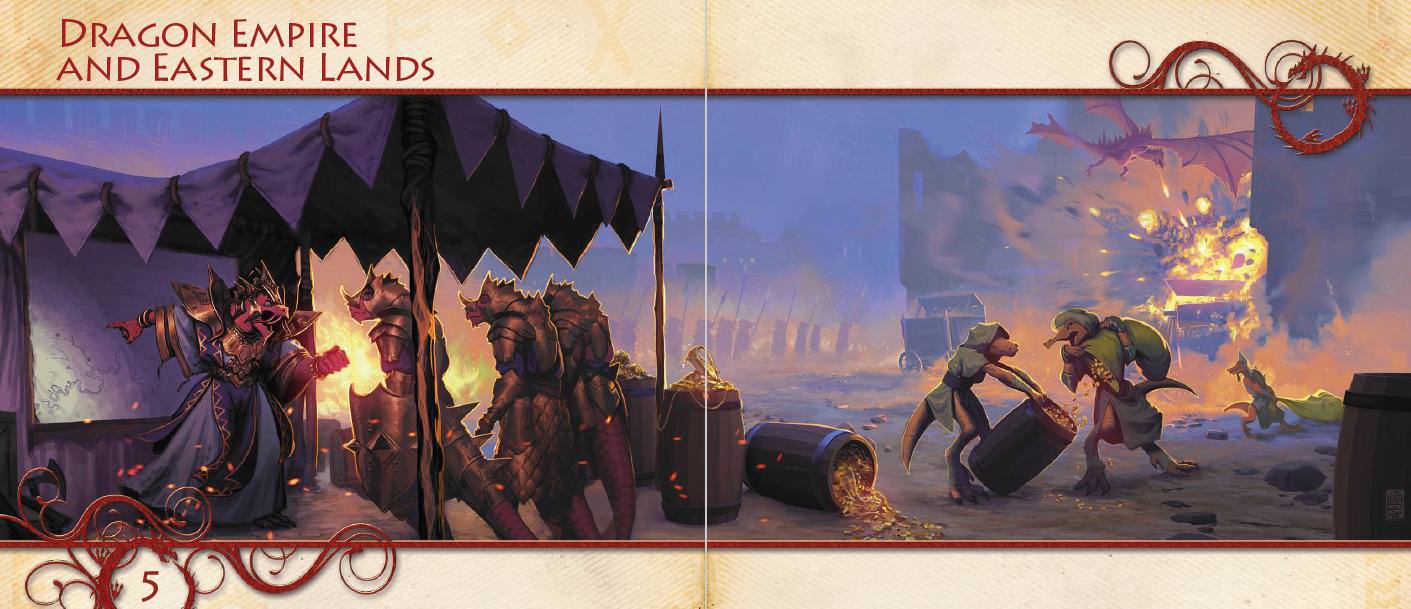
For some reason I think about the Ikana Castle music from Majora's Mask whenever I look at the above picture.
The Mharoti Empire is the largest country in the known setting of Midgard, both in land and population size.* Although a lot of their culture, titles, and religion are dragon-focused, they have an Ottoman/Arabian vibe with more than a few names containing the "al" prefix, marketplaces being open-air bazaars, as well as their emperor being referred to as a Sultan. The Mharoti Empire is an aggressively expansionist country, with propaganda teaching that dragons and the related reptilian races are destined to rule the world. Even many citizens away from the front lines are more than eager to support such campaigns as troops bring back much in the way of looted wealth. The newfound trade revenue flowing in from newly-claimed territories is just icing on the cake. For most of the 400 years since their founding, things only seemed to look up for the Mharoti. However the dragons are biting off more than they can chew: they are making way too many enemies too fast, fighting simultaneous war fronts in Ishadia, Khandira, and the Magdar Kingdoms not to mention the ongoing pacification of the newly-conquered Illyrians. Diplomats from Nuria Natal and Zobeck are forging mutual defense pacts with other city-states and nations, and there's a fair chance the Khazzaki tribes may invade. Anti-dragonkin pogroms in Capleon are being used as justification for a campaign against city-state, and there is talk the Mharoti might invade Nuria Natal next as their first foot in the Southlands.
METAPLOT: The Nurian alliances and Capleon riots are metaplot things, but perhaps the biggest change is the crowning of a new Sultan. The previous Sultana was Casmara Azrabahir, a human woman with draconic blood. A violent coup was raised against her due to recent military failures in the Seven Cities and Khandira. Such losses resulted in the deaths of tens of thousands of soldiers and an their dragon generals. She managed to take refuge in the Republic of Valera in the Seven Cities. Now for once in its history, a dragonkin and not a human sits upon the throne, Ozmir al-Stragul. Although he's proving to be a competent ruler so far, millions of Mharoti humans worry about their last great point of pride being taken over by their fellow reptilian citizens.
*For an overview of their might, the Empire's population is 48 million (47 of that 48 dragonborn, humans, and kobolds) and its far western reaches are in Rumela, with a vassal state of Parthia in the east. Semi-related. There's an official interactive map of Midgard here. No other country comes close to the sheer manpower of the Mharoti. I made a list of most populous countries in the sourcebook after the Empire: Muria Natal at 13 million, Ishadia around 9 million, the Greater Ducy of Morgau, Doresh, and Krakovar at 4,356,000, and finally the Grand Duchy of Dornig at nearly 4 million. Most countries and city-states can barely push one million if they're not in the low hundred-thousands, and Dornig and Morgau are both influential enough to get their own chapters. In addition to airborne dragons and magical troops, it's not hard at all for the Mharoti to throw in human (and dragonkin) waves as a tactic to overwhelm smaller armies, and in most cases this works.
Before diving into the imperial provinces we get a run-down of the Mharoti government structure. The empire's divided into provinces ruled over the most powerful and noble of dragons who have some degree of sway over the Sultan, while the Sultan (who cannot be a dragon) administers day-to-day affairs and commands the army. It is a species-based caste system: the bottom caste is the Jambuka, anyone who is not a reptilian and comprise mostly low-class laborers and servants. Above them are the Kobaldi who more or less fill the same social role as Jambuka, save they have an inflated sense of superiority for being "dragonkin" and control most of the mining and weaving guilds. Sekban are the lowest ranks of dragonkin (dragonborn and dragon-blood humans) who may be more skilled laborers. Edjet are military units of dragonkin who are raised to fight in a variety of ways from magic to martial might. Akinji are minor landholders and administrators who serve as officers and skilled troops in war. Timarli are the nobles and include dragons, drakes, wyverns, and related species who can range from owners of large farmlands and guilds to high priests, gentry, and generals. The Urmanli are 500 of the most well-connected true dragons. Finally are the Morza, nine Great Dragon Lords who administer each of the Empire's provinces, act as advisers for the Sultan, and are drawn from the ranks of the Urmanli when one of them dies. Finally we get a full-page sidebar discussing the make-up of a typical 30,000 Mharoti Legion, along with a list of troop types by caste and their roles (archers, infantry, air support, etc).
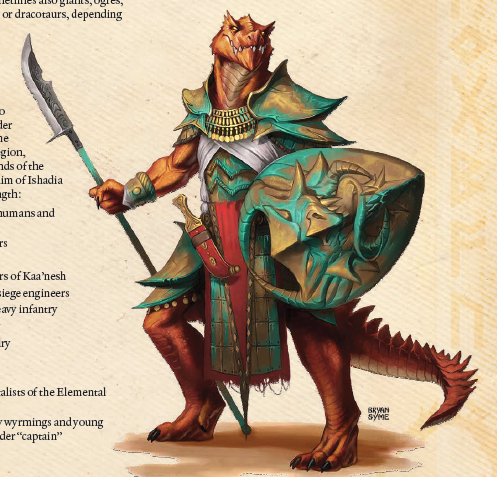
We have a sidebar about the Dragoncoil Mountains, a natural feature dominating the central Empire. The region's strong in ley line magic, a great resource which enhances the imperial spellcasters' magical projects. Now we get into the Provinces and the Morza, describing not only the land but also its ruler's relations and ambitions. Our first province is Gizmiri, a wasteland of red desert whose only major industries are mines and coastal fishing. The provincial capital of Sarkland is a trading hub famed for its magical carpets, and the Morza Ateshah's mere fiery presence causes nearby land to change into desert. Ateshah's secret goal is to research ancient knowledge to spread this across all of Midgard, which needless to say won't sit well with the rest of the Empire.
Satarah al-Beldestani is the morza of Harkesh, although she wasn't always a true dragon. She was once a dragonborn paladin who ascended the Sky Stairs of Beldestan and returned transformed into a star drake. She's one of the more hawkish morza, seeking an all-out war with Nuria Natal which even by the sultan's standards is regarded as foolhardy. Harkesh is the capital of the Empire proper and is known as the Golden City. It's a trade hub where even merchants from enemy countries come: commerce and coin knows no national allegiance. We get a full-page map of Harkesh along with brief descriptions of various interesting locations, such as the Four Pillars of Wisdom which engage in ritualized rival school street fights with each other based on one of their god Azuran's directional winds.
Although the Empire's founder Mharot is still alive and kicking, he is not one for politics anymore and is content to be ruler of the rural mountain province of Kalpostan. He spends most of his time sleeping but on rare occasions he speaks the Words of Transformation to ascend kobolds and dragonkins to the next higher form in the caste system.
METAPLOT: A human soothsayer known as Enver Demir Demir al-Kaa'Nesh has the ability to read the dreams of Mharot, which he uses to relay his proclamations to the other members of his court. However al-Kaa'Nesh is getting up there in years and there is worry of who, if any, is trusted enough to replace him. The city of Kaa'Nesh is known for its blood mages, who found a way to grant magical ogres tattoos to drain the life force of those they wound in hand-to-hand combat. Due to this they make for valuable shock troopers.
Ibbalan the Illustrious' claim to fame is being the eldest ruling morza thanks to a sacrifice to the god Baal. Now his very spirit possess his own treasure horde and capable of forming into a dragon-like form of coins and jewels. He oversees Mezar Province, secured on a vital trade route between the eastern and western realms of Midgard. It has two capitals based on the season, while Ibbalan's home city of Irkaly is home to the Elemental Academy which trains many edjet war-mages and timarli.
Lashmaraq Talshah rules over Hariz Province, the easternmost realm of the Empire. She's a ruthless taskmaster and perfectionist, having spent decades to build an elite army one day capable of extending territory into Khandira and Beldestan. The other Dragon Lords fear her for her spy network and as such hope she remains distracted enough in this remote region. The province is mostly unsettled and poor, and the numerous nomads and Khazzaki raiders make enforcement difficult at best.
Parsis the Hidden is the ruler of Betik Province and one of the two only golden dragons in the Empire. He is not one to delegate and loves to shapeshift into dragonborn and non-reptilian forms to take a "hands-on" approach of surveying the state of his province. The region is home to the Empire's greatest centers of learning; the Hidden University is notable for allowing entry to anyone capable of passing the exam's skills regardless of their race or economic status. The region is riddled with invisible castles and fortresses in the clouds, and its ley line-enhanced scrying is used to give directions to the Empire's armies and various other grandiose tasks.
Rüzgar is a simple cave dragon. He cares little for governing Zaldri Province, his favorite thing instead to pit his armies against great foes and eat the greatest among the opposition. He gets on with the current Sultan in trading war stories and hypothetical invasions. His province is lightly populated, and its proximity to the borders of Perunalia and the Magdar Kingdom mean there are always legions patrolling the border.
Marea Province's morza Yiraz Azah is unique in more ways than one. She's the only morza not from the Dragoncoil Mountains region, instead hailing from an unknown realm in the North. Yiraz prefers a honey-over-vinegar approach to imperialism, suggesting that future realms should be voluntarily absorbed via mutually-beneficial treaties, although this was before she became morza. She still talks the talk, but commits military forces against the cities of Kyprion and Triolo under self-justification that she would be a fairer ruler than the other morza. Her province is an exception in that dragonkin and kobolds are in the minority, and she tolerates local religious traditions outside the dragon pantheon.
METAPLOT: The religious tolerance has come to a violent end when priests of Seggotan were believed to be organizing a rebellion after they started occupying and restoring abandoned temples. The Mharoti soldiers' murder of these overwise-peaceful people has only served to martyr them among the populace and inflame local resentment.
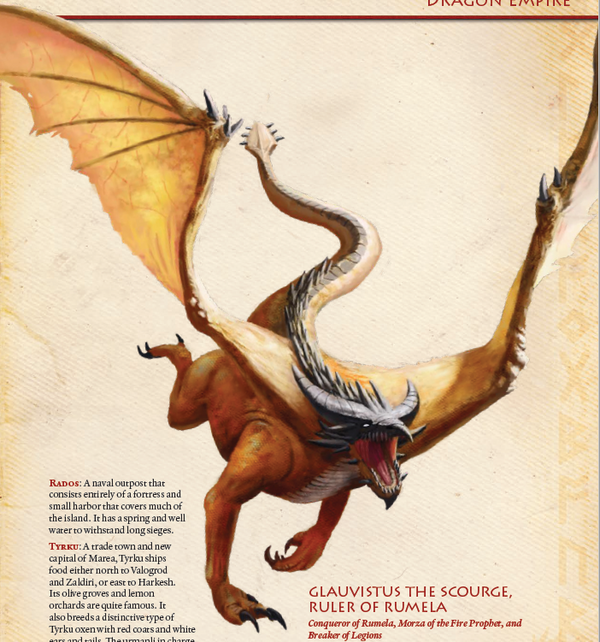
Rumela is the newest territory of the Mharoti Empire, formerly the Seven City realm of Illyria. They lost a long and taxing war with the dragons, its noble families fled to other cities, its Duchess chained to a massive stone block. She is kept alive by food and magic for all citizens to see how low their former leader fell. The Mharoti Empire is investing heavily in farm and pasture creation to recoup their losses along with rebuilding the capital city and palace. The latter especially to be more "dragon-friendly" in accessibility. Illyria/Rumela's non-dragonkin populace are awash with anger and depression over their loss. Many would-be rebels still lie rotting in mass graves and the remaining noble families are pitted against each other by the ruling morza to prevent them from reaching a united front.
Glauvistus was the general responsible for the country's subjugation and is now its new morza. She is is intentionally making laws and taxes crueler to "drive out the rebellious spirit of risky citizens" in the belief that killing them right then and there will help subjugate the last threats to her rule. The White Mountain Marches are perhaps the last true area of resistance, although the Dragon Empire's struggles up there are more due to orc-human hybrid worshipers of the White Goddess who lair in the innumerable mountain caverns and peaks. Additionally there is the Lonely Spire, a small magical academy which is in a tense ceasefire with the invaders. This is because it's home to a great archmage notable for producing students of unsurpassed skill and Glauvistus' soldiers do not exactly know the true capabilities of what they might face.
METAPLOT: Zrandres was a copper dragon prisoner who the Duchess put on display in Palasi, promising a grand reward to anyone who can extract a truthful statement from the constantly-lying dragon. Now the very same Baba Yaga-enchanted shackles which held him hold the Duchess, and he's now the morza's sadistic head of the occupier's secret police.
Pathia is a vassal state of the Mharoti Empire. The reason they haven't been conquered outright is that the Parthians pay plenty in tribute, worship the dragon pantheon, and acts as a buffer zone between Khandira and the Rothenian Plain. Parthians are mostly humans who live off of trade and industry rather than agriculture. Their society places a high degree of politeness and hospitality even with outsiders, but they have a large number of blood feuds between their own cities and clans. Their capital of Isphahan is protected with enchanted stone and home to many temples. The city of Rhaga is home to the Collegium Elemental which sells iron spheres known as voidfire orbs capable of calling down a one-time flame strike spell.
South of the country are numerous battlefield graveyards haunted by ghosts and latent magic of Mharoti-Khandiran wars. The Red Wastes are dry and inhospitable to most life, with the only major features the Halls of the Cobra home to a ghoulish death cult and Black Lion Castle which is filled with otherworldly hounds, oozes, and demons. Finally there's the bandit stronghold of Dorin's Tower which manages to avoid destruction for being a major supplier of water and provisions to to passing armies.
The Forbidden Mountains of Beldestan is our first non-Mharoti nation in this chapter. We covered evil nations before, although in Morgau's case it was mostly an undead overclass. Even Niemheim has the gnomes between the rock and hard place that is choosing devil worship and sacrifice or suffer total genocide. But in Beldestan it's all evil all the time for fun! Human sacrifices are held every day, people praise the dark gods openly and fervently, slavery is used for manual labor, blasphemers have holes drilled into their skulls, kidnapping would-be brides is commonplace, and families betray and kill one another for entertainment. If it weren't for its crazy populace, the pilgrimage site sacred to all gods known as the Sky Stairs would get a lot more visitors. Said Stairs are home to many challenges, from giant eagles to strong winds and all variety of undead, but those who ascend to the last stair become favored in the eyes of the gods.
The Towers of Khubara is a mountain nation of dwarves and humans who raise the fastest falcons in the world and mine all manner of metals. They are most known for mithral and the unique wave-washed steel. The latter can be forged into weapons capable of reducing the AC bonus of shields and worn armor on a critical hit against a target (no sunder mechanics necessary)! We have additional lists of interesting locations, such as the Giant Throne fortress which has an observatory detailing the process of how dragons turn into stars and stars into gods, the Grove of Silence populated by satyrs who worship evil gods, poppy fields presided over by gnoll-priests and ragers of Veles who derive the plants' seeds into addictive drug known as dragonsmoke or dragonpipe, and a miles-high World Tree home to the gods Vashnaya and the Monkey King. The Trees' wood can be fashioned into amulets to ward off darkness.
Despotate of the Ruby Sea
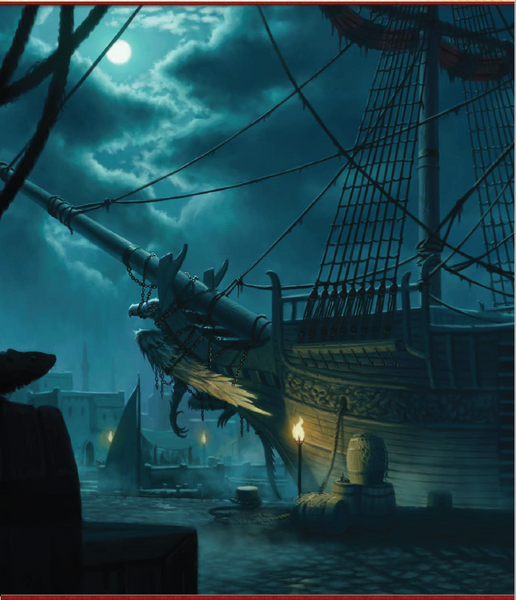
Our final nation is the much-villified peninsular country of the Ruby Sea. Its claim to fame is slavery of all kinds, and its respectable war-galleys house possessed demons capable of being controlled by the forbidden magic of ship captains. They search far and wide for new people to shackle, and some of their best clients are the gnomes of Niemheim, the priests of Baal, the Mharoti Empire, and the Tsar of Vidim. The Despot Veltrin rules over the country as an absolute dictator, who forged his empire of shackles from asking Baba Yaga the secret to taking control of a beached demonbound ship. From her lessons he learned ways to make more of those ships and thus form a veritable army. Beyond this dark power, Veltrin's flesh golem bodyguards are animated from the corpses of former generals who plotted a failed coup against him.
Slaves are kept in line with false hope and minor acts of "mercy" to keep them in line. Not having to serve the galley oars, magical healing, or a days' respite from labor make for powerful motivators, but so do starvation and lashes when those fail. In fact, the slaves are the city's greatest defense in a roundabout way. Via blood sacrifices to the White Goddess, slave-masters can temporarily transform slaves into hulking monstrous warriors. They were used to great effect in repelling Khazzaki raiders and Mharoti legions. Speaking of which, there is an unofficial alliance of sorts by said raiders: the Khazzaki give clandestine messages to the amazons of Perunalia to sail a warship and recover any of their captives while their mounted and centaur warriors plunder the Despotate's grain and farmland. Such widespread attacks cause much disarray among slaveholders, and many slaves use the opportunity to run off into the wilderness in hopes of making it to the Rothenian Plains or Perunalia or getting picked up by a friendly vessel.
METAPLOT: The Mharoti's new Sultan demanded the Despotate to send him tribute, but Veltrin is ignoring him so far.
Thoughts So Far: Far from your typical evil empire of doom and gloom, the Mharoti Empire is an interesting and varied land which gives a lot of fodder for adventuring opportunity, be they for or against the government. From the newly-conquered province to the private schemes of the Morza, it feels like a lot is going on in the region. Magic carpet shops, elementalist academies, ruins filled with the legacies of bygone times, and monstrous rulers make the Dragon Empire and surrounding lands feel full of great wonders and dangers. The Despotate of the Ruby Sea makes for a classic "fight the slavers" adventure hook, and the demon-bound ships are a novel idea. Parthia did not strike any strong feelings in me, but Beldestan's mustache-twirling populace is too ludicrous to be believable. It felt like the author wanted to make drow as a nation, but with none of the cool or sexy features that made those elves popular in the first place. But overall I liked this chapter.
Join us next time as we venture into the Southlands, home of the Nurian god-kings and the swashbuckling Corsair Coast!
Southlands
Original SA post
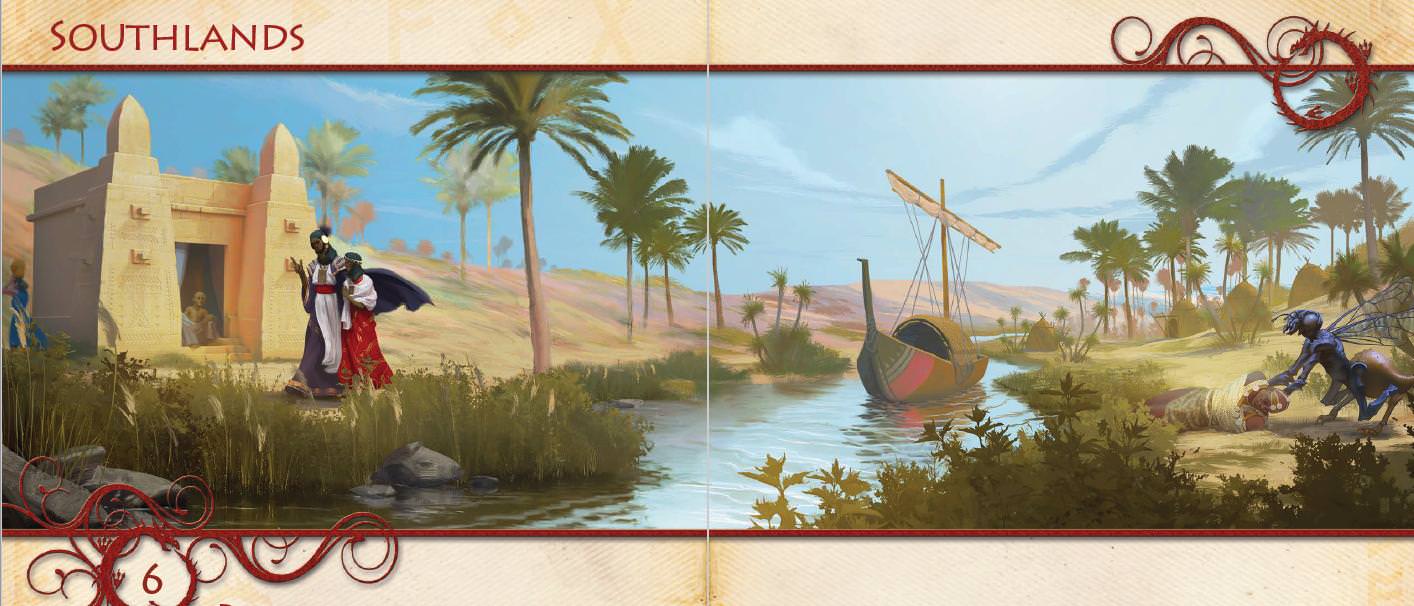
The portion of the Southlands presented in the Midgard Worldbook is but the upper tip of a much larger continent with its own very good I might add sourcebook. The "Southlands" as a whole is more properly known by its own people as the Kingdoms of Gold and Salt for the propensity of such trade goods. The realms with the most interaction with the rest of Midgard are the River Kingdom of Nuria Natal and the nation of Ishadia, who both have strong history of divine legacies and are the main blockade against Mharoti domination of the rest of the continent. To the west of Nuria Natal is the expansive Dominion of the Wind Lords, where elements of nature coexist with nomadic tribes. At the far east are the naval cities of the Corsair Coast, where legitimate business and piracy often go hand-in-hand.
METAPLOT: In an interesting change of pace, the chapter opens up by filling out recent significant events: a secret religious order of Thorth-Hermes known as the Emerald Order are undergoing diplomatic missions to noble courts in the Crossroads, Seven Cities, and the Grand Duchy of Dornig against the Mharoti Empire. The minotaurs, long enemies of the dragons, are rebuilding the fallen city of Roshgazi. The mysterious reappearance of the Lost Fleet and its miraculously-living crew are spearheading the efforts. A huge slave rebellion on the island nation of Shibai disrupted the flesh trade on the sea and caused more than a few newly-freed people to join freedom-loving pirate vessels for revenge. Finally, the rise of three evil cults are growing in influence. They include the antipaladin Doomspeakers, the Emerald Order of Thoth''s scholars who obey the prophecies of a mysterious green tablet, and the nomads of Selket's Sting who petition their scorpion goddess to punish their enemies.
Nuria Natal
The oldest surviving human nation bases its foundations upon a ley line-infused river. They are Fantasy Counterpart Ancient Egypt and have a close association with the gods of that pantheon. Their largest cities are named after their favored patron, such as Per-Anu and Per-Bastet. In times of great struggle and war the gods take physical form to enact mighty deeds. It is due to this divine protection that the Mharoti Empire has such great difficulty annexing their lands. However like any gods they cannot be at the beck and call of mortals, so some of their greatest mortal minions known as the god-kings were preserved in pyramid-tombs to awaken in times of great need. Some of them already walk the earth and do not always see eye-to-eye with the current ruler Thutmoses XXIII. Now Nuria Natal is more akin to a confederation of semi-autonomous city-states who unite together against a common draconic enemy.
The entries for people and places of Nuria Natal are focused strongly on the cities rather than smaller settlements and villages. Nuria, City of the River, is the capital and home to many grand pyramids, tombs, and a souk operating on a series of transient barges. Corremel is the most fertile city famed for its top-quality grains and beer. Per-Anu, the mysterious City of Crimson Pillars, is closed to entry save to trusted allies of the Cult of Anu-Akma (Anubis). It is home to loyal undead and the Red Portals, extradimensional gateways to other times and places. Per-Bastet, the City of Cats, is a cosmopolitan hub of varying people and races governed by an equally-fractured council. Its most notable natural feature is a "river" of sand cutting through the city's core. Per-Kush is famed for its many domesticated exotic animals and is home to a dwarven smith famed for the creation of huge constructs in the name of Nuria's national defense. Per-Xor is an outlier as its people are followers of the Sun God Aten, a jealous deity who has no desire to share his faithful with the rest of the pantheon. Although professing loyalty to Thutmoses, there are preachers who seek complete autonomy.
Our time in Nuria Natal ends with a list of famous tombs and ruins, such as a haunted pyramid whose vizier's devil-guided blood ritual went very, very wrong; shades of undead Mharoti buried in a sandstorm who still think the war's ongoing; and an evil offshoot of the Cult of Bast operating out of the ruined city of Tes-Luria.
Free Cities of the Desert
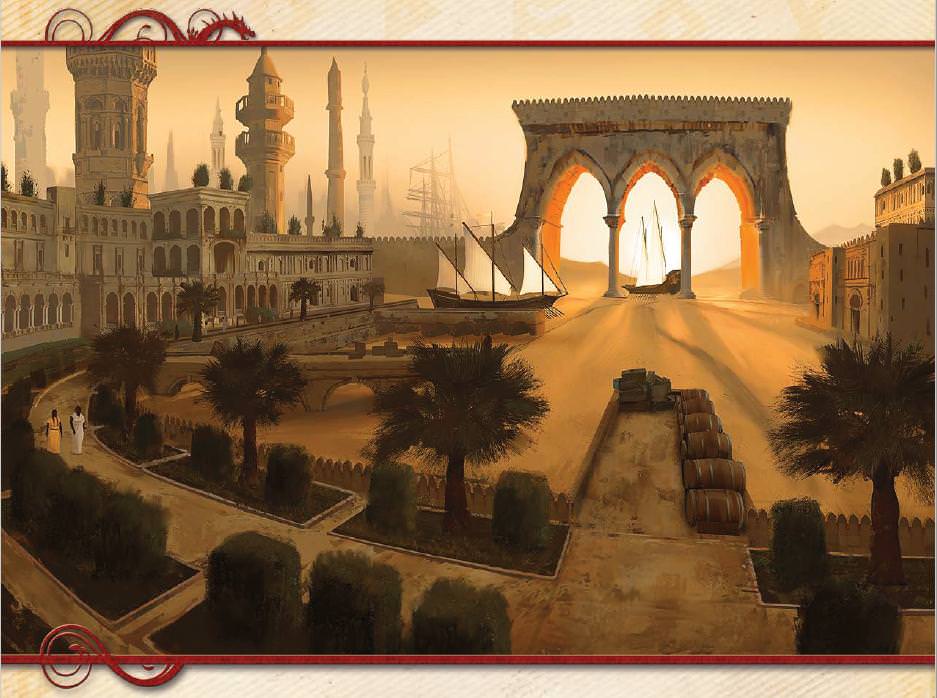
Whereas Nuria Natal was Ancient Egypt-themed, the city-states of Siwal, Saph-Saph, and Makuria are more Arabian in flavor. They were once Nurian holdings, meant to serve as a buffer zone between the country and foreign lands. Now they are politically autonomous yet still maintain friendly relations with their ancestral neighbors. Siwal is built around a natural oasis enhanced with elemental magic, and magical vessels known as sandships are its major technological innovation. Capable of long-range trade, they are few in number but supplement the more common camel caravans. Siwal is also famed for the people's love of dance, and some even incorporate the practiced mobility into beautiful fighting arts. Priests of the water gods serve a vital social role in town and act as gardeners in addition to conducting birth and coming of age ceremonies for citizens. There's also a Grand Necropolis where a community of undead hold their own court at nightfall.
Saph-Saph is situated on a common Tamasheq nomad route and is just as much a fortress as it is a settlement. The people worship Aten and their schools raise new generations of priests and paladins. Makuria, meanwhile, trades in sellswords and mercenaries while its queen plays Nurian and Kush rulers against each other to to help business. However, the Order of Horus provides a more productive use of martial talents by monitoring trade routes and keeping them safe from danger.
Our last stop is at Golden Ulthar, a lush valley in the middle of the desert which remains so due to a forgotten civilization's land-changing magic. The only living entity of this civilization is the sphinx Sepenret, who lays eggs of stone which bear the kingdom's magic. She has a major incentive in preventing thieves and tomb-robbers from absconding with the eggs or other artifacts of Ulthar. In order to fulfill her duties, she relies upon wardens and trusted adventurers to recover these purloined treasures.
[CENTER]Dominion of the Wind Lords
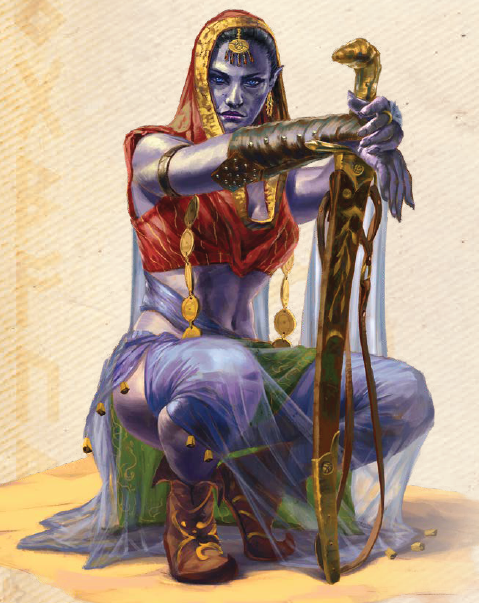 [/CENTER]
[/CENTER]The Dominion's lands dominate the majority of the northern Southlands, a harsh desert pocketed with rare yet precious oases and springs. The rulers are not mortals, but powerful creatures of elemental air represented by the four directional winds. These Wind Lords take an active interest in the affairs of the nomadic tribes calling the Dominion home. There used to be grand kingdoms here, such as Golden Ulthar and the minotaur city of Roshgazi, but their glory days are long past.
The Jinnborn are one of the major nomadic groups. They are not human, but rather descend from jinn and range from the Dominion to Nuria's deserts. They have strong ties to the elements and land itself and call themselves the Sab Siraat, or "people of the path." They are a new race who are further detailed in Unlikely Heroes for 5th Edition or the Southlands Campaign Setting for their Pathfinder stats. As an owner of both books, they have a series of powerful abilities and in Pathfinder's case a slew of new feats. However, they are dependent on living in the desert and every month they stay away are afflicted with debilitating debuffs. This rather limits their playability in campaigns away from the Southlands.
The Tamasheq are human nomads who are Fantasy Counterpart Tuareg people. In fact, Tamasheq is the name of the real-world language of the Tuareg! The Tamasheq organize into tribes of extended families known as vanhu who make regular trips between settlements to conduct trade. Although they portray themselves as simple nomads to outsiders, they have a secret thriving city known as Kel Azjer somewhere within the Dominion's mountains. We get a rundown on six notable vanhus who serve the various Wind Lords: the Vanhu Dewabi is ruled by a priestess who largely lairs within Nuria Natal and rustles camel for sport in addition to trade. The Vanhu Kozar serve Chergui the East Wind and use druidic magic to speak to nature spirits in order to avoid war-torn and dangerous regions. The Vanhu Lejai are fine warriors whose leader is a paladin with a pair of hunting cheetahs. The Vanhu Owey, Vanhu Adagh, and Vanhu Dinnij all serve Boreas the North Wind and have a hostile relation with the rest of the Tamasheq. They are some of the best cavalry in the Southlands and guard their elemental lord's broken tower which holds obscure knowledge.
For specific locations, we have the city of Kel Azjer located within an obscure mountaintop. It is home to all the boons of a large city, with skilled artisans, schools of mundane and magical disciplines, and grand towers and plazas. A network of Red Portals connect to areas elsewhere in Midgard as well as the planar commerce hub known as the Marketplace. The Shrine of the Spider Prophet is home to the eponymous figure, a robed person covered in a swarm of spiders favored by both the wind spirits who whisper him secrets of the land as well as his patron deity Kwansi. He has high status among the Tamasheq and foresaw a prophecy when the Mharoti Empire comes to war against their people. He is in fact looking forward to the oncoming chaos to test his skills as a warlord.
Two minotaur ruins of the Moon Kingdom are undergoing renovation by restoration efforts. The port city of Cindass is thriving in spite of its many unclaimed dangerous ruins inhabited by monsters and a fabled Golden Ark of Herosh. Roshgazi is home to a sprawling labyrinth whose halls shift of their own accord thanks to a sapient multi-personality artifact known as the Heart of Roshgazi. One personality is the kind-hearted Poet who is a helpful guide, but the malevolent Broken leads travelers to monsters and traps. The head of the lost Roshgazi fleet has returned to make repairs on the city, and whose leader is looking for a way to restore the Heart to its original state.
Our final location of note is the Mardas Vhula-Gai, a relic of Ankeshelian days home to magic runes and vril technology. The place is home to tribes of goblins, metallic construct guardians, and a ruthless warlord known as the Tyrant of Maras Vhula-gai who's building up a small army of raiders and assorted scum.
Corsair Coast
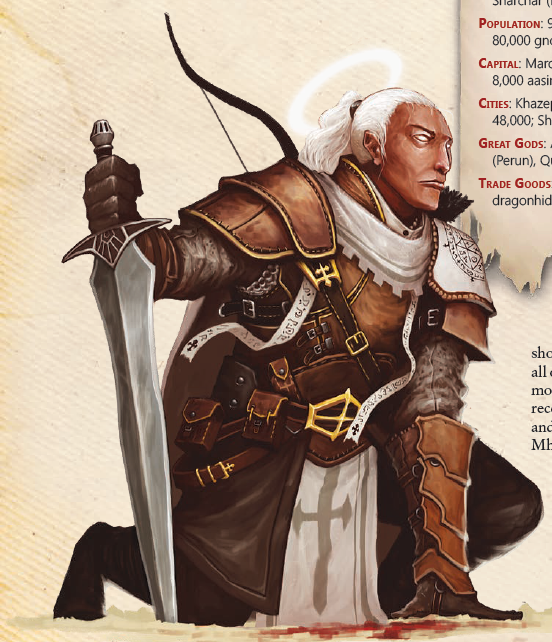
The final section of the Southlands chapter is also the least-detailed. The majority of focus is on Ishadia with brief write-ups for other realms. All of the people here rely upon sea trade for their livelihood, from merchant galleons to dangerous pirate vessels and warships.
Ishadia still stands in spite of their century-long war with the Mharoti Empire. Many of their cities are now but crumbling ruins, having suffered great losses. There is a brief quiet of sorts lately, as the dragons find their attention divided with other realms. But the Ishadi still stand resolute for when violence comes again. Worship of angels permeates Ishadian society, and even the most bloodthirsty cutthroat pays them respect. The Old Gods of the celestial realms once lived among their worshipers, their unions giving rise to a relatively high population of aasimar (about 3%).
Military service is compulsory for all adult citizens, a price the people accept as the cost of freedom from draconic domination. The capital city of Mardas Adamat's decorated dragon bone fortifications stand testament to that. The dammed city of Khazephon was once flooded by a dragon-caused tidal wave, and a group of lammasu sentries awaiting "the rise of a true king" stand watch over the vacant palaces claimed by the waters. Of greatest interest is the Phoenix Throne of Ishadia whose many broken shards hold powerful magic. Sequra is a tidy white city home to thriving criminal enterprises, and Shuruppak holds some of the largest and oldest temples in Midgard which used to connect extraplanar portals to the Seven Heavens. Pilgrims of many faiths from all over the world flock to the city due to this.
The Sultanate of Shibai is an incredibly wealthy island kingdom which sits at the epicenter of seabound trade in the Tethys Ocean. It was founded by Ishadian merchants whose descendants control their own port cities, and centuries worth of immigration from various lands results in a very multicultural society. The capital has a street literally paved with gold, which of course is protected from looters by walls of force.
Mhalmet, the City of Freedom, is a den of pirates, smugglers, adventurers, and merchants with the stones to hang around these dangerous people. A council of pirate lords, thieves' guild leaders, and caravan raiders known as the Black Table governs the city. Although many among their faction fight against the slave trade, they are not above extorting protection money from "liberated" people. The Sandalwood House is a social club of big game hunters and explorers who make expeditions into the Southlands for thrills and profit.
Sar-Shaba, City of the Seal, was once the seat of the kingdom of Aksaba but now it serves as the prison of a thousand demons. Angelic sigils trap the mortal descendants of its princes and princesses who serve a generations-long duty to stand vigil over their ancestral land. But fiendish monsters aren't their only problem: a cult known as the Seven Wicked Blades is looking for a means to break the wards so that their objects of worship can run free across the Southlands.
Thoughts so far: I have a soft spot for the Southlands, although that is mostly due to the setting book of the same name so I might be biased in this regard. There's quite a bit of adventuring opportunity in just about every realm, and I particularly like the "reverse tomb robber" idea of reclaiming artifacts for a sphinx patron. The minotaur cities in need of rebuilding serve as a plausible dungeon/settlement hybrid which makes sense, and the lost tombs of Nuria Natal along with its semi-independent god-themed cities are full of interesting plot ideas.
Sar-Shaba is my only major source of contention. Given the wording of its entry, it implies that the wards are a two-way street in keeping people out and demons in. The Southlands Campaign Setting proper explains that mortals can cross past its walls while the demons cannot. This helps serve as a place for Shar-Shaba to actually adventure in without undoing the wards. But the Worldbook entry is not clear on that, so otherwise it can come off as "city full of interesting adventure only when all hell literally breaks loose."
Join us next time as we sail north to the Seven Cities, a realm where war is not only a way of life but a most sacred calling of their patron god Mavros!
The Seven Cities
Original SA post
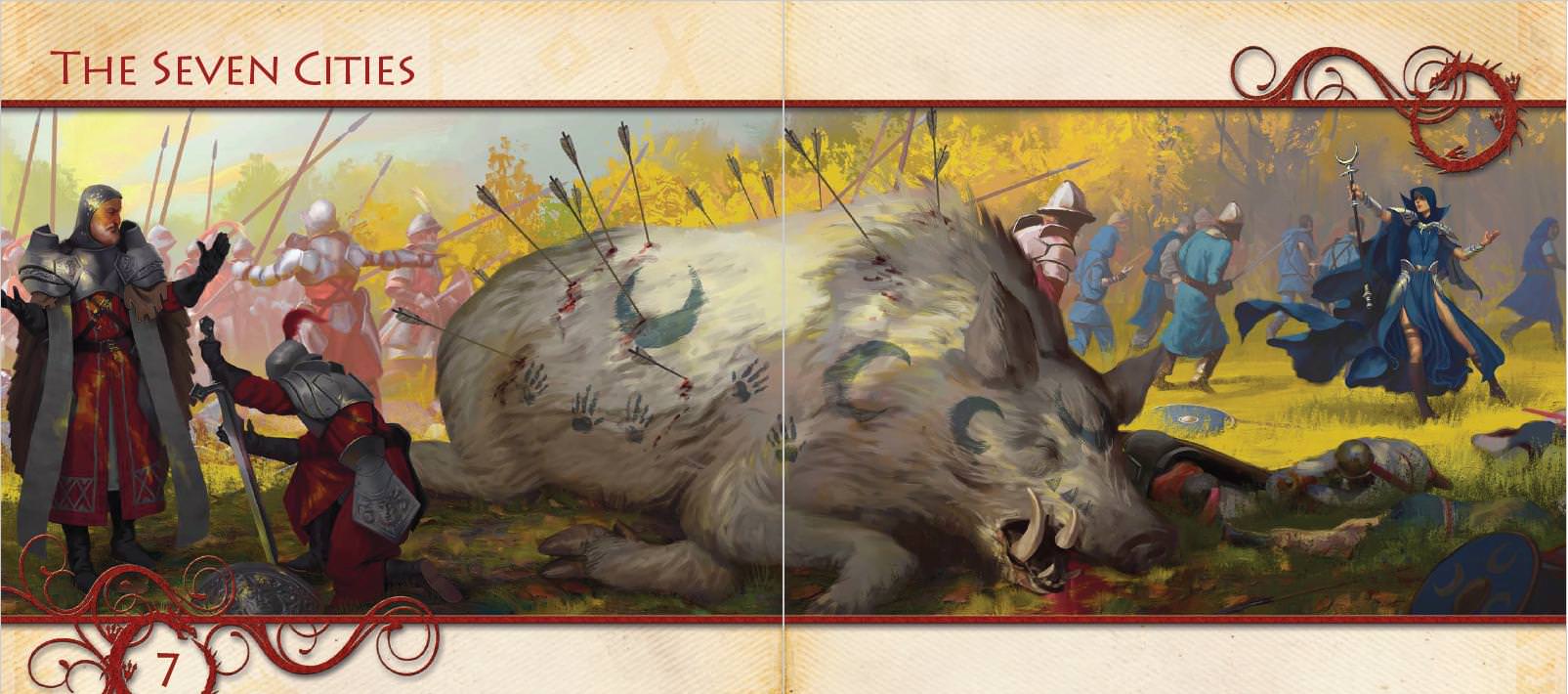
The peninsular region known as the Seven Cities today was shaped by the old elven empire, its human vassals intentionally divided by the elves exploiting rivalries and grudges. The Great Retreat was a time of turmoil for the now-independent humans, and saw all manner of would-be emperors and warlords seeking a claim as rightful ruler. The larger cities managed to gain a level of security, but generations of war soon became a way of life for the Septimes (name for the people living in this region). But these are not viewed as dark times; on the contrary, just about every citizen looks on with pride that few other places in Midgard are more famed for its warriors.
METAPLOT: The big changes are listed right up front. The oracles of Hecate managed to find a way to imprison the sea god Nethus whose very form was shackled in his temple. 8 years ago he was freed, brainwashed into thinking that she was his wife instead of his true beloved. Mnemosyne. The latter goddess is imprisoned in the very same temple which held her husband, and whose tears sustain the sea gods' heart. Illyria has been conquered by the Mharoti Empire, causing the Septime city-states to consider an alliance among each other as well as foreign groups against the dragons. Nethus aided the fleets of Capleon, Kammae, and Triolo along with Nurian Theurges to destroy the main Mharoti armada in the Battle of the Golden Wave. The Shadowy Fey attached a section of the Stross Library to the Great Library of Friula, causing all manner of supernatural woes to occur. The former Mharoti Sultana is a guest of Emperor Loki in Valera, her political knowledge of the dragon empire a useful tool in gathering together a Septime Alliance. Mharoti soldiers landed troops on Kyprion, and Kammae attacked Capleon due to factions among the latter city having years of financial relationships with the Mharoti. The Black Strangles spread to Trombei's cavalry.
We have an outline on the city-states and their unique military and economic strengths, as well as some cultural notes which we will cover in their entries proper. Amusingly there would be eight cities, nine if we count the isle of Kyprion which is part of the region: Capleon, Friula, Illyria, Kammae, Melana, Triolo, Trombei, and Valera. Even when Illyria still stood in the 2012 guide it was still known as the Seven Cities. Melana is described as technically not part of the region proper due to its proximity to the Wasted West, and Kyprion is a vassal of Triolo. The latter explanations make sense, but you have to read the appropriate sections to suss it out.
The Season of War
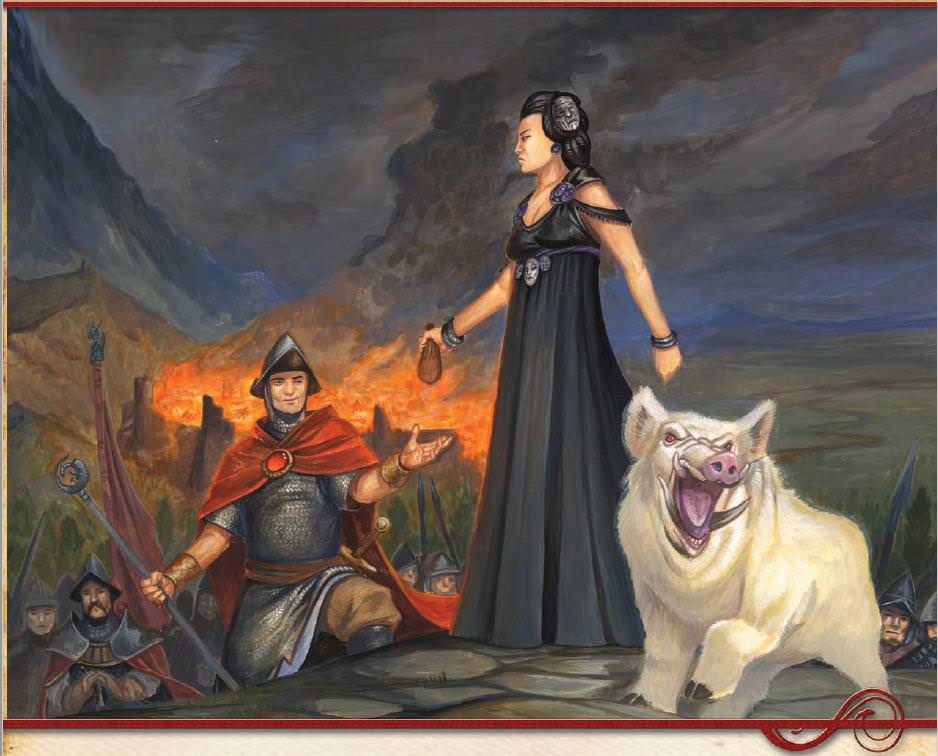
We cannot cover the Seven Cities without an overview of their distinct military culture. Mavros the war god is the most popular deity and patron of every city save Kammae, where Hecate reigns supreme. Warfare can be conducted for a variety of reasons, but there are divinely-set rules and guidelines for proper conduct. First off, there are five traditional reasons a city must claim to commit war and be made public, there are clear designations between enemy soldiers and noncombatant civilians (who are not to be harmed save in self-defense), government soldiers and free companies alike must wear clear uniforms to denote allegiance, the campaigning season ends at the winter months, and diplomatic lines to negotiation between warring cities must be always remain open. This last part is important, as the financial profit motive for war is taken into account: razing a city and/or committing genocide against a population not only falls under a war crime in Mavros' teachings, it also robs a conquering city-state from potential new resources and tax revenue. Payment of tribute, ransoms generated from prisoner exchanges, and Condottieri-style mercenary companies prioritize monetary and tactical advantages of war over bloodlust and vengeance. Unfortunately the Mharoti Empire has no sense of adhering to these ancient traditions, which gives them an advantage due to lack of scruples but more or less earns them the enmity of just about every Septime.
METAPLOT: There were traditionally five legitimate reasons to call for war: to seize territory to which one has a proper claim, to secure Mavros' blessing, to avenge an insult against a ruler or people, to force payment of tribute, or to support an ally. Now with the fall of Illyria, punishing a city for supporting the Mharoti is now a sixth cause.
The Republic of Valera is our first stop. Although not the richest it is the most devout, and it's common for poor families to give their sons to be trained among the priests of Mavros. An empire in name only, its government is divided between an Emperor and the Senate, although a military coup moved almost all the power into the former's hands. Emperor Loki V (not the god) is popular among the people, although the Senators are ones to hold a grudge. He hosts ambassadors from the Wind Lords and Nuria Natal along with the deposed Sultana in the eventual goal of repelling the Mharoti invaders. The Sultana is doing this in hopes of gaining enough allies from abroad so that she can reclaim her former throne. All these political dealings take place in the Adelian Palace, a remnant of elven architecture. The Palace contains magical features from ambient lighting, hidden shadow portals, and secret tunnels which exit out into various smaller areas around the city. There's also a growing movement of elf-worshiping cults who believe the shadowy fey's return is a herald to lost glory days. They are easily manipulated by their would-be gods into performing dangerous acts and are one of Valera's growing dangers.
The Theocracy of Kammae Straboli, or Kammae for short, is a theocratic city-state undergoing a spot of nationalist fervor. The aid of Nethus' sea-titans and supernatural animals known as ghost-boars enhance their army's already respectable legions of warriors and divine spellcasters. Now that not one, but two gods are on their side and walk among the populace, it seems that Kammae Straboli has nowhere to go but up. But one of its social ills are requiem dens, addictive drugs which allow imbibers to speak to the ghosts of long-departed people. Even mages and priests use it to their advantage to commune with wise spirits from history, but the drug takes a potentially fatal toll on a person's mind and body. The Halls of the Oracle is a magnificent religious building, and the re-purposed High Sanctuary of the Waves sees the arrival of Nethus himself to bless an adoring faithful two to three times a year. In addition to divine services the oracles sell a magic drink called the Tears of Memory which invoke obscure lore, and there's a waiting queue of rich clients and more than a few would-be thieves with their eyes on discovering its secrets.
METAPLOT: 25 years ago Hecate and her greatest oracle managed to imprison the sea god Nethus in one of his temples in Kammae. They also robbed his Mnemosyne of any memories of her husband, and gave the couples' newborn daughter to be raised by said oracle. Hecate sought to find a way to add Nethus' faithful to hers, and via a backers-only adventure obtained as a stretch goal for one of Kobold Press' KickStarters, she tricked several bands of adventurers into gathering Nethus' divine spark in the belief it would free him. Instead it removed Nethus' heart, allowing him to fully fall under Hecate's sway. He now believes that the goddess was his true wife all along, and that his "captivity" was him being nursed back to health after a grievous assault from the Mharoti dragon gods. Dalyora Podella, Nethus' daughter, has now been raised into the role of the city's warleader for an eventual campaign against the Mharoti. Now Mnemosyne is the imprisoned one, her never-ending flow of tears sustaining Nethus' heart and also used by the priesthood of Hecate for fueling powerful divination spells.
We have a list of other sites near Kammae, from small towns to adventuring locations such as a volcanic mountain teeming with monsters and a legendary island with a ghost-haunted palace. The Ringwood hosts several isolated towns responsible for training elite units of Hecate as well as the creation of the ghost-boars, monsters imbued with the powers of Charon the god of death.
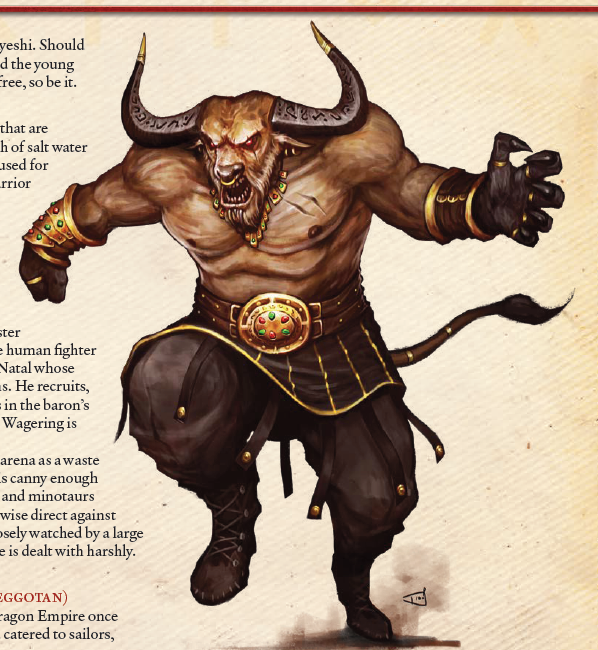
The Barony of Capleon is the southernmost of the Seven Cities and once counted Cindass and Roshgazi among its territories. Its ruling Baron Cazagoza sought to court favors with the Mharoti Empire...
METAPLOT: ...which bit him right in the ass, causing a significant portion of his own population and people from the other city-states to call for his removal. It's no longer safe for dragonkin merchants to visit after violent hate crimes from "so-called patriots." This angered the Mharoti, viewing the Baron as a ruler who can't seem to keep his own populace in check. Cazagoza's few remaining allies are the City Council and some merchant families who rely upon his navy for protection.
Capleon's ironically-named City of Peace is home to some of the largest banking institutions in Midgard. The Salt and Spice Bank in particular is a veritable bazaar where speculative markets see the rise and fall of fortunes. The Southern Quarter is home to ethnic neighborhoods comprised of immigrants from Nuria Natal and Cindass. There's a gang problem of violent skirmishes which are kept in check by heavy fines for civil disruption and property damage...which implies that gangsters care about the rule of law. In regards to the seedier elements of the city, Lion's Rock is the Baron's secret prison of dissidents and a patriotic Guild of Poisoners use their talents to slay all manner of threats to the city-state. The Tumbles are the ruined Temple of Seoggotan, now hosting a floating tent-city and series of tunnels home to smugglers and desperate faithful huddling out of society's view. The priests of Seggotan were accused by Nethus of aiding Mharoti soldiers, and pronounced his judgment by demolishing the place. Finally there's a Roman-style colosseum known as the Blood of the Sea Arena whose proximity to the waterfront allows the building to host mock naval skirmishes at high tide.
The Canton of Melana is in the far north of the peninsula and as such controls much of the overland trade between themselves and the Crossroads. Its system of government elects a pair of Censors (traditionally a dwarf and human) to leadership, although the most recent elections propped up candidates of radically different ideologies: one is an expansionist named Seppo Voller who has support among dwarven monarchists who seek to "liberate" the Ironcrags, while the human Jacopo Massaro is more isolationist military-wise and seeks only to keep trade relations with neighbors open. The city-state's significant dwarven population lives in the Undercity, comprised of Ironcrag refugees who resisted the region's transition to a more democratic form of government. The book also points out that the Monarchists are gender-egalitarian in comparison to their Ironcrag cousins, who "cloister their women" and do not let them choose occupations based on merit and capability.* There's also a hidden tomb of the last dwarven monarchists. A collection of notes written by the last King's oracle sister contain many prophetic insights; these publications were banned by Malena's censors yet still circulate.
METAPLOT: Instead of a dwarf, the last Censor in the 2012 sourcebook was the kobold Vinzlo, who ushered in a new era of rights and respect for his people in the Undercity. After his term, he is now the leader of the Warren Guild, a group of kobold spies, couriers, trapmakers, and assassins.
Some other interesting sites around Melana include the warlock of the Scarlet Citadel and his private army who sells his talents to the highest bidder. There's also the abandoned Sinkhole Mine, whose bottom levels literally fell off into a huge bottomless pit many believe to lead to the other side of Midgard.
*I know that I pointed out earlier with Perunalia that Midgard is overall a patriarchal world, but the book doesn't exactly do a good job of showing this save in exceptions like the one above; the Ironcrags section of the Crossroads makes no mention of "cloistered women," so we have to find out about an important social aspect of their culture several chapters later in the book. Other gendered social norms in the setting are referenced in small snippets, like "giving a son" to Mavros' mostly-male priesthood or how Kariv women "drink and whore and gamble as much as the men do." This persists in several of Midgard's supplemeents, like how the aforementioned Kariv women are frequent targets of sexual assault from outsiders in Dwarves of the Ironcrags; or how in the Midgard Legends sourcebook there's a tale of how the gnoll scholar Calm-Tongue demonstrated to the people of the Northlands the value of women warriors. One of my pet peeves with Midgard is not that it has a patriarchal social system at all, but doesn't make this setting element obvious enough for prospective players and GMs. It's a major difference from otherwise-egalitarian settings out there, because a PC's gender in certain races or regions can be a significant hurdle socially if not mechanically. It would be like failing to mention that a certain nation in your setting is incapable of producing clerics, but said reference is buried under entries to an unrelated group later on in the book.
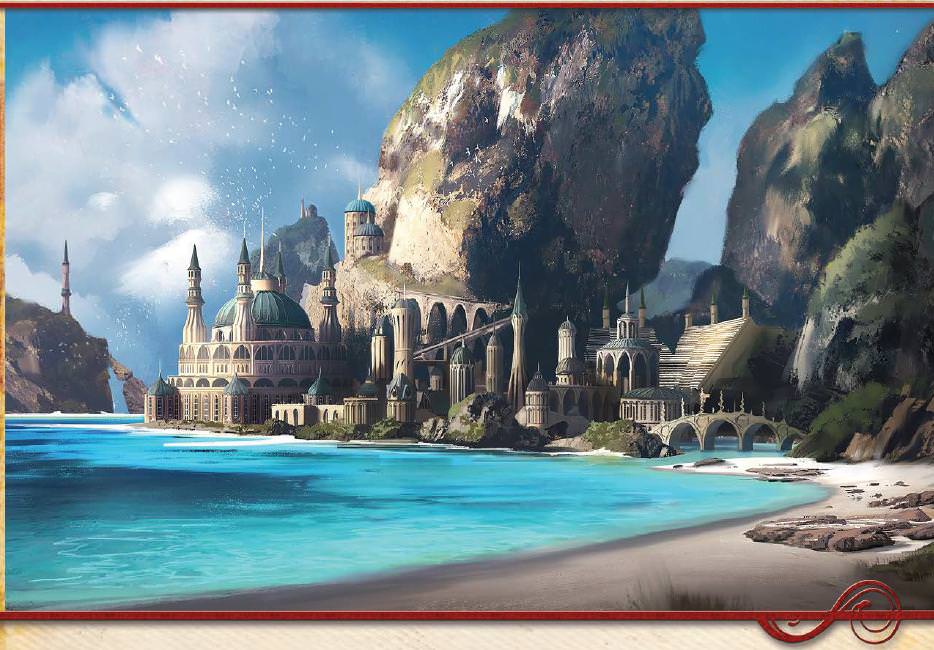
Friula, City of Secrets is no stranger to war, but that is not its strong suit. As the inherited legacy of a surviving monastery of a long-gone mystic order, Friula houses one of Midgard's greatest collections of books, scrolls, and records. Only the Magocracy of Allain and the Nurian temples of Thoth-Hermes can be count as its competitors. They even permitted Mharoti refugees and Arbonesse elves to donate their findings, much to the chagrin of other city-states. Friula's natural defenses include hills filled with basilisks so this is not a significant problem for them yet. The city's government is ruled over by the bibliotori, a council of 12 whose means of entry are by how much lore they can contribute to the city. They do not have control over the Great Library, which is presided over by the Keeper Lynnean Verdia...
METAPLOT: ...who is in fact a disguised silver dragon defector from the Mharoti Empire! There's an uprising of fear among the populace, as the Great Library's vaunted halls seem to grow in size into endlessly twisting dark corridors. More than a few visitors and scholars mysteriously vanished, and the bibliotori fiercely debate how to handle this problem. The bibliotori's newest member is Primus Balack Giolan, whose alliance with the hags of Ghostlight Reef granted him an endless supply of artifacts to donate. He is in favor of using adventurers to save the problems of the Great Library, but finds himself blocked by the Keeper and his peers in this regard. The Bibliotor Uthan Bianco's family lives under a curse where a demon will claim a newborn child unless the parents can answer its riddle. When he could not answer it on the eve of his daughter's birth he agreed to serve in her stead. Now the demon manipulates Uthan to vote against issues which would help solve the problems plaguing the Great Library.
The Great Library was a magical place even before the corruption. Living illusions, simulacrums of historical events, and eldritch guardians could be found within its halls along with a series of magical portals containing varying levels of danger. But two years ago the emergence of a portal to the Stross Family Library within the Plane of Shadow appeared. Its storehouses contained tomes believed not to exist or did not survive ancient cataclysms, such as Ankeshel vril technical manuals, a private diary of Baba Yaga, and tablets of the Southlands Titans. But the tradeoff is that one of the senior staff members is now enthralled to a demon, and a growing number of scholars and visitors are being killed and corrupted into shadowy thralls. Lynnean Verdia's fighting a desperate struggle, but even a dragon's power may not be enough...
There is not much in the way of interesting surrounding sites near Friula besides Ghostlight Reef, which reaches deep into the earth and is believed to lead to other planar worlds.
The Republic of Trombei is an economically powerful city-state with fertile farms and flanked by impassible marshes as natural defenses. The Republic's ruled by a council of landholders known as the Commune who elect a First Speaker to serve as a main administrator. Trombei's famed cavalry and centaur soldiers were a sight to behold in many campaigns, but the Black Strangles may cripple this great advantage. A dust goblin from the Wasted West perfected an alchemical compound to halt the process in horses, but with a 50% chance of killing the horse outright. As there are not enough clerics to eradicate the plague and those who do exist charge a pretty penny, the goblin's "miracle tonics" are the preferred option. Unfortunately the goblin's alchemy comes from moss scrapings of a Lovecraftian Waste Walker, and some of his racial brethren seek to kill him for this great heresy. The nearby settlement of Carpere is home to the annual Trombei Horse Fair, which sees tens of thousands of horses from mundane varieties to supernatural ones such as fey walkers and sleipnirs.
Other troubles facing Trombei include centaurs in an old elven fortress closing theirs doors after the appearance of the Black Strangles. There's also a renegade section of Ceres worshipers known as the Reapers who use vandalism along with poisoned sickles and scythes to strike out at merchants who reap the bounty of the harvests instead of the farmers. A crumbling former castle known as the Wreck is occupied by a coven of hag cannibals who seek to construct a golem out of flesh and bones. They hope to house the avatar of their evil god in this when the time is right.
The Republic of Triolo is home to corsairs famed across the western seas. The occupation of Illyria has hit the people hardest due to their proximity to said, and the Triolans are united in the goal of driving the Mharoti back. Its government is a complex system of two dozen merchant families, but the people who really get things done are its naval admirals: they include First Duke-Admiral Cadua, a minotaur who embarked on a voyage across Midgard where he sacrificed a horn, an eye, and a hand in exchange for peerless wisdom and a divine connection to Mavros. This earned him great acclaim when he returned to the city. Duke-Admiral Andreos Galatino is also a respected man, even as he spends most of his time in bed due to old age. Finally there's Commander Raniero Daliato, who heads Triolo's magical forces and elite units. Although Triolo is seeking alliances with the other city-states, there is worry among the leadership over the real reasons for Nethus' return which are only suspected, and Cadua is conflicted over when to send aid to Kyprion. For when he does, the dragons will attack Triolo directly.
Triolo's harbor city is home to a large amount of Illyrian refugees. They joined the military forces and naval occupations in vast numbers for the eventual hope of freeing their homeland, and a fortified island known as the Sphinix holds large trade fairs. The neighborhood of Spada Quays is home to many taverns, gambling halls, informal duels, and all matter of entertainment. The minotaurs live in a labyrinth-like Minotaur Quarter where they more or less rule themselves. The invasion of Kyprion has caused fierce debates among them over whether to protect Triolo first, or join their kin on the isles to fight the dragons. The Illyrian Quarter is a sprawling tent-city, and the Stews of Triolo are home to the city's artisans and well-educated sex workers who supplement their income with divination, mapmaking, and alliances with corsairs and merchants.
Factions near Triolo include Raguza, a city of pirates containing both licensed privateers and illegal scalawags; the griffon-mounted Sky Riders of Illyria who supplement Triolo with aerial scouting; the priesthood of Archae (one of Rava's masks) whose head oracle is magically frozen in sleep; and the secluded harbor of Turtle Cove, home to diabolist pirates unwelcome in Spada Quays and the rest of Triolo. One of Nethus' sea-titans, the Living Colossus, guards the habor of Raguza and single-handedly destroyed several enemy fleets.
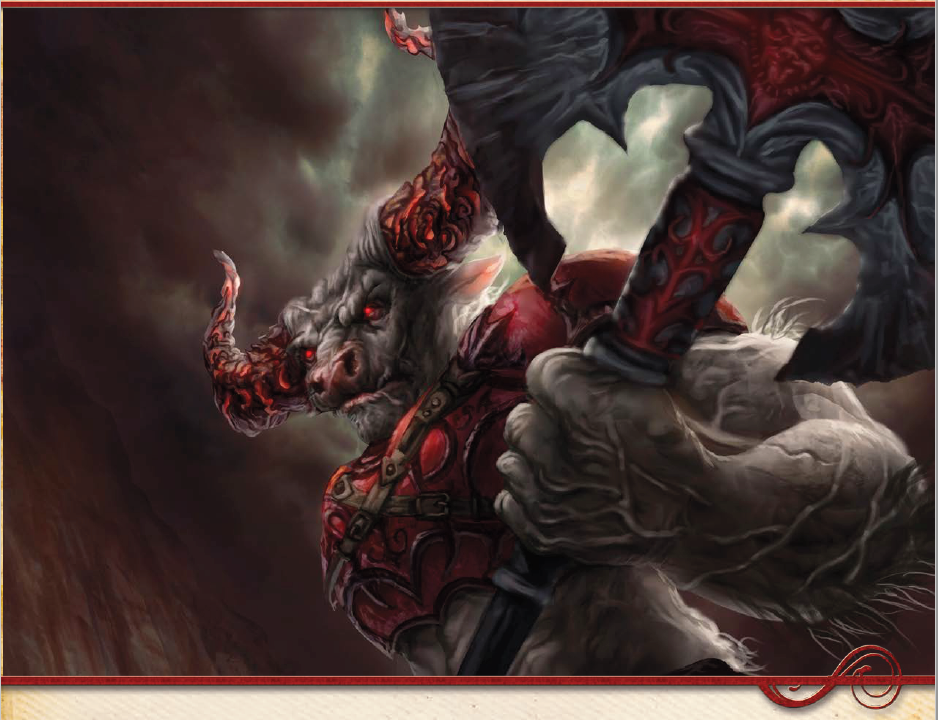
The Serene Isle of Kyprion is not so serene anymore. Long the homeland of the minotaurs after the fall of their Moon Kingdom, Kyprion is a vassal of Triolo leaving its people without a true home of their own. Queen Kitane puts on a good public face as a serene priestess, but is privately angered over Triolo's refusal to send military aid. Although aware of the political realities of the dragons attacking Triolo in such a situation, this does little to alleviate feelings of betrayal.
Kyprion's capital is Vespra, a lush and well-maintained settlement whose inhabitants greatly value music. Queen Kitane invites guests to her Palace to sleep in her labyrinthine halls, but every night bloody screams can be heard. This lead to rumors that both enemies and friends are invited but only the latter survive the visit. A Great Labyrinth surrounds the palace as a defensive region, home to many ancestral shrines and temples to Hecate. At night its many beasts and traps activate, and several times a year a great hunt of convicted criminals is held throughout the maze as a festival. Vespra's other "blood sports" location is the the Dancer's Courtyard arena. The Courtyard hosts ritual combat, duels to solve disputes, and ritual sacrifices of prisoners of war and criminals to the gods. Petitioners seeking justice, mercy, or revenge can be granted by the Queen if the person can sing a good melody.
METAPLOT: Chamiras was once a modest settlement whose fine rope was crucial to the island's sailors and maritime trade. It also held a necropolis believed to hold a literal portal to the underworld. But as of the publishing of this Worldbook, it was invaded by a Mharoti Legion two months ago. They gained a foothold via magically created fog and invisibility spells, and most of the city's defenders were put to death. Now its inhabitants are press-ganged into working on defensive trenches and walls. The Legion leader Aarush Vedula wants to invade more of the island but her superiors want her to hold out for now, much to her consternation.
METAPLOT: The city of Gramvar is a ruined realm, home to undead and demonic forces let loose after its binders were slain by an aerial assault of fire dragons. A small detachment of guards have their hands full in containing the monstrosities.
Other locations include Longezza, whose population of Rava-worshiping weavers are exclusively women, and Spintarra whose great ironworks and mines supply Kyprion with its tools of war. There are Mharoti spies in the latter, and attempts to land Legions here have failed against the city's strong defenses.
Thoughts so far: I really, really like the Seven Cities. The region has a diversity of locations and adventure material. Get your hands on the Tears of Memory in Kammae and possibly discover the dark secret behind Nethus' subservience. Go delving in a haunted library in Friula one day, then hunt criminals for sport in Kyprion's maze the next. Put a stop to shadow fey cultists up to no good in Valera and free dissidents from Capleon's secret prison. And that's not including the region's potential for soldiers of fortune to profit from military campaigns and sieges!
Join us next time as we endure a trek across the Wasted West, the spellscarred ruins of demonic magocracies!
The Wasted West
Original SA post
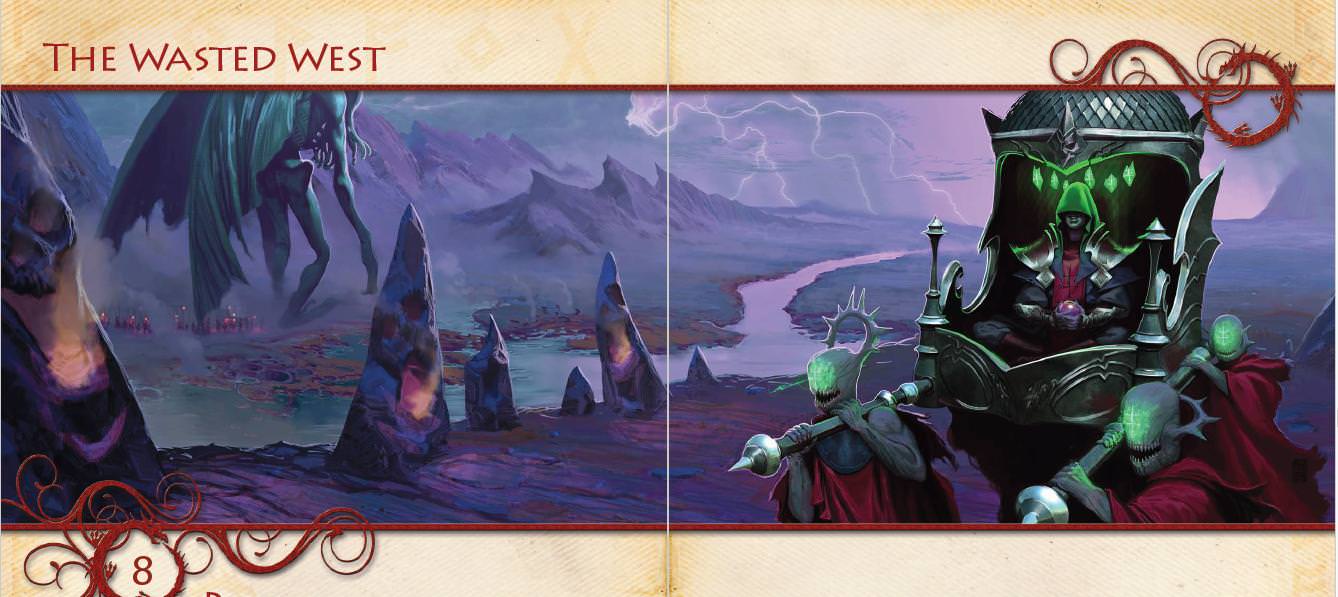
Dominating the continent's far west, the Wasted West is is the result of magical warfare and pollution unleashing horrors into the world. It all started with the empire of Caelmarath whose human and tiefling citizens sought power the elves refused to grant, leading into the Black Sorceress' Revolt and the creation of eight split-off magocracies. After the Great Retreat, the human mages had no common enemy and turned upon each other from the resulting power vacuum. Much like an optimized 3.X spellcaster and a GM trying to keep pace, the various archmages engaged in a magical arms race. Ley lines were blocked and turned into energy sinks to summon otherworldly horrors known as Dread Walkers to Midgard. These beings were beyond the control of their would-be summoners; although they did a spectacular job in destroying enemy cities, their mere presence warped the surrounding land and threatened to spread beyond the magocracies to the whole world. The surviving archmages invoked a ritual known as the Great Slumber to slow down time around the Dread Walkers to a few steps a year. Now these invincible beings stand as living monuments to what was lost. As of today Allain is the only true surviving magocracy, and Barsella transitioned from mage-rule to a merchant's council.
We get a list of the other seven magocracies and where their ancestral lands lair in the current Wasted West. Andarre was a nation of giants who were enslaved by Caelmarath, and whose cities were destroyed by hordes of summoned shoggoths. Caelmarath was a decadent empire with strong ties to the Eleven Hells. In order to protect its people from the Walkers, a ritual froze the capital city in time and transported it to the far corners of Realms Beyond. Carnessa situated itself in the lush jungles of the southwest peninsula for unmatched access to alchemy and herbal ingredients. It wasn't long before they too fell, as the entire peninsula was taken over by alien plants. Cassilon was a cosmopolitan realm of giants and shorter races living alongside each other, only to be burned down by Caelmarath's devilish patrons. Molovosch was a floating island brought crashing into the earth by the the Dread Walker Ornis Ammos the Sand Bird. Uxloon was the spark that set the fire for the Great Mage Wars in the first place: a mad archmage summoned the aboleth-created monstrosity Isonade to accost Bemmea's shores. A multi-national alliance of mages known as the Fulgurate Society summoned a Dread Walker to destroy Uxloon in retaliation. Finally, Vael Turog was ruled by demonmarked archmages who overthrew the original government and sought to cripple enemy realms with magical plagues. Their bio-weapons escaped the confines of their laboratories into the surrounding countryside, thus spelling the death of their realm.
Following the former nations is a sidebar on Void Speech, which takes double the normal time to learn (in both time and language slots) and can imposed the frightened condition on those who hear it for the first time on a failed Wisdom/Will saving throw. However, PCs who converse with a fey or alien creature in the tongue risk gaining short-term madness if the communication carries on for more than 10 minutes. It's a cool idea, although the DC is set to 11 for the fear debuff and only works once. For this reason you should be taking the language for role-play over mechanical reasons. We get descriptions on the various still-living mortal and monstrous servants of the Dread Walkers, such as the evil satyrs known as selang, worm-like dorreqis whose alien pipings and cacophanies can drive mortals mad, and servants of the corrupted goddess Bacchana who's now the Lovecraftian Black Goat of the Woods.
METAPLOT: Members of the Black Goat's Flock came together to open a rift in the sky and summon a treelike Dread Walker known as Y'gurdraketh on the Allain-Arbonnese border. Not at the best of terms, the mages of Allain and elves of Arbonnesse blame each other for the monstrosity's appearance. Unsurprisingly this lead to an increase in raids and skirmishes between the two nations.
MOAR METAPLOT: Braagezz, a new Beloved Leader of All Goblins armed with ancient vril machinery, is uniting more dust goblin tribes under her control. She promises that the goblins will conquer the entire Wastes and already controls most of the tribes. She is preparing for war from her base at the Mercurial Tower.
The Western Wastes
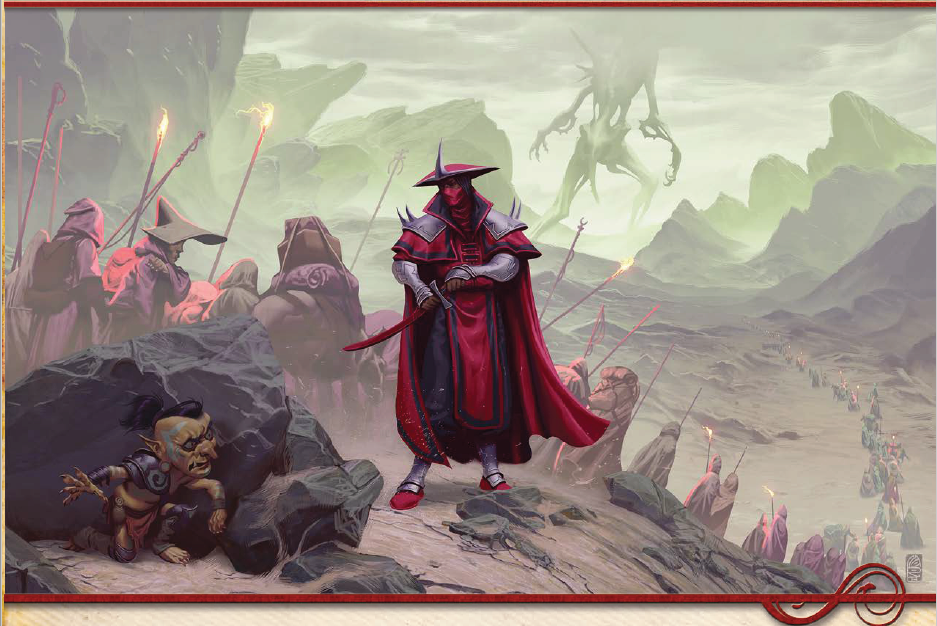
The opening text of this section notes that mere travel through this region should be anything but normal. Travelers superstitiously shield their eyes from the shapes of Walkers on the horizon, ley lines are broken and make using magical powers unpredictable, fields of doors stand on their own as remnants of a destroyed town, coagulated bloodlike lakes pose a hazard, and aberrant monsters occupying the crumbling ruins of towers and cities are but a few descriptions to showcase the unknown dangers. A list of the 10 Dread Walkers follows along with their locations and physical descriptions. I won't cover them all for the sake of word-space, but I'll include a few macabre examples such as Ashkharak and Gorthoga: the former a massive skinless humanoid with leechlike heads fighting its slug-shaped rival. Kb'r'ck is a mass of interconnecting crystal shards encasing the petrified remains of animals, plants, and people. They all surround a central nucleic mass which does not move so much as grow. Uthul-Vangslagish's discordant wailing can be heard from miles away, its thousands of tentacles ending in fluted openings. Various communities of dust goblins, cultists, and brave alchemists live around the Walkers to harvest resources out of the time-frozen abominations' flesh and/or to make religious offerings.
The next section covers magical mishaps in the Wastes: in fact, every time a mage casts a spell of 1st level or higher in a region without a stable ley line (basically anywhere but Allain or Barsella), they risk an unintended side effect on a roll of 1 on a d10 (or d8 for teleportation spells) covered in the below table:
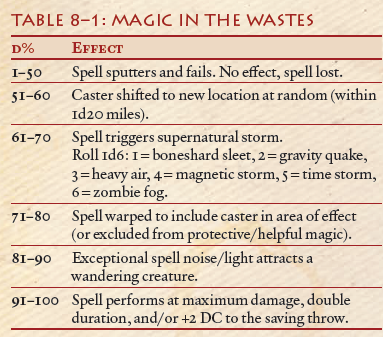
There's a 50% of a the spell not working at all, and a 40% chance that it works yet comes with a negative side effect. And one of those can potentially separate the caster from the rest of the party by a great distance! There's a 10% chance that it will beneficial. Although it appears that the mishaps will not trigger often, given how many spells a PC casts over the course of an adventure this is akin to how "critical fumble" rules hurt PCs more than NPCs when in the Wastes.
The Supernatural Storms can both occur on their own as freak weather and as part of a magical mishap. They include the nonlethal yet annoying smagnetic storms which render metal arms and equipment virtually useless, to deadly gravity quakes which fling people into the air along with pelting rocks and pebbles. The grinding boneshards splinter into those unable to find shelter and deal damage over time. Perhaps the most debilitating are the time storms, which can age a character 1d10x5 years on a failed save and can end up being permanent if not cured within 24 hours. The time storms also bestow the effects of a revivify (5e)/breath of life (PF) spell on those who died within its vicinity. The zombie fog turns corpses into zombies whose movement is limited to within the fog, while heavy air threatens to fatigue breathing characters.
Brief entries on strange landmarks around the Wastes provide adventuring opportunities, such as a castle-sized ooze known as the Hungering Cocoon filled with swarms of fetal creatures, or fields of eyes which appear as blue flowers from a distance but shoot strength-draining magical rays at those who trod upon them. I particularly like the Boils of Sarresh, bladder-like seedpods filled with air which dust goblins use to create floating traps and hot air balloons. The Seat of Mavros is a shrine to the war god and a popular pilgrimage site for religious and secular warriors. Its location in the Wasted West is quite appropriate, as the journey is a dangerous one. Clerics of Mavros stand at way stations along the route, doing little to directly aid travelers yet dutiful in retrieving the corpses of pilgrims. This is to ensure they have a proper burial rather than having their flesh and bones appropriated by alien horrors. The Seat has a sprawling tent-city around it with many arenas and dueling centers, along with crusty old veterans willing to impart learned wisdom. Finally we have the write-ups of the Waste's twin forests, the Roatgard whose warped trees are people transformed into agonizing plant shapes by an order of druids, and the Silk Thicket which gets is name from the horse-sized spider-monsters known as the chelicerae. These monsters learn the secrets of magic by devouring the brains of spellcasters, making them doubly dangerous to adventurers.
Dust Goblins
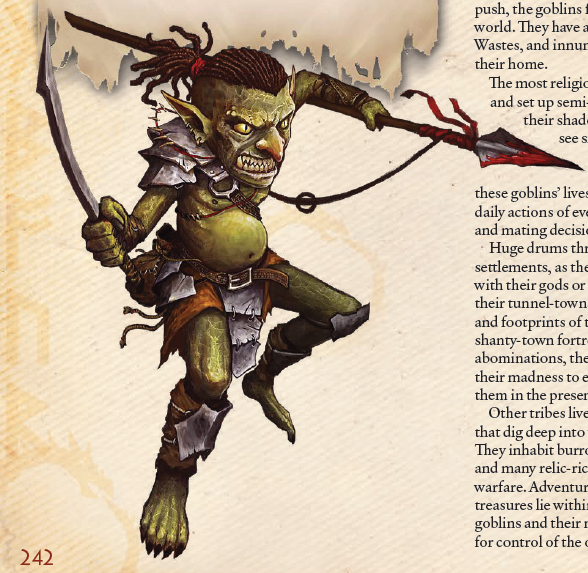
Most of Midgard's goblinoid peoples live in the Western Wastes, and the book seems to use the terms "goblin" and "dust goblin" interchangeably. There's no indication if the latter are a regional race to their own, or merely a cultural nickname. Based on the text I presume they're one and the same. In times long past goblins used to live beneath the mountains near the Ironcrags, but the unearthly weather patterns over the former magocracies allowed them to migrate to the surface world. Goblins organize into semi-nomadic units comprised of tents and wagons, and many make a living scavenging relics and natural resources from the Waste's ruins and unnatural terrain. Many worship the Dread Walkers as gods, and a social class of spellcasters utilize the creatures' time-slowed twitches and movements into their auguries and prophecies. There are attempts to find ways to communicate with the Walkers via musical instruments such as drums and flutes, although there's been no appreciable progress in this regard. Beyond magic a few goblins discovered ways to utilize vril technology which their chieftains use to ensure other races will not underestimate them.
We return to Braagezz, who look half-machine thanks to grafted vril prosthetics. Beyond her rising status we cover the eight known tribes, all of who congregate in the eastern portion of the Wastes. Their names are those gifted to them by human explorers, and they are loathe to share the names they use for themselves with outsiders. We've got the Bloody Tusks with monstrous war mounts; the Bonewraith cannibals whose last leader was a goblin mummy; the Dust Diggers with unmatched understanding in vril technology and whose encampments look like war machines; the Ghost Heads who have just as much undead members as living ones; the Maimed Ones who offer amputated body parts to the Dread Walkers in exchange for prophetic revelations of the universe's secrets; the River Rats who menace the bodies of water along the pilgrimage routes to the Seat of Mavros; the underground Sand Bird's Disciples live beneath the Dread Walker of the same name and raise nests of parasites and domesticated stirges for food and warfare. Finally the Scarlet Rovers are one of the most militarily-experienced tribes with assassins and bodyguards who sell their services to others.
Countries and Realms
The Green Duchy of Verrayne is a far eastern country in the Wastes. A fragment of former Caelmarath, it's ruled over by a monarch appointed by the druids of the Oaken Ring. The Duchy relies upon allied goblin tribes and the druids for defense. Supplementing their efforts are nine castles and fortresses lining the border operated by the vigilant Order of Seekers. Arcane magic is heavily distrusted in this realm, and the druids of the Oaken Ring made a pledge to restore the Wastes. They care fully for the ends of this pledge and perform many brutal deeds to accomplish the means: inflicting soldiers with lycanthropy to give them a combative edge, human sacrifices to hold the wasteland taint at bay, and using the entrails of pegasi and unicorns for divinations are but a few of their desperate tactics. In spite of these pursuits, the villagers of Verrayne live a relatively peaceful life and worship of the nature gods predominates their communities.
The Grand Duchy of Bourgund is a small yet orderly city-state overseen by an order of White Knights. The Duchy's famed for its perfumes, whose creation is a closely guarded secret and those who threaten to betray this are put to death. The history behind the preponderance of perfumery is the nearby foul-smelling massive corpse of Zhergthoth, the only Dread Walker killed by mortal hands with the honor of that falling to the White Knights. The city's streets are clean and slums non-existent as the government uses funds to insure that every citizen has a reasonable quality of life. However, laws are strict and wizards constantly scry the populace for signs of trouble. It's not unknown for White Knights to suddenly teleport into an area where a crime's about to be committed.
As for the White Knights, they are a military order who have a deal with the Magocracy of Allain. Mages of low promise, desperate straits, or scored the lowest on tests in Bemmea's schools swear an oath of loyalty to a single White Knight. As part of this oath they forge a bond with a suit of armor worn by said knight to act as a magical conduit between the two. The Knights' primary duties are ensuring public order in the city, protection of trade caravans and outlying villages, and killing rampaging monsters from the Wastes. Unfortunately it's been generations since the original Knights who felled Zhergthoth and many of their number are now more bureaucrats than warriors. The mages responsible for aiding their bound charges live in Mageholme Citadel, a gilded cage where wizards oversee their charges in well-appointed scrying cells. Most wizards learn both arcane and divine magic as part of their duties, and the most talented earn the title of Mystic Theurge (a Pathfinder/3.X prestige class).
METAPLOT: The White Knights of Bourgund are an order who shares a magical bond with Bemmean mages. Bonded armor allowed a connected mage to impart spells to a knight, communicate with each other across great distances, as well as letting the mages scry on them. But the mages were held in check by a magically-compelled oath to that specific knight. This relationship carried on for a time, but a traitorous mage known as Daiquianis subtly manipulated the connection into tricking his knight's court to travel into a green dragon's hunting territory. The knights did not survive, freeing Daiquianis and 12 other mages from their bonds, letting them escape the prison of Mageholme Citadel to return to Allain. Now other wizards feel a loosening of said shackles and distrust among the knights is growing. You know, I seriously have to ask how Daiquianis managed to escape the Citadel, what with it being highly-secured and magically-warded.
Mechanics: In the 2012 setting the Armor Bonded Mage was a wizard archetype which basically made a free suit of masterwork armor as an arcane bond. Said wizard could impart personal and touch range spells on the wearer at longer ranges (unlimited at 9th level), along with limited uses per day of scrying, unlimited telepathy, and spell resistance to the wearer of the wizard's Caster Level +5. I do not see an upgraded version in the Pathfinder/5th Edition sister system supplements. I do like the concept, but and it's a shame that 5th Edition does not have one.
METAPLOT: A dozen huge monoliths of crimson stone stand around Bourgund's city. No mere statues, they are the sleeping forms of powerful giants created by Aurgelmir. It's only due to a religious order of Marena which keeps them from awakening. Sir Markus Alavaine of the White Knights sought to awaken the giants in pursuit of fame and glory under justification of ending their looming threat permanently. The plan went disastrously, and it was only due to a group of brave adventurers and the suicide of a Red Sister of Marena to redo the binding spell. Sir Markus was merely demoted for this, but he's resentful for this disgrace.
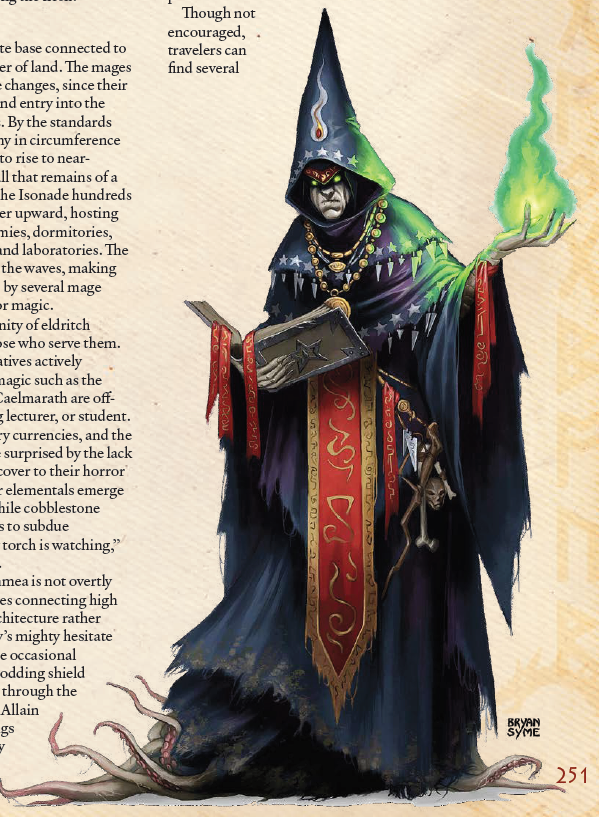
The Magocracy of Allain is the most-detailed entry in the Wasted West chapter. Not only are they the last surviving magocratic country in the region, their lands have a stable ley line which prevents the magical mishaps common elsewhere in the Wastes. The populace of Allain are not all mages, but they are veterans to the unfamiliar and unknown. Tieflings are common even among human couplings. They will never forget the dire prices paid in the Great Mage Wars, and spellcasting tutors emphasize pupils to use their talents to undo the damage to the land and not tread the path of their ancestors. To ensure that those with supernatural talent fall into trained hands, invisible hounds capable of sniffing out magic-users prowl the country for child prodigies. An unseen dog's howl in a village is often viewed as a sign that a child's been chosen. Although they are more common here than in other realms of the Wastes, arcane spellcasters of Allain keep a low profile: mundane cloaks are the bare minimum for disguise. Some of this is to avoid advertising their power and thus attracting rivals, but some of them do it to conceal hideous growths gained from dangerous experiments or infernal dealings.
Allain's government is the Ninemage Council, a gathering of powerful spellcasters of differing alignments and magical traditions. In spite of their name one seat is empty: this is to honor the memory of representatives from Vale Turog, Caelmarath's ancient ally. The magocracy's laws are labyrinthine and complex, muddled by pages of mundane rules of governance mixed in with ancient pacts wrought by otherworldly entities. There's a lot of frivolous laws rarely enforced (using palindromes in common speech), but there exists a cottage industry of law enforcement who fines citizens and foreigners for violation of some obscure rule.
The capital city of Bemmea is a settlement in the middle of the sea. A single land bridge accessible to the mainland via low tide. In fact the tides are artificially controlled by magical alterations to the weather so that the mages do not have to rely upon the mercy of nature to control entry to their city. Bemmea is tiny in area, yet its high towers house multiple living quarters for its residents along with lodges, laboratories, schools, and social clubs. The town's defenses hide in plain sight, from water elementals living within pools to golems made of cobblestone lying in the streets. The roads actually form complex glyphs when viewed from an aerial perspective. The Bemmean economy revolves around magical goods and teaching, and quite a few "discount scrolls" on sale are class projects and poorly-graded graduate experiments. The amount of magical academies number in the dozens, ranging from one-on-one tutorships to actual classrooms. Most apprentices begin training around ages 12 to 14 and finish their studies after a decade. Although tutors closely monitor their charges, there exist rivalries between students and the tedium of study's broken up with all manner of lodges and fraternities.
Several of Bemmea's more notable features include the Labyrinth of Carreult, an ever-changing maze which can shunt one along the ley lines to anywhere on Midgard save the Western Wastes. As no magic functions within its halls, it's used for duels between mages using only fists and staffs. This is for those who wish to resolve disputes, but want to avoid punishment for magical combat. The Smoldering Library's arcane fires still burn as they consume vile, tainted lore, while the Grifyn and the Kimera hosts Pokemon-style summoning fights where spellcasters pit conjured creatures against each other for prizes and bragging rights. Meanwhile, smashed glyphships destroyed during the Great Mage Wars hold unclaimed creatures amid dangerous sea life.
The other major city of Allain is Tintager, the Iron Metropolis. A border town guarding against the Arbonesse elves, its high walls and hard soil prevent even the toughest of weeds from growing. The only actual plants are cold iron feyward trees artificially smelted and formed to counter elven magic. Tintager is a dumping ground for unwanted tiefling children and disgraced Bemmean mages. Entire foundations of Tintager are formed from cold iron, and weapons and armor of this material are omnipresent.
METAPLOT: The summoning of Y'gurdraketh got elves and mages sweating bullets. The Dread Walker originally wandered nowrthwest over the course of several months before stopping in a grove containing an ancient monolith. The abomination effortlessly slaughtered detachments of Arbonnesse scouts and Allainian mages while suffering no noticeable damage. Both groups are keeping tabs from a safe distance as a result, and cultists are already making pilgrimages to the grove to offer Y'gurdraketh sacrifices.
The town of Maillon was originally a Bemmean neighborhood famed for its alchemical works. The place smelled terribly, so the Ninemage Council banned the trade and teleported the district into nearby swampland. The alchemists do not begrudge the Council for this; on the contrary, the marshes are home to rare and valuable ingredients, and the town's undergone economic prosperity for its wares. A lot of the old buildings are sunken into the swamp, so boathouses, gondolas, and stilted platforms comprise a majority of newer homes. The Bottle Market sells cheaply made potions of inconsistent quality which are praised by poor villagers and adventurers on the budget, or scorned by "proper" alchemists. A half-sunken laboratory of House Stross lairs in a rotting structure which can only be reached by boat. It holds all manner of vril artifacts, a portal to the Stross Library in Castle Shadowcrag, and monstrous oozes. We get a half-page description of alchemical hardwoods sold in Maillon complete with beneficial mechanics: wands fashioned from decaying corpsewood trunks provide a +1 on attack rolls when casting necromancy spells, shields made from Dampwood grant resistance from fire damage, scroll veneers can press residual ink onto a second page for spellbooks and scrolls, and Shrieking Planks built into furniture or building foundations will let out a piercing shrill when it detects nearby creatures of a specific type.
The town of Cassadega was formed around the remains of an old Ankeshel ruin, and its citizens tirelessly devote themselves to restoring old vril technology. They repaired arc-cannons which were used to great effect against elf raiders, and they learned how to create charged batteries responsible for giving vril items their power. A bustling industry in rare and valuable vril items are being sold out of Cassadega.
Mechanics: In short, vril is sci-fi technology nonmagical in nature. Such items are expensive and require rare materials found in Cassadega and Ankeshelian ruins to charge them. The Worldbook includes 4 examples of vril technology: a Cassadegan Coil Rifle which is basically a railgun, the ammo needed to use it, Vril Batteries which contain charges for vril technology, and the Vril Lightning Baton which can shoot a bolt of lightning whose damage increases the more rounds spent "charging" a shot: 1d4 if fired immediately, 3d4/6d6/10d4/15d4 for 1-4 rounds of charging.
The Ghostlight Forest is our final entry in the Magocracy of Allain. The woods are infested with will-o-wisps who tempt travelers into getting lost, along with territorial dragons, man-eating plants, and vampiric mists which sap the vital fluids of sleeping campers. There's a grand shine to the Goat of the Woods here, along with an end-times-preaching blood mage giant and his army of slaves. Finally, there are moss-covered standing stones whose glyphs are capable of laying to rest the ancestral spirits plaguing a haunted giant, but only if the correct ritual is performed. That last part will be particularly important for our next country.
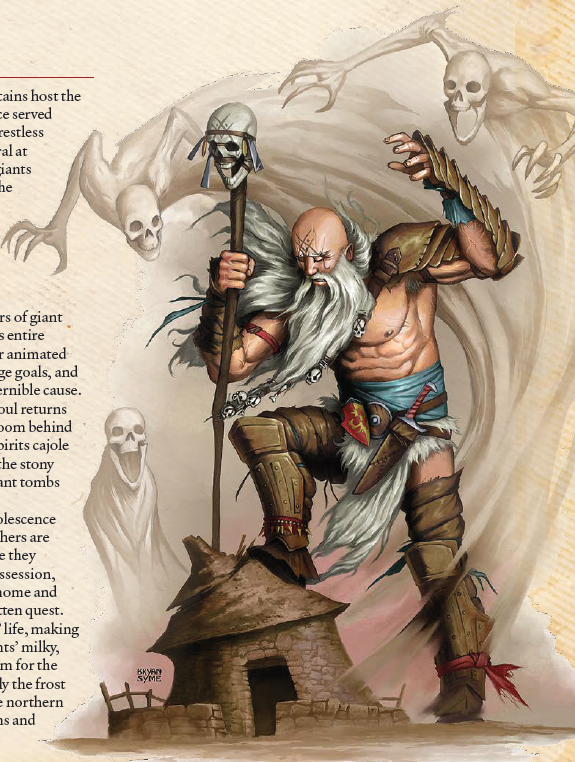
The Haunted Lands of the Giants are a forlorn wasteland populated by the larger denizens of the old magocracies. Although physically powerful, the greatest threat plaguing them is not the myriad horrors of the Wastes but the bodies and souls of their now-dead ancestors. The bones of many giants lair across the lands due to battle and enslavement during the Great Mages Wars. Every giant is haunted by the spirits of their kin, draining their vigor and constantly pestering them to lay their desecrated remains to rest in the cairns and tombs throughout the land. The amount of spirits who haunt a giant differ, and some come later in life, but they will come eventually as long as their bones remain unburied. The spirits can even possess a giant, and their animated bodies may rise to walk the land to perform strange rites with no obvious purpose. Now most giant cities are in ruins. Gangs and warbands lucky enough to have buried their ancestor's bodies the only ones with enough energy to rule over their peers. There is a brisk trade in amulets believed to ward away spirits, yet only a few are truly effective.
The Barony of Trenorra is a bandit kingdom comprised of humans, goblins, and hill giants lucky enough to be unhaunted by their familial spirits. The three cultures get along peacefully enough, although Bemmean mages and their allies are unwelcome due to their history of enslaving giants. The Barony's south is home to a huge feature known as the Wall separating the jungles of the peninsula from overwhelming the rest of the land. Known as the Gardens of Carnessa, the magically-bred flora within the greenhouses quickly overwhelmed the magocracy, its inhabitants now dead and replaced with all manner of shambling mounds, assassin vines, and similarly-themed creatures.
METAPLOT: In the jungles of Kush in the Southlands, there lairs an entity known as the Green Walker. It threatened to consume the people of Kush before a gathering of druids magically slowed time around it, much like the Dread Walkers here. Now its twin has been discovered within the Gardens by the elfmarked adventurer Tavereen Windrider. Dubbed Veth-Shoon, there are multiple theories as to how this dangerous twin arrived, but it created dozens of Bodysnatcher-style Vine Lords to go beyond the Wall and infect more people into its hive-mind.
Our final destination in the Wasted West is Barsella, the so-called City at the End of the World. Its economy relies upon the dangerous sea trade of the Western Ocean and is a common launch point for merchant expeditions into the islands of the unknown west. The city's no stranger to land-based adventuring, and quite a few guilds fund journeys into other areas of the Wastes if it will bring treasure and trade back into Barsellian coffers.
METAPLOT: The Western Ocean was once nearly impossible to navigate due to the magical influence of the goddess Mnemnosyne, but with her imprisonment by the oracles of Hecate many more ships are successfully making return trips to the city. They're flush with exotic goods and artifacts, enough return investments a hundredfold and resulting in an economic boom. However there is no consistent explanation of the islands of the far west. Sailors truthfully admit hundreds of different destinations on the same sea route, ranging from burning islands to ghost ships and leviathans. This does little to assuage the worries of financial sponsors. Barsella's streets are laid out to mimic an aboleth glyph connected with the presence of strong ley lines, and an order of geomancers devote their abilities to preventing this boon in the Wastes from decaying too quickly.
Thoughts so far: Another strong chapter, just about every entry in the Wasted West can generate several adventure-worthy plots. Given how overused Lovecraft's monsters are, I have to give Midgard props for making its own godlike Dread Walkers instead of borrowing the Great Old Ones wholesale, notwithstanding the Black Goat of the Woods. The alien weather, terrain, and dungeons/wilderness locations do much to showcase that the West is completely, perhaps irreversibly scarred by magic. The cities of Allain manage to be both high magic and appropriately creepy without becoming standard high fantasy. The giants' ancestral curse is prime adventure material: "find my grandfather's bones, which may or may not be animated as undead, and bury it within this haunted cairn." The pilgrimage to the Seat of Mavros is a good way to encourage PCs to visit this realm, and the otherwise bright and shiny duchies of Verrayne and Bourgund have an underlying brutal government to show that this ain't no Magdar Kingdom or idyllic fantasy countryside.
Our next chapter covers the Grand Duchy of Dornig, a forest kingdom which contains the last true remnants of elven culture on Midgard!
Grand Duchy of Dornig
Original SA post
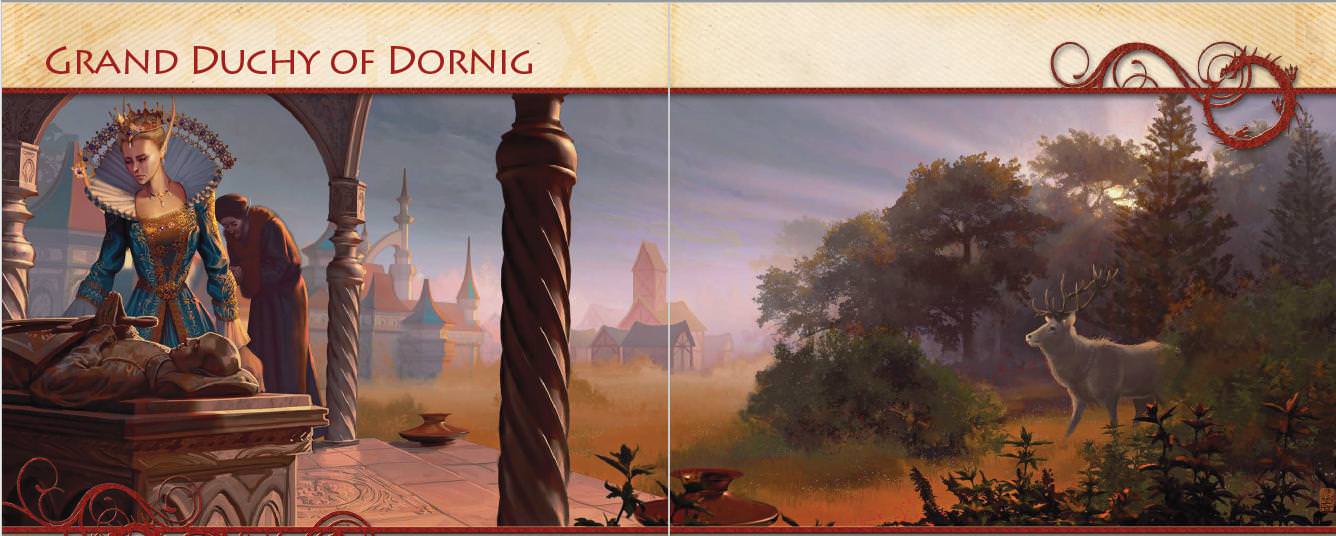
The Grand Duchy of Dornig, also known as the Domain of the Princes, is an expansive forest kingdom in Midgard's northwest. It is flanked by the oceanic Neidar Straits to the north and the reavers who prow its waters, the Wasted West and Ironcrags to the southwest and south, and the Blood Kingdoms of Morgau, Doresh, and Krakovar to the south and east. In spite of being surrounded by dangerous lands Dornig's been stable for most of its history thanks to the oversight of its Beloved Imperatrix Regia Moonthorn Kalthania-Reln vann Dornig. One of the elder elves who refused to follow the Great Retreat, she carved her kingdom out of a tiny barony and brought stability to the turbulent, fractious times in the near-500 years that followed. The great noble houses of the Duchy are her descendants either by blood or marriage.
I should note that Dornig's majority population is human, with the upper classes having higher than normal amounts of elves and elfmarked. This is because most of the elven population left during the Great Retreat, but the human majority more or less chose to preserve cultural elements of their rulers in contrast to the Septime cities or western magocracies. The biggest examples manifest in favoring elven blood in its rulers, the most popular religion being the Church of Yarila and Porevit which pays homage to the many-faced elf deity, and the fact that Dornigfolk are multi-lingual in both Common and Elven. The elves who did not or could not make the Retreat were members of the lower classes and social outcasts among their own people (the Imperatrix an exception) and either became small barons in what would become the Grand Duchy or retreated to their own communities in the River Court of the Arbonnesse. Humans in Dornig number around 3 million, elfmarked two hundred thousand, and actual elves less than 10,000.
For some reason I really like this touch. Too many fantasy worlds treat culture as being immutable and inseparable from one's heritage. It plays around with the "elves as a dying race" concept by making their society not really gone so much as inexorably changed as it now lives on in the adoption of a younger, dominant culture. The use of elves as an "elder race ruler" for a human culture, that is also non-human in influence, is far more approachable to gamers than being ruled by cyclopean aliens or other equally distant precursors.
METAPLOT: Things are about to get a lot more interesting in Dornig now that the Imperatrix has fallen into a coma which no mundane medicine or magic seems able to heal. Her body is still alive and taken care of in the city of Reywald, but her soul lives on as a white deer (a form she could project to scout the forests). Unable to return to her physical form for unknown reasons, she is trying to lure warriors from both Allain and Dornig to repel the Dread Walker Y'gurdraketh. Unfortunately the Black Prince of the shadow fey and other evildoers seek to hunt this White Hare as a prized trophy. And that's not counting the three noble houses and church struggling to fill the power vacuum. or the two aspirants seeking the Copper Sphinx Throne!
Dornig's socio-political structure is a feudal collection of lesser noble holdings of varying size and rank who pledge loyalty to the Imperatrix or the three Major Houses. Otherwise all other land within its borders are the Imperatrix's private holdings. The actual boundaries are almost impossible to keep track of due to the ever-shifting nature of favors and land deeds, and more than a few mapmakers literally went insane in this pursuit. The Imperial Court has the final word on governmental affairs, but rely on the three Houses Major for advisory capabilities along with smaller vassals for tribute. The Court in question was mobile and used to move between the three largest cities. This purpose was threefold: to prevent invaders from seizing a capital too easily, for propaganda purposes to show that the Imperatrix's reach is not confined to a single city, and to encourage good behavior and bolster the local economy by gracing a city for a time. Conversely it is used to punish disfavored Houses by denying this. But alas, Her Beloved Majesty lies in Castle Grauburg of Reywald, which as the years pass looks to be Dornig's unofficial capital.
We then cover the members of the Imperial Court as well as other high-ranking figures of the Duchy. There's quite a few of them, but some are explained later on, particularly the 3 major houses so I'm going to include a fraction of people instead of the whole list. There's the sleeping Imperatrix, who was a fair and just Chaotic Good ruler who's also the highest-level NPC in the Worldbook (bard 10/rogue 10/wizard 10)*; the crooked Lord Arcane Heronimus Abysin Aldous-Donner, an elfmarked wizard who's the ruler in the Imperatrix's stead and monitors arcane and magical affairs as part of his original job; Saintmistress Rowanmantle, the high priestess of the Church of Yarila and Porevit whose relationship with the Northlander barbarian settlements in Donnermark puts her at odds with House Aldous-Donner; Kalvora Moonsong, a full-blooded elf from the Summer Lands who wishes to claim the sleeping Imperatrix's throne and has the bloodline to prove it; and Queen Urzula of Krakova, leader of the refugees of that nation who's gathering what allies she can in the Duchy.
*This seems frankly unnecessary on account that nobody else breaches the level 20 cap.
We also cover religion in Dornig, which is dominated by the Church of Yarila and Porevit. The faith has a hierarchical system of government based out of a Twinned Cathedral, and supplementing this faith are various Gods common in the Crossroads regions. We have a sidebar on the Lords Arcane, a semi-secret government agency of arcane spellcasters headed by Heronimus Aldous-Donner. Their goals are to retrieve magical items and secrets from the ruins in the Arbonesse forests (and "unofficially" in the Tomierran forest), deal with and consult on magical threats, and wear rings which grant magical powers depending on appropriate roles and missions.
METAPLOT: There's a recent revival in the worship of other elven deities due to the return of elves from the Summer Lands. Baccho, god of poetry, revels, and wine is quite popular but there are rumors connecting him to the Dread Walker which shown up on Arbonnesse's borders. The mother goddess Holda is gaining in popularity, and given her hierarchy above Yarila and Porevit is a growing concern to Saintmistress Rowanmantle and the Church.
As you can tell, one of Dornig's major themes is political intrigue and alliances. There's even a minimalist system later to encourage PCs gaining their own baronies. A lot of the conflict and adventure opportunities are less dungeon-delving and more domain management or helping out a faction to gain favors, territory, etc. This is not exactly my cup of tea as I don't feel that this is Pathfinder/5th Edition's strong suit, and the barony-building is a bit too restrictive, but we'll get to that later.
The shadow roads of Dornig are well-maintained and reliable, and more commonly known as fey roads. Every major city has well-secured portals controlled by the ruling House which can take all manner of sizes and forms. The shadow fey are doing their best to claim as many roads as possible within and without Dornig, but the Imperatrix made a deal with them to not bother her Court or traveling groups smaller than 20 people. What this means is that the shadow roads of Dornig are a safe, well-known, and popular means of travel provided that you're in the good graces of the appropriate House.
Now we get to the cities of the Grand Duchy. They are the central locations for a Major House's government, surrounded in turn by subordinate baronies and vassals which connect to the main city by fey roads. The Houses who control Hirschberg, Reywald, and Bad Solitz are known as the Major Houses for their power and influence, while three "crown" cities have respective exceptions: Donnermark is a Northlander colony, Salzbach is technically autonomous but under charter of the Imperatrix, while Courlandia is not in Dornig proper and instead situated on a peninsula north of Niemheim and east of Krakovar.
Hirschberg is the most industrialized city in Dornig thanks to its position as a trade haven and is managed by House Hirsh-Dammung. Prince Octabian Hirsh-Dammung is an old warrior of Perun who agitates to move the Imperatrix's body back to Castle Reln. The city long ago exhausted the nearby hills of ore for its forges, and now these caves are inhabited by all manner of unsavory beings. This prompted more active mines to open up farther along the sprawling territory. Most buildings are three or four story affairs, with residential space on the upper levels and tradecraft on the bottom. The city's proximity to the Ironcrag canton of Grisal and the vampire-ruled territory of Krakovar necessitates a large standing army. The Imperatrix's old home of Castle Reln is currently empty and well-maintained by the Hirsh-Dammung family, although some of its passages and wings remain sealed for centuries and likely have new, unknown occupants from the fey roads.
Reywald is a beautiful city built around a lake and managed by House Aldous-Donner. Princess Lyndosa Aldous-Donner is the older sister of the current Regent of Dornig who often sleights her sibling by sending spies and adventurers to steal precious magical treasure from the Arcane College. Being home to the current Imperatrix's Court and the Twinned Cathedral, is sees all manner of well-to-do ambassadors and nobles, and Princess Aldous-Donner is looking for any reason to move the Court out and rule in peace. Whether it's by finding a cure or staging a "state funeral" matters not. The city's Arcane College is tasked with aiding armed forces in times of war and helping the Treasury of Antiquities recover elven magic from the ruins of the nearby Arbonesse forest. The High Platz in in Grauberg Castle holds the Imperatrix's sleeping form, and all manner of healers both legitimate and not can be found here waiting in a long queue. The lower halls are filled with well-wishers who hope for the Imperatrix's speedy recovery, so the place is always crowded.
Halflings and gnomes are a common servant class and have their own neighborhood called Little Reywald. Considering that gnomes cannot go outside Niemheim before Baba Yaga's forces track them down, this seems like a bit of a plot hole unless House Aldous-Donner has something to keep away the witch or Halivimar the Charred's sproutlings are growing throughout the city. The book does not infer either option, so I have to wonder what's up with that.
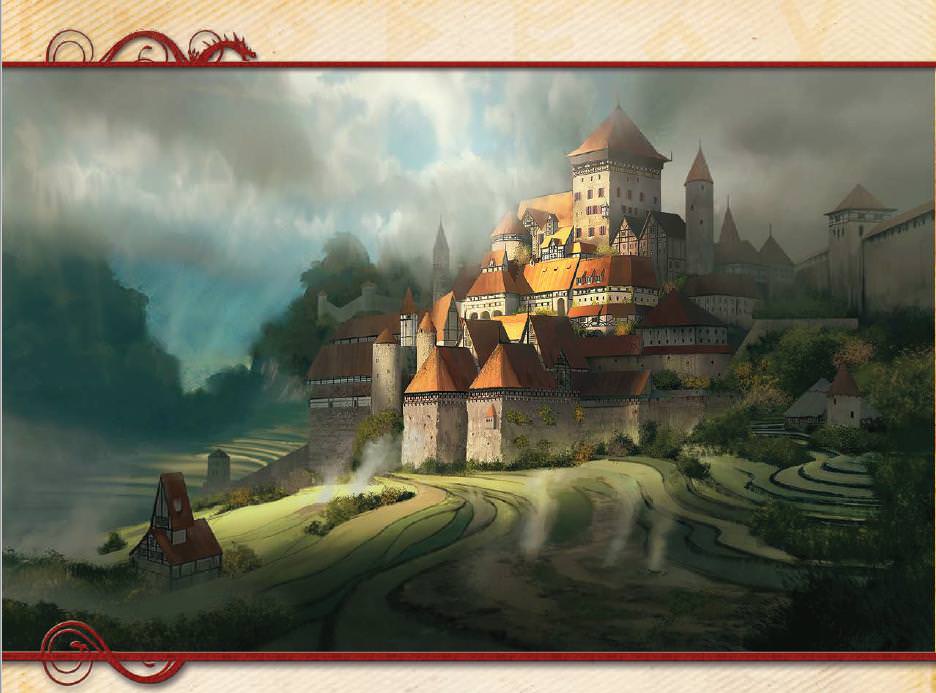
Bad Solitz is perhaps the least hospitable city environment-wise and is managed by House vann Rottsten. Located in the Tonder Alps, a great wall surrounds the valley nestling Bad Solitz's inhabitants. The Archon Court of the elven empire favored it as a location spot for its mud baths. Now its fertile ground produces some of the best winery in the Grand Duchy. No volcanic eruptions have plagued the region during the entirety of the Imperatrix's reign, which is of great concern to the locals now that she's in a coma. Bad Solitz's other claim to fame is a vibrant artistic community and the largest library in the country. Said center of learning has a rivalry with the Great Library of Friula for who has the greater collection of lore. The nobility lives in apartments rather than castles or keeps, with more than a few secret doorways and hidden galleries connecting them together.
The van Rottstens do not have a good reputation as far as nobles go: their family patriarch was literally dragged into the gates of Hell by summoned devils, and his illegitimate son Dimitor took the Houe's reigns at the tender age of six (and was also a level 6 Aristocrat at the time in the 2012 edition). Not one to let the threat of hellfire scare them away, the vann Rottstens are involved in all manner of backroom deals and not above making overtures to the Blood Kingdom or Grisal.
METAPLOT: Demalla Ravensblood was the ruling regent in Dimitor's stead, but when Dimitor came of age at 16 she disappeared and nobody can find her body or contact her spirit. Dimitor's official story is that she's making a pilgrimage to Ishadia, but many suspect the spoiled teenager to be behind her death.
Donnermark is a port city whose inhabitants share similarities with the lands and culture of the Northlands. In fact, they are the descendants of the crew of Hakon, a plundering viking who sought to raid Dornig. He gave a good fight and established a colony on the northern beaches, but the Imperatrix's forces were ultimately victorious. Instead of executing him, she invoked the wergild to make Hakon and his descendants pay for the damages. In exchange they gained control of the settlement that became known as Donnermark along with managing maritime trade. Now the people of the city are between worlds: viewed as barbarous and uncouth by the Houses, but too soft and foreign by Northlanders. Yorick Hakonsson is seeking to marry off his daughters to a great House, but neither find the idea appealing and would rather go on adventures.
The Free City of Salzbach lairs in southeast Dornig near the Ironcrag Mountains. It was home to a fourth branch of the Imperatrix's family before abominations from the Wasted West demolished the town. With the fall of the House came lots of political friction over who inherits what territory...which was rendered a moot point when said land was being made uninhabitable by monsters. The Imperatrix stepped in and offered baronies to any group able to drive back the abominations. This offer worked in recruiting many capable men-at-arms, and now Salzbach is ruled by guilds who elect their leader in lieu of a House.
METAPLOT: The position of lord guildmaster suffered a high turnover rate within the last 10 years. Three died of unknown causes, two were found guilty of corruption and executed, one married into nobility and had to step down, and one fled the country for Zobeck with several bags full of embezzled jewels. The current lord guildmaster is Michoda Swanne, whose company is barely better than a thieves' guild who sells "discovered artifacts." Now Salzbach is a den of thieves and the most well-to-do citizens have their homes guarded by private armies. The agents of the Lords Arcane heavily monitor this city as a result.
The Barony of Courlandia is on a peninsula to the east of Krakovar. In the years of upheaval following the Great Retreat, the Imperatrix called in a favor from a red dragon adventuring partner known as Zennalastra to take control of affairs. Unwelcome among the Mharoti dragon lords, she relished the opportunity to set herself up as the Red Queen. Ever since she ruled the province as a benevolent tyrant. Retired adventurers make up her personal bodyguards, who more than have their hands full in keeping up with their flying mistress as she hunts bison on the plains or dives for whales in the Niedar Straits. Krakova's occupation has been on her mind as of late; although the vampires currently give her a wide berth the dragon struck up an unlikely alliance with Queen Urzula to gain informational advantages on her new neighbors.
Other Cities include 11 other Houses and their territories. They are typically elfmarked and more rarely humans awarded territory by either the crown or three major Houses. The deed is not inheritable and lasts only for the lifespan of the recipient. However, good service can extend this into a proper feudal lineage where one's land can be inherited by offspring. Some of the more interesting houses include House Fratzon, looking over the merchant city of Gemport. The Fraztons swear fealty to the vann Rottstens, but may break away from this family due to Dimitor's unreasonable demands and other Houses seek to fund a rebellion. House Mervant holds the smallest territory in Dornig, specifically one tavern in Salzbach known as the Serpent's Ward. Merv VI is the first woman to inherit the title, and her tavern is a favored location by exiles and runaways. Hose Rhodewaldt has dubious elven heritage, whose ruling noble Magrave Jannis Rhodewaldt is the only elfmarked family member. He seeks to fund further discovery of elven geneology and hopes to marry his heirs into the larger family. His wife is a spy for the vann Rottstens who wish to add his territory to their holdings. If he dies, she'll be regent until the sons come of age. Jannis is aware of this but has no definite proof of treachery at the moment.
Gaining a Dornitian Barony
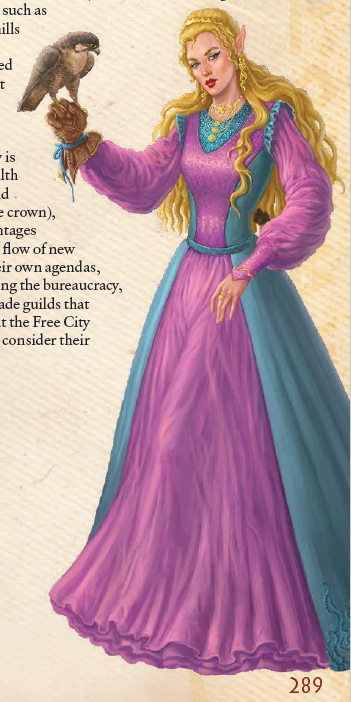
We have a discussion on Dornig holiday festivals and social seasons, the greatest of which occur during the winter months. Such occasions are accompanied by presentations of new songs and plays along with masquerade balls and feasts among the nobility. During this time various Houses mingle, so there's intense competition in settling scores and making alliances; although duels are outlawed they still occur, and Saintmistress Rowanmantle prepares healing spells in the rare event of assassinations (but only for the benefit of the Major Houses). A peculiar tradition in Dornig banquets is the position of salt shakers in the middle of the table. A person's seating arrangement indicates social status the closer they are to the host, while those "below the salt" are seat-warmers to make the hall seem less empty.
But how can the PCs interact with this? Well we now get to the nitty-gritty details for how a player can gain a barony in the Grand Duchy! The requirements are actually rather steep: only humans, elves, or elfmarked can be granted a deed, they must be level 10 or higher, and are recommended to have a Charisma 15 or better (never below 9). If using the Status optional rules they must have at least a 20. Beyond mechanical requisites, they must have the favor of a Major House or the Imperatrix to grant the deed, which is gained by valuable service and deeds within the Barony (foreign deeds do not count). An oath of vassalage must be made during court season to the Imperatrix or her representative the Lord Arcane via a geas spell.
So what do you gain for this? Well there's no hard and fast rules, but you get a castle, keep, or manor next to a community with some form of agricultural industry along with a fey road gate connecting to other towns. You can lose a title for failing to turn a modest profit on the land in tax revenue, not providing soldiers to the army for times of conflict, not providing your talents to the Imperatrix or sponsoring Major House, as well as committing crimes against the Grand Duchy such as treason or spying for foreign powers. We get a one-page description of common complications and adventure hooks to give to a PC baron, ranging from peasant uprisings, nearby monster-filled dungeons, political corruption, and contested land grabs from nearby nobles.
There isn't really much in the way of sample revenue generated or mechanical benefits, but Pathfinder has extensive kingdom-building rules already. There are some 3rd-party supplements for kingdom/domain management in 5th Edition, but I do not know of anything in the way of official material beyond the gp cost for stronghold buildings during Downtime. Swords & Wizadry already has domain management built into its classes by 9th level.
So if you're playing Pathfinder or Swords & Wizardry you already have a useful set of tools for managing a barony. If you're playing 5th Edition...well, let's hope that Strongholds & Followers turns out to be a good book!
Forests of Dornig
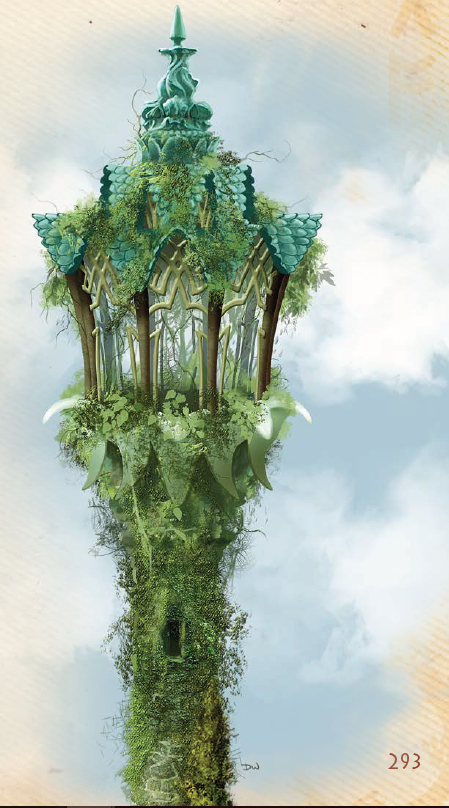
Although the Grand Duchy claims territory of the remnants of the empire of Thorn beneath the forest canopy, there are significant sections of wood which lay beyond the safe reaches of the Imperatrix or the Houses. The Arbonesse and Tomierran forests are primeval woodlands occupying the western Duchy, the latter holding the lost city of Thorn.
METAPLOT: The Tomierran has been declared sacred ground by the Church of Yarila and Porevit, and thus no longer grante access to the Lords Arcane. Small communities of elves are popping up within the two forests in the form of small villages. They appear more or less overnight and its inhabitants act like they always been there. The borders between Midgard and the Summer Lands are murky in this region, so they may very well be right.
Most elves in Midgard are either the shadow fey or live in the Arbonesse Forest. In the case of the latter, they are known as exiles who for various reasons could not or would not answer the Last Horn for the Great Retreat. They live in small subsistence-based communities which number no greater than a few hundred at most. Although they swear fealty to the Imperatrix, they are more or less autonomous and whose leadership is located among a series of white stone citadels known as the River Court. The Court is ruled by an elven wizard named Ulorian the First, whose power is waning as of late due to the influx of elves from the Summer Lands. The newcomers are tight-lipped as to the circumstances of their return, and the growing power of the Shadow Fey's Black Prince makes him wonder whether resistance or acquiescence is best for his people in the long run.
Other interesting locations in the Arbonesse Forest include the Tilted Tower, once home to elven sorcerers who gave their lives to prevent the human magocracies from sinking their land entirely. Their mile-high structure now bends at an angle over the nearby shore. The Shadow Fey hold a nearby Court of Scandal beneath a barrow mound where they force prisoners to dance never-ending for them until they die or commit suicide...at which point their corpses are animated to continue the dance until they fall apart. A single golden throne sits unoccupied due to deep infighting, but legend says that one who can sit in it continuously for a year and a day will become ruler of all shadowy fey and lead a march to conquer the lands of their elven cousins. Finally there's the Gentle Rest, a rustic inn whose location continually shifts to be near travelers fleeing a great danger or on the brink of starvation.
The Tomierran Forest is abandoned, unpopulated even by the new elven arrivals. It is a dangerous realm home to a rotting World Tree full of unrealized creatures due to the weaves of fate running threadbare. Warped fey and plants from elven experiments roam as free-willed former guardians along with elementals, owlbears, and perytons. The Forest attracts many treasure hunters in spite of its dangers, and in the past the Lords Arcane conducted official expeditions. Now the Church is in charge of guarding its borders, and looters caught must hand over their gains and share all that they learned. Lord Arcane Heronimus Abysin Aldous-Donner still lets "independent contractors" slip past ecclesiastical authorities in return for a portion of treasure. Looters will remain looters, so you may as well ensure that a portion of their ill-gotten gains fall into the Duchy's hands rather than a foreign trader's.
The Ruins of Thorn are an eerie place. Abandoned meals are still warm, and mundane pets which should have died of old age still await their masters' return. Old runes and spells serve as magical traps, and in many areas time flows differently. An explorer may one day spend years surviving in Thorn only to leave and find out a day has passed. The lost Mithral Mines still hold entire caverns full of the precious metal, and explorers miraculously discover new hidden passages in the once-thought-completely-plundered ruins of the Raven Tower. Traps reset, buildings shift locations, and unknown tombs appear where there was but wilderness. Crows, ravens, and magpies infest the Tower and worshipers of Wotan consider it a holy site. There's a Stone Gallery near the Krakovan border containing basilisks and medusae, which has done little to turn away undead scouts. Finally, the wave-washed forests of Lost Arbonesse which sank during the Great Mage Wars hold many artifacts...provided that one can brave the ghosts and sahuagin lurking underneath the lightless waters.
METAPLOT: The petrifying monsters were once a scourge in Krakova, to the point that the crown of that country threatened to take matters into their own hands if the Grand Duchy could not do the job. Now it looks like that point's moot on account of the vampires and all.
We end our time in Dornig with a brief discussion on the Summer Lands, the plane of existence on the opposite side of Midgard. Here elves still rule and gnomes, goblins, and halflings are their servants. The royal court is overseen by a good-natured King Valeshi IX and whose wife Queen Haldifelli III has a great love of archery and ale. The Imperatrix of Dornig is one of their nine grand-children, and due to elven longevity the court's home to dozens upon dozens of great-grandchildren, great-great-grandchildren, and so on and so forth who serve various roles ranging from generals, nobles, and priests. Visitors to the Court will be ignored and sent on their way after a nice meal unless they are famous or have a great offering to give. The elves of the Summer Lands are deeply enmeshed in their own concerns and so do not have much time for idle visitors.
Thoughts so far: My thoughts on the Grand Duchy of Dornig are mild. The realm is themed heavily towards adventure hooks involving the various noble families, and the barony rules will not kick off unless you have the right kind of party and are barred from lower-level PCs. In comparison to the Seven Cities and Wasted West there's not as much variety in sociopolitical setups or potential dungeon crawls. Many members of the Imperial Court and lords of the Major Houses are verging on the extremely high levels (14 to 19), so the ability of outsmarting/challenging them to combat is unlikely for PCs unless they're nearing the endgame point of D&D/Pathfinder.
Leave the sea of trees behind as we set sail for the Northlands in our next chapter!
Northlands (Frigid)
Original SA post
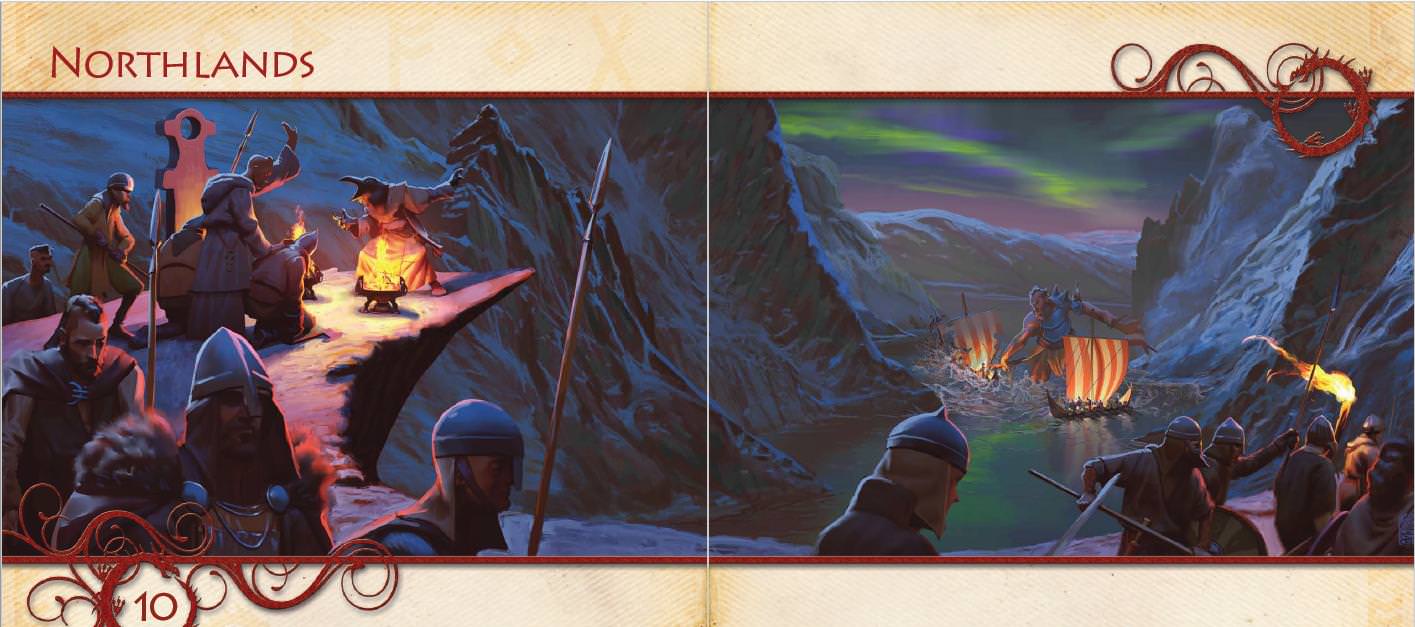
The Northlands are a distant, cold realm on the edges of known civilization. It is a beautiful place, with scenic fjords, skies alight with the aurora borealis, and glittering morning frost. But beneath this scenery is a harsh land of independent holdings, where a king is a man with a long hall and an ample fleet, where justice and vengeance go hand in hand, where monstrous kingdoms of wolfin worshipers of Fenris and giants of Jotunheim can eclipse human holdings if their wyrd wills it.
Although it is more high-magic and made by different publishers and writers, a lot of Midgard's Northlands are reminiscent of Frog God's Northlands Saga. The social structures divide into thralls, karls (freemen), and jarls who the former freemen choose to serve as part of a greater community via informal oaths. The political landscape is fluid on account that divine right or royal bloodlines do not prop up a jarl's right to rule; instead merit is based on their own community trust and holdings. Although home to a variety of races, there's enough cultural similarities to the point that a human, trollkin, or goblin hall share common etiquette customs. In addition to jarls, democratic assemblies known as Þings help settle disputes, forge alliances, and conduct trade. Both at the Þing and in other circumstances, justice can be dispensed via a holmganga duel or payment of a wergild in valuables or blood. Sometimes a duel is not enough, and blood feuds can spiral out of hand as communities call upon sworn oaths and obligations to pull ever more people into the fracas.
Northlanders hold a special reverence for fate, the collected destinies of all peoples whose lifepaths are weaved into the threads of the Norns' loom. They do not believe in chance, but they do give credence to luck which indicates a favorable skein of fate playing out for an individual. Charming men are called "woman-lucky" while skilled sailors are believed to possess "sea-luck." This determinism gives most Northlanders a strangely optimistic attitude: there is no use in complaining, and good folk should struggle on as best they can and hope that the rest of their thread is more fortunate. Nothing lasts forever and all things must come to an end, even the gods when Ragnarok shall fall upon the world.
METAPLOT: Speaking of the end of the world, one of the more pernicious dangers of the Northlands is the rise of the Cult of Ragnarok. Although the timing is wrong and the stars are not right, many details spoken of in skaldic history are coming to pass, and people grimly prepare for Fimbulwinter. This is of course Loki's fault, who entered into an alliance with Boreas and Chernobog to create an evil cult to spread chaos of a "false Ragnarok." The cult operates via a widespread network across the region and counts many members of the major races along with monstrous allies.
Kingdoms of the North
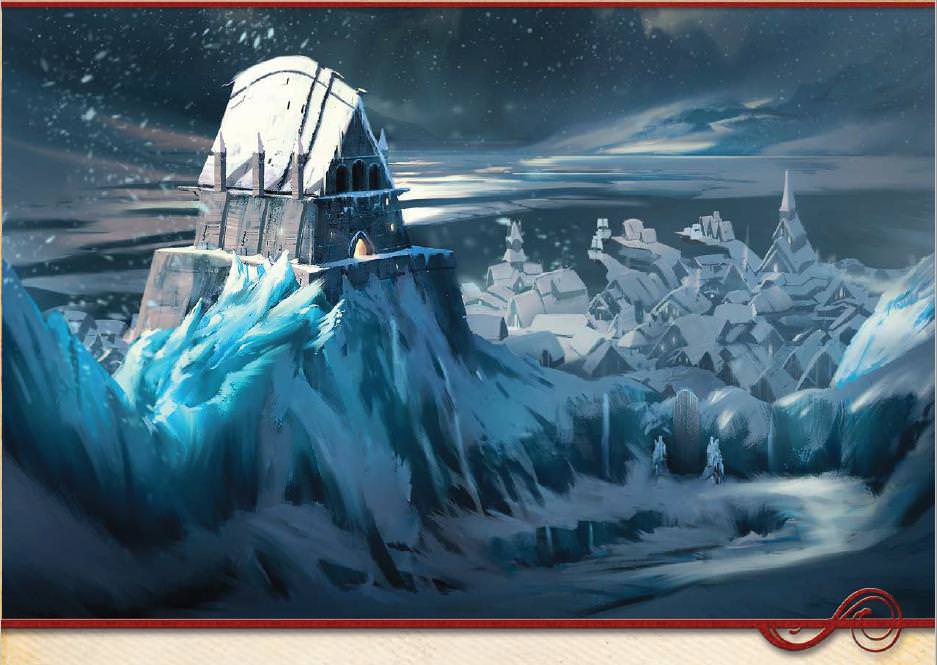
Björnrike is home to the largest gathering of bearfolk on Midgard. These anthropomorphic people reign over coastal plains and rolling halls, and the region's home to many bears of supernatural power prized as animal companions by druids and rangers. They live much like the Northlanders of other races, save that their feasting halls are much richer in honey and fish. The city of Bjeornheim sits by a coastal delta and river, using a network of ferocious beehives as a unique defense against monsters and raiders. As the city's inhabitants smell of honey, residents are immune to the bee's wrath. The mead brewed by Queen Yohana Honeyhair is known as the finest ale in the North, and many merchants brave trips here for the legendary taste.
METAPLOT: The Cult of Ragnarok's created a balm which can ward off bees and is deploying it in trade against the kingdom's enemies.
I love this country; now that bearfolk are a playable race in Midgard, Dovahbear is now a legitimate character concept.
The Bleak Expanse is the largest territory of the Northlands, stretching to the farthest reaches north to unexplored lands. It is a tundra where the god Boreas reigns supreme, who rules from a mountain known as the Tower of the North Wind. At its foothills lies the city of Geskleithron, where one can buy bottled magical storms and frozen souls and memories. Massive sheets of ice known as living glaciers animated by the wind god slowly make their way across the land and to the sea.
The rest of the expanse is populated mostly by hardy humans known as skraelings and some frost giants from Jotunheim. Numerous legends speak of lost palaces and tombs swallowed by the ice, and there's a small army of fire giants who live in a magically-heated region surrounding a geyser known as the Boiling Tower. The fire giant leader Aunvindri Against-the-Wind nurses an unknown grudge against Boreas and makes for an unconventional ally for travelers. Many an adventure found themselves indebted to the fiery warriors after being rescued from the Northern Wind's icy minions.
Huldramose is an unconventional land situated between the marshlands of two rivers. A pair of elfmarked queens claiming descent from the empire of Thorn rule here, and the majority of its population are trollkin along with a small number of humans and fey races. The realm is so named for the Huldra, women trollkin warriors who comprised the first valkyries among Wotan's ranks. It is traditional for women to train in the fighting arts here, giving rise to many shield-maidens. There are still those who doubt the effectiveness of female warriors, but Huldramose's veterans soon change their mind if they live to tell the tale.
METAPLOT: The queens of Huldramose found a sapling of a World Tree and are hiding it in a section of their royal household. Although they intend to keep it secret, its swift growth means that its discovery by the wider public is inevitable.
Jomsborg is an island home to a four thousand strong society of berserker mercenaries. A fair portion are out on raids or contracts from various rulers, but the rest remain here to train for their next deployment. They abide by a strict code of conduct to defend each other in battle, to never flee, and to not speak ill of their fellows (irresolvable differences are resolved by holmgang). They have a humans-only policy, and prospective warriors can join by undergoing several trials of strength and martial valor.
METAPLOT: A trollkin by the name of Solveig Rockhurler wishes to join the order and has challenged one of their members as part of the trials to enter. He is not the only trollkin seeking to join their ranks, and there is great debate over whether their requests should be entertained.
Jotunheim is the most formidable kingdom of giants in the Northlands, if not in Midgard. Its inhabitants believe their homeland to be the site of their slain progenitor Aurgelmir and despair at how far they've fallen in might. Its population lives much like the rest of the Northlands, save that everything is bigger and the fire and frost giants are capable of living in more inhospitable climes. Beyond the fire and frost giants are the thursir, a breed of artisans barely stronger than ogres and low in status. Then there are the Jotun, who comprise the largest clan in population. The Jotun are the ones closest to their progenitor's size and strength, towering over buildings and each born with incredible magical powers. The frost giants cluster in the northeastern hills, while the fire giants live in a volcano range known as the Blodejord ("Crib of Earth's Tongue")
In games mechanics terms, Jotun are CR 20 Colossal Giants (Midgard Bestiary for Pathfinder) or CR 22 Gargantuan giants with Legendary Actions (Tome of Beasts for 5th Edition). They are meant to be campaign-ending threats, and they comprise 13,000 of Jotunheim's 36,000 population. This is far and beyond the typical power curve even by Midgard's standards; there's quite a few high-level NPCs, but they tend to be rulers of nations or community rulers; as for the Mharoti Empire, its dragon rulers number only 500 and likely comprise all manner of age categories. Even Mharot himself is a CR 20 fire dragon. Given the fact that the giants are no allies of humanity or the major races, it doesn't seem like a practical realm for most parties to venture to barring campaign's end. And even then they would not be able to stand up to a community of Jotun barring some good optimization strategies.
METAPLOT: The Cult of Ragnarok established its base in this foreboding region by allying with Utgard-Loki, a Jotun of considerable power and fame. He gives the cult members a safe haven, but beyond his reach not all giants are allies of the Cult. Some do not wish for Ragnarok to come, while others distrust non-giants in their domain who aren't thralls.
Beyond the communities of giants sits the ruins of Ansaroth, unknown to any written history book. Its halls inevitably lead to a single spiral stairway. Trolls, trollkin, bugbears, and frost goblins in service to Boreas are stationed here to stand watch for unknown reasons. The cursed ruins' many strange sights, odd sounds, and mysteriously-missing bands of patrols are slowly turning them paranoid against each other. They now fight among themselves with little provocation.
The small island of Skaldholm is famed for its bardic schools, hot springs with healing properties, and relative peaceful ways of its inhabitants. Rulership is determined by contests of singing, telling of tales, and competitive exchanges of insults every nine years. The crowned Master of Thyles sits at the network of spies and informants, and his power to destroy reputations with a choice catchy song or rumor makes it so few dare to vex this king.
METAPLOT: The knowledgeable skalds were one of the first to learn of the rumors of a coming Ragnarok, and the Master of Thyles was about to discover the truth of the matter before Loki stole this piece of memory. He did it by tricking him into exchanging a secret for this piece of knowledge. This "Riddle of the Forgotten Thing" is now something the people of Skaldholm are trying to solve to no avail, and the Master sent out his best explorers across the lands to find the truth.
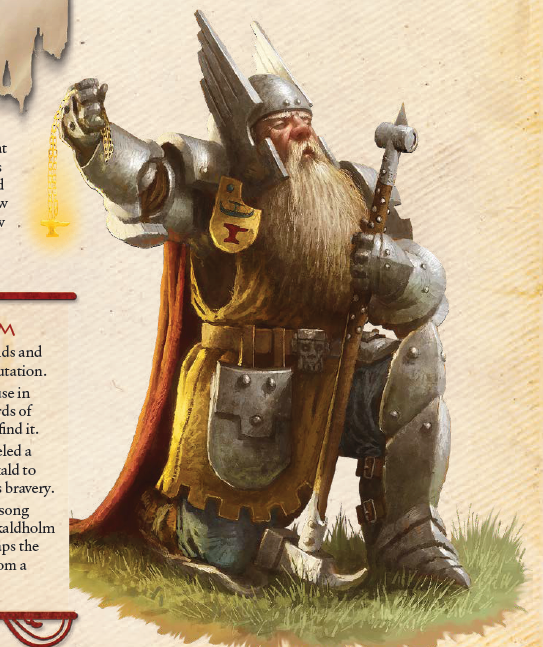
Stannasgard is the most open of the dwarven reaver kingdoms. Its mines form the backbone of its economy and the temples sport large priesthoods of Wotan, Thor, and Volund. Blacksmiths and artisans from the southern realms make pilgrimages here to have their tools and anvils blessed.
METAPLOT: Stannasgard was once a major shipbuilding center, but a mighty red dragon named Visandred the Horse-Eater destroyed most of the docks. This will take years to rebuild and since many of the ships were bought ahead of time by foreign sovereigns, economic havoc is inevitable. Additionally, recent arrivals of trollkin raiders from Jotunheim encourage the town to spend what little it has in its coffers to forge weapons for an eventual battle.
Tanserhall is the oldest dwarven city, home to the legendary Cradle Cave where the gods Volund and Thor breathed life into the first dwarves. The people of this realm are more pious than other reaver dwarves, and enact an elaborate sets of rituals to ensure both gods are placated equally to avoid the wrath that supposedly brought low their old kingdoms. Entry into Tanserhall is nearly impossible even for other dwarves, as a complicated layer of bureaucracy, purification rituals, and trap-filled mazes acting as bait for "impatient waiters" keep all but the worthiest out.
METAPLOT: Chernobog's monstrous spawn are arising in the Cradle Cave's deepest reaches. Their disease-filled maws can turn warriors into more of their kind with a bite, preventing the dwarves from enacting a swift end to their spread.
Thunder Mountain is a strange island of relative peace in the Northlands. Ruled by a dwarven cleric of Thor and former adventurer, it is also notable for allowing a significant minority of humans, huginn, and winterfolk halflings as equal citizens. This rankles the more conservative realms, yet none has summoned the courage to raid the place and because it is home to the Order of the Thunderer. The organization hosts a sizable number of clerics, paladins, and warriors of Thor who have the greatest track record in fighting giants and the Cult of Ragnarok's agents. Initiates are gifted with a silver hammer as part of their membership.
METAPLOT: Agents of the Cult of Ragnarok assassinated two of the Order's greatest members: the archmage Delric and the scout Timesh. The Order's stepping up a recruitment drive to make up for these losses.
Nearby Thunder Mountain is Reykurbrand Volcano, home to Sinmara the wife of Surtr. She rules a portion of mountain around the caldera, and it's believed that a portal to Muspelheim is deep within the volcano. Sinmara is dismissive of talk about Ragnarok, confident that her husband will stay safe as long as his favored sword Lævateinn (so central to the prophecies) is kept within a chest overseen by her.
Thursrike is home to the oldest structures in the Northlands, but alas most of them are inhabited by ogres, trollkin, and all manner of giants. They live upon vast herds of livestock and have trading ties with Jotunheim. They are not the only dangerous inhabitants here, as remohazes, white dragons, bands of yeti, and other monsters are common between settlements. The Cult of Ragnarok bases itself out of the fortress of Birgkrona, assisted by a contingent of giant allies. Other interesting locations here include Älvaträd, a living tree temple sacred to the Vanir with root-driven passageways, and the abandoned fortress of Kupparsheim which descends deep into a field of ice.
METAPLOT: A Jotun known as Laughing Kettil found that a bridge spanning a river gorge would make a nice backscratcher, and so he laid over the chasm for a rest. He hasn't gotten up in months, and seems oddly amenable to passersby using him as a bridge. However, he demands a toll in the form of a funny joke. In spite of his name, Kettil is a hard man to please, and he's not above squashing those who tell a really bad one. And even if a party's permitted to cross, his belly quakes from outbursts of laughter can plunge travelers to their doom.
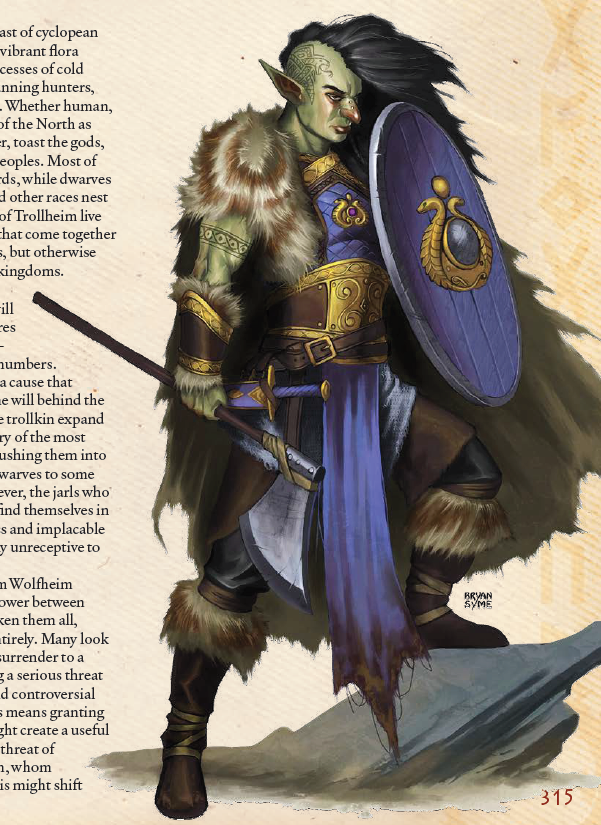
Trollheim is one of the largest realms in the Northlands by population, its fertile forest sheltered from the worst of the winter's cold. A cosmopolitan place of humans, trollkin, dwarves, and other races, they are some of the north's most enthusiastic fighters and consider themselves the best of all people. A World Tree called Wotan's Tree is closely managed by religious huginn, and those who earn their trust can find portals to other planes among its branches. Legend tells that Wotan learned the powers of rune magic here. Trollheim's largest city is Noatun, guarded by a magical wall created by Njord (one of Seggotan's masks) to keep the waves of the wild sea god Aegir at bay.
METAPLOT: For unknown reasons (but most suspect divine intervention) the trollkin are breeding true in unseen-of numbers. They are expanding their reach and encroaching on the territories of dwarven reaver clans, causing more of them to settle in Trollheim to better carry out raids against the invaders. This is upsetting the delicate power balances of the regions' jarls; Uffi Toothless, one of the most powerful of said leaders, is considering elevating a trollkin to jarldom as a goodwill offering. However, this is met with hostility from more than a few people quoting obscure poems foretelling a trollkin jarl as one of Ragnarok's prophecies. Additionally, it's been seven years since Jarl Asvaldr of the Havardr clan led a grand longship fleet to the southern realms. The fleet seemingly vanished, and the human population of western Trollheim are nearly leaderless from the loss of so many warriors and jarls.
The Vargrike is a realm inhospitable to the two-legged races of the Northlands. Here the lupine people rule, from werewolves to worgs to winter wolves, all united in their howling praises to Fenris (one of Vardesain's masks). Other races are tolerated only as food or slaves, and what few land is farmed and tilled here is by said slaves and sedentary werewolves. The Moon Palace is the only "city" here, and it is a moss-covered ruin where an ancient werewolf queen known as Wargaz the Cruel rules.
METAPLOT: The wilderness surrounding elven ruins of Thorn's outposts saw a large influx of fey beings. They've been causing a bit of trouble by curing werewolves of their lycanthropy. This is hardly a blessing as the ex-werewolves' rivals are quick to take advantage of their weakened state.
Wolfheim is an isolated dwarf stronghold home to the most conservative members of the reaver dwarf clans. They raid and feud constantly, making continual trips across the Neider Straits to seize thralls to put to work in their mines or oversee their reindeer and caribous herds. They have an ancient pact with local winter wolves and worgs, who serve the dwarves as guards and scouts. The monsters are under no obligation to defend the slaves, who by law are forbidden from killing a wolf or wolf-like monster even in self-defense. Dwarves from less warlike cultures often seek out Wolfheim to test their mettle or find solace in what they imagine to be "true dwarven culture."
METAPLOT: The occupation of Krakova by the vampire kingdoms is seen as a great trial by Wolfheim's dwarves. They established the jarldom of Wolfmark on its shores and are a thorn in the undead's side. Additionally, there's talk to occupy and cultivate the lands south of the ruins of Nordheim for more grazing spots and better trade with Wolfmark.
Fallen Kingdoms of the North and Other Locations
Due to the tumultuous nature of Northland realms, the region's kingdoms are home to countless former domains. Before the elves stole them, portals to Bifrost connected Midgard to Valhalla, the Plane of Spears, and other heavenly planes. Beyond petty jarldoms ended by annexation and war, the three most famous fallen kingdoms are below:
Aurvang was once a dwarven hold famed for holding Wotan's sacrificed eye and the holy shield of the dwarven maiden Grajvar. It was brought low when a family of fire dragons incinerated the place after a trade deal gone sour. Dragons still hunt the fauna around here and the nearby valley, but rumors of halls of treasure is a potent lure for adventurers.
Issedon and the Vanguard Kingdoms housed powerful wizards and warriors standing guard against the legions of Boreas. Their line of fortifications formed a wall-like structure on the border of the Bleak Expanse. The Northern Wind's minions could not bring them down, so instead he created the living glaciers to swallow their lands. But the people of the Wall still stand as undead ghosts and vættir ruled by an order of lich-commanders. Meanwhile, Issedon's sunken cities are populated by derro salvaging for artifacts, and a tower of this old kingdom has been unearthed along one of Trollheim's shores.
Nordheim was the greatest kingdom of the reaver dwarves which fell due to unknown circumstances. From the wrath of the gods to treachery from the elves, giants, Boreas, or even demons from the Ginnungagap are but a few of the wilder explanations. But the most popular theory's from a group of scholars in Skaldhome who propose that the people of Nordheim angered Thor in taking their slaughter to extreme excess.
METAPLOT: Several years ago the animals of the forest near Nordheim fled in vast numbers into Wolfheim. The reavers here sent a band of armed thralls to investigate, where they discovered a pit leading down into a temple home to an army of undead dwarves. The undead chased the thralls to the edges of the forest before retreating back to their domain. The skraeling tribes also speak of "ghost elves" in remote places in the mountains.
Our chapter ends with a list of miscellaneous locations in the Northlands for adventuring opportunity. They include the Isle of Buyan which holds Koschei's soul, a mobile cloud giant city so rich it's rumored their thralls live like jarls, the forbidden isle of Loki home to the trickster-god's minions, the Isle of Swords where the first holmgaga takes place and shield maidens oversee duels, ghostly Phantom Isles haunted by all manner of evil whose locations on the sea change place, shoals home to selkies that lure sailors to their doom, and barrow mounds where local communities give offerings to their undead inhabitants, and rumors of the fabled lands of Hyperborea in Midgard's utter north.
METAPLOT: Loki's servants guard an artifact known as the Loom of Fables. The loom is capable of employing powerful divination and illusion magic to monitor the Norns' threads and give false perceptions to prophets and sooth-sayers. The god erected a new hall to protect the artifact, which if destroyed will allow people to discover the truth of the false Ragnarok. Additionally, the Order of the Thunderer is researching a ritual to teleport people onto the Isle of Swords. They mean to draw members of the Cult of Ragnarok to the isle one by one, yet some worry that this ritual is in fact a trap laid by the cult.
Thoughts so far: The Northlands is overall a strong chapter. It manages to capture a Fantasy Scandinavia feel while having a healthy mix of political conflict, forbidding wilderness, and potential locations for dungeon crawls. The local cultures are varied enough to feel interesting and not be too one-note, although the kingdom of 13,000 CR 20+ elder giants stretches credibility even if they are far from united. Most of the region's metaplot is tied to the Cult of Ragnarok rather than a bunch of unrelated events, which may not be to everyone's liking. On the one hand, fans of the 2012 sourcebook can use most of the realm unchanged and provides an in-built villainous organization to oppose. On the other hand, said cult's wide reach steals some thunder from the other, more localized threats.
It has come time to leave the material world behind as we explore the Shadow Realm in Chapter 11!
The Shadow Realm
Original SA post
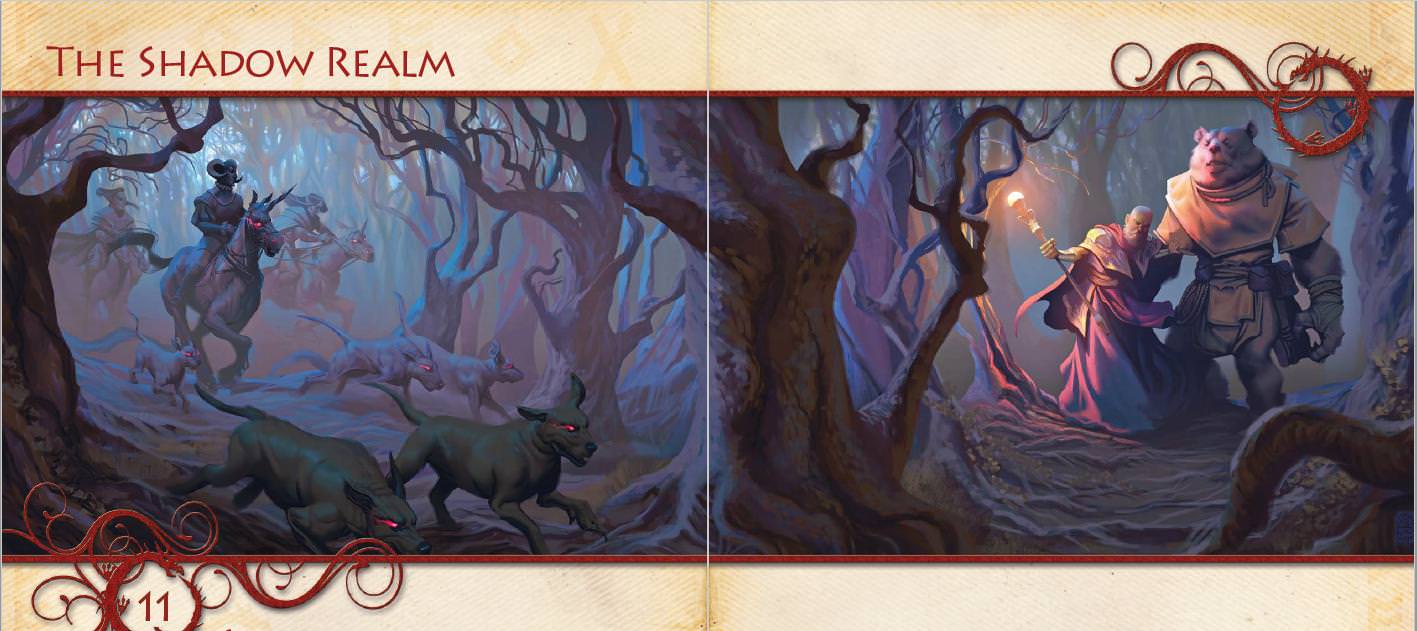
The Shadow Realm is not on Midgard proper. Rather it's beneath it, nestled between the sides of the disc Veles circles. It is here the Shadow Fey live, but they are hardly the only people who call this dark and dreary place home. The terrain is closely tied to Midgard, with numerous shadow roads connecting the two realms. Much of the geography is a dark and distorted mirror: a metropolis on Midgard may be a town full of shadow fey or umbral vampires, or even the ruins of where a thriving city once stood. The Shadow Realm is not underground; it has its own sky, although the heavens appear like a charcoal smear with no sun or moon, only twinkling stars whose light is quickly obscured by dark clouds. Spells also react differently: magic with visual elements may writhe with black veins, glow with sickly green or purple hues, and summoned creatures from this realm often have dark colors and malevolent eyes. Two new schools of magic developed from this plane: Illumination magic, originating among the shadow fey which has a dualistic nature between light and its absence, and shadow magic which taps into the plane's raw energy...often at a dangerous price.
The natural world of the Shadow Realm is warped, overtly alien in some places yet deceptively similar in others. There are flora and fauna here who operate much like mundane animals in behavior, but just about each of them bear an unmistakable taint of shadow. An owl may have a human mouth, and predatory animals such as wolves and bears are far more common here. Rivers and lakes do not bequeath water, but instead are rushing torrents of dangerous pure shadow inhabited by hungry spirits seeking to draw unwary travelers to a watery grave. Doomsand, which is found in deserts and marshy bogs, can fill those trapped with depression as well as its more physical dangers. Some areas which intrude into Midgard manifest as darker shadows which can even impede darkvision known as hungry glooms. There are rules for all of these, and wilderness survival checks to find non-corrupted food sources suffer disadvantage (5e) or a suitable penalty to the roll (Pathfinder).
Denizens of Darkness
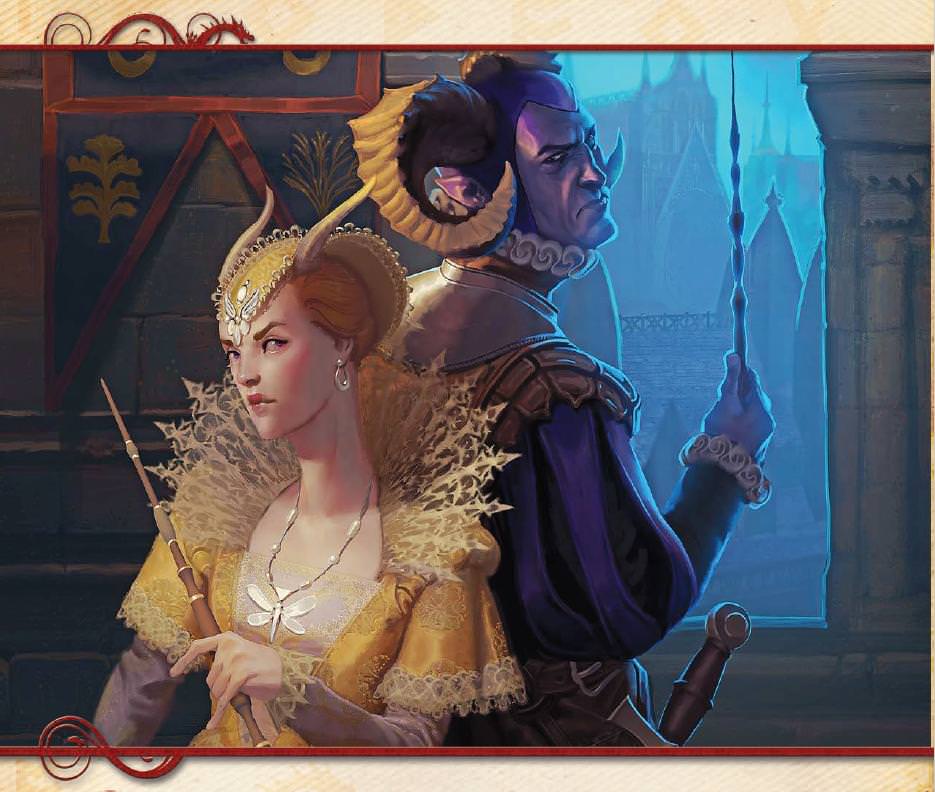
The shadow fey are perhaps the most numerous and well-known denizens here, but they are far from the only prominent nation. Beyond the innumerable monsters and warped animals, the major races possessing the means of civilization are umbral vampires, bearfolk immigrants, exiles from the Ghoul Imperium known as the Twilight Empire, a loose-knit organization of champions of hope and light known as the Lantern Bearers, and an enigmatic organization of astrologers known as the Court of One Million Stars. There's also glowing spherical constructs known as witchlights which often guide travelers to safe havens, although few managed to learn their origins or goals.
The Courts of the Shadow Fey are the main home of the namesake race, located on a high plateau in the heart of a dark forest. Their location corresponds to the Margreve Forest in Midgard, and the twin woods share many shadow roads between each other and exist in a symbiotic relationship. The shadow fey live in various towns and cities home to darkly beautiful glittering spires, impressive black stone bridges, marble colonnades, and beautiful gardens. Unless a traveler has the express permission of a high-ranking shadow fey, the communities appear seemingly abandoned. This is in fact the result of powerful illusion magic to confuse potential invaders, and only a true seeing or more powerful divination spell can detect the truth.
Shadow Fey society is a feudal model divided into the Lower Courts (goblins and servants), and the upper class among the Royal Halls and Winter Palace. There are two noble families, the Summer Court led by the goddess Sarastra Aestruum, Queen of Night and Magic, and the Winter Court led by the Moonlit King Ludomir Imbrium the XVI. As of now the Moonlit King has been banished and Sarastra Aestruum serves as the ultimate authority. She is a fickle tyrant, not known for patience and whose allies and enemies shift rapidly. The Courts have embassies with all of the other civilizations of the Shadow Realm save the umbral vampires who attack everyone else on sight. But the Courts are not the only power players: there's a secret society of shadow fey and allied creatures known as the Lords of Light, led by a blind angel Revich. They seek to oppose the influence of demons and other evils within their race's society and maintain contacts with Lantern Bearer enclaves. And there are cults lead by demons known as the heralds of darkness who seek worship and can turn willing supplicants into shadow fey.
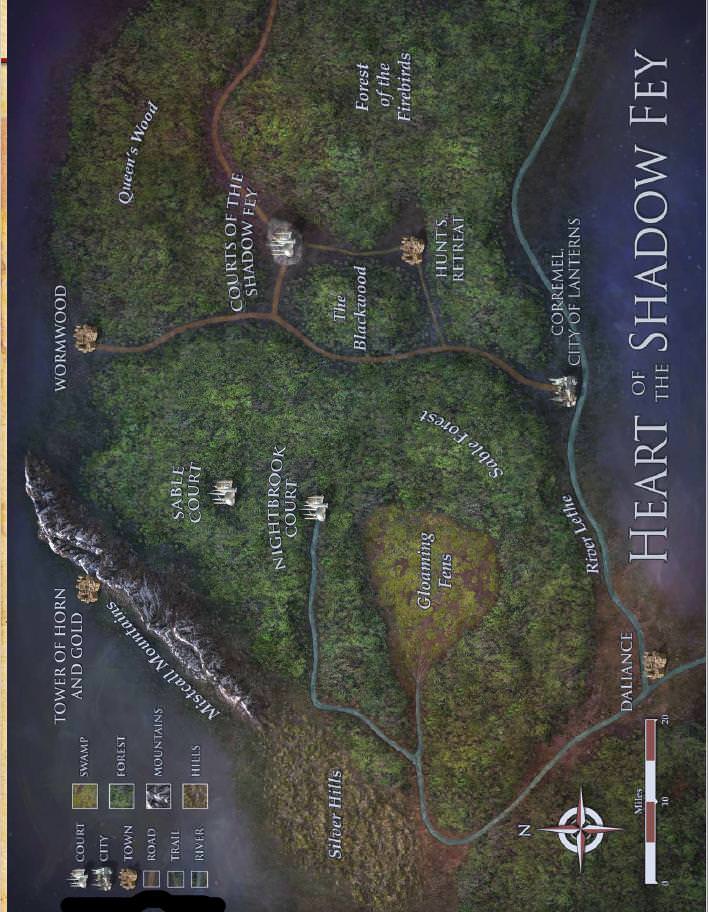
The major locations of the Courts of the Shadow Fey include Corremel, City of Lanterns. The settlement's a trade haven favored by dishonorable professions such as smugglers, slavers, bounty hunters, and other occupations of varying scruples. Its holds one of the few bridges safely crossing the river Lethe and corresponds to Zobeck's location in Midgard, and also has a shadow road connecting to a Nurian city also by the name of Corremel. Dalliance is a town famed for catering to pleasure and vices of all kinds, no matter how taboo. Hunt's Retreat is a dangerous forest favored by shadow fey nobility as well as the Lord of the Wild Hunt. Nightbrook Court is home to a trio of hags who look for the souls of evil people to trap in the river Lethe and turn into enslaved shades. They create these monsters out of mortal memories of pain and anguish, and are not above creating such memories themselves to drive grief-stricken mortals into surrendering them to make the suffering stop. The Sable Court is overseen by some of the Courts' best hunters and assassins. The Tower of Horn and Gold is the Courts' Fort Knox, responsible for mining shadow-tainted gold which is rumored to make mortals who accept them slowly give up their will and soul to the faeries. Finally, Wormwood is a walled fortress city serving as a barrier against the umbral vampires of the City Fallen Into Shadow.
Oshragora, the City Fallen Into Shadow was once a grand realm of spellcasters who used their mastery of time magic to create grand works of art and architecture. But their excessive tampering with the river of time ripped their civilization from Midgard into a closed time loop to be devoured by Shadow, reborn and consumed countless times over. When the rogue magic finally abated, there was only Oshragora, a ruined and twisted landscape inhabited by creatures known as umbral vampires. Not the conventional blood-sucking kind, they drain life and vitality from the smokelike darkness emanating from their eyes, mouths, and noses. They are not ones to talk, but those few who manage to coax a conversation out of them find they make references to times and places that do not exist...or have yet to happen. Their leadership organization is unknown, but the Queen of Night and Magic promises an emperor's ransom for the first person to establish a reliable connection to the umbral vampires' leadership meetings. The darakhul of the Twilight Empire often make risky expeditions into the city on the hunt for a lost artifact known as the Eye of Veles.
Oshragora often extends its temporal reach to other times and places in sections known as "splinters," which can bring back inhabitants from the far past or distant future. A splinter can range in size from a small building to an entire neighborhood. The bearfolk of the Moonlit Glade are researching into how the splinters function so as to better guard against them, as they are Oshragora's most potent means of extraplanar invasion.
The Moonlit Glades are perhaps the least corrupted civilization among the Shadow Realm. It is inhabited by bearfolk from Björnrike, descended several generations down from warriors and druids who bravely ventured beyond Midgard to fight back the corruption infecting their kingdom. Their children's children still carry on the charge, and the fact that they (mostly) managed to avoid planar corruption is regarded as nothing less than a miracle. The Glade is unsurprisingly connected where the Nieder Straits would be in Midgard, and the terrain here is much closer to their northern homeland. Rivers are made of drinkable water and not shadowstuff, divine spellcasters of Freyr and Freyja (masks of the Green Gods) dedicate their lives to producing edible food free of shadow corruption, and a moonlit sky provides ample natural light. A network of rangers and druids maintain lines of communication between villages via a messenger service, and the place is home to immigrants of other races from the Kingdom of the Bear as well as renegade shadow fey.
The Glade's form of government is managed by two independent authorities: a war officer tasked with defense, and a hierophant who manages magical affairs. Gulfwyr Moonrage fills the role of the former, a werebear who has accomplished many legendary feats in battle. The latter is filled by Ernalda Berlasdottir, the most powerful druid in the Glades who seems to be out of touch with the world around her. Her seeming dream-like state is in fact due to her never-ending vigil in maintaining the magical barriers holding back the corrupting forces of Shadow.
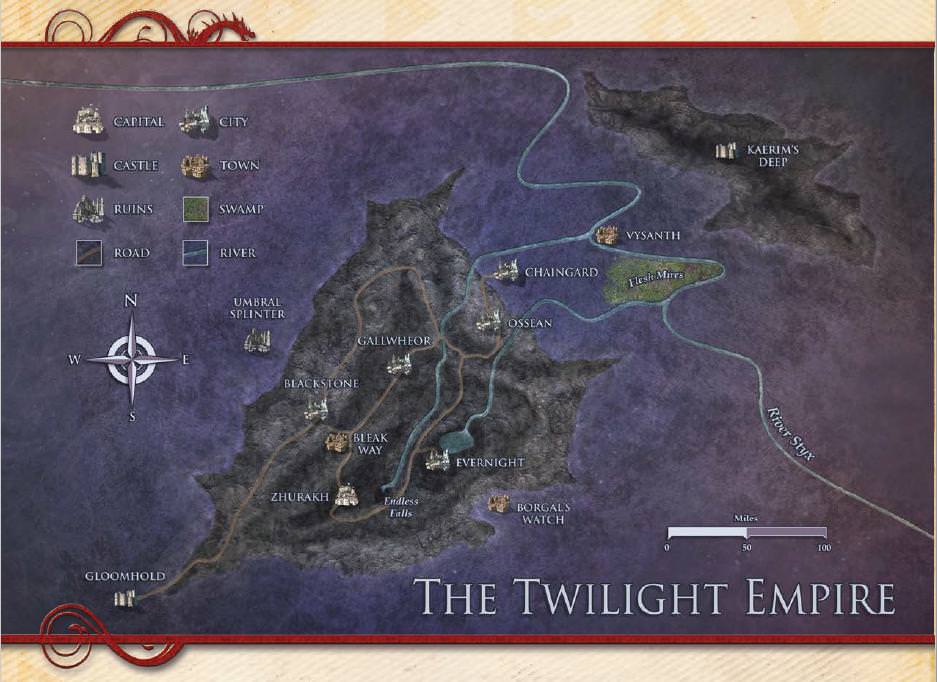
The Twilight Empire is composed of the remnants of Vilmos Marquering's Iron Legion, a group of soldiers in the Ghoul Imperium who plotted a coup against the establishment. It did not work out well for them, and they were pushed out into the outlying caverns far beyond the nation. Marquering led his people into a region later found to possess strong connections to the Shadow Realm, and thus the Twilight Empire was born. As a result their previous losses as well as being in a hostile new realm, the Empire is a military junta where Vilmos' top five generals command a major city within their domain. Most of its environs are located in a series of dark rifts known as the Black Iron Depths, located where the Ironcrag Cantons would be on Midgard. Vilmos is a paranoid ruler, who ensured his generals' unwitting loyalty with mithral bracers recovered from a nearby strange ruin. The enchantment of the bracers is that any general who tries to turn against him will elicit a violent rage in the rest of the ghouls who will then seek to slay them. The Twilight Empire maintains a strict ration diet for its citizens, and they regularly raid the other civilizations for food and slaves (often the two go hand in hand).
The major cities include Zhurakh, which is the capital and filled with the Empire's most elite soldiers and secret police, the Blackmaw Legion; Blackstone, provider of the Ravenous Legion, the Empire's shock troops; Chaingard, a major focus for the Empire's save trade overseen by the Shackled Legion; Evernight, the center of faith with a grand cathedral to the ghoul god and warrior-priests among its Midnight Legion; Gallwheor, provider of the finest tactical minds among the Headsman Legion; and finally the city of Ossean, whose buildings are made of bones and is the center of necrophage arcanists who supply the Bone Legion with magical might.
The Empire has a deal of sorts with the Courts of the Shadow Fey: in order oto gain passage along their shadow roads, ghoul soldiers serve as security for the more dangerous/at-risk roads. Right now the Twilight Emperor's primary concern is researching the umbral vampires, and via sanity-rending divinations into the minds of these monsters Maquering discovered an artifact known as the Eye of Veles which can grant one mastery over time and space. The ghouls do not have the resources for a full-scale invasion, so instead they rely on scouting parties into Oshragora for now.
Witchlights manifest as white spheres which drift among the misty swamps and dark forests. Although bearing a resemblance to a will o'wisp, their intentions are mostly beneficial in the form of lighting the way to safety in the most dangerous places in the Shadow Realm. Witchlights can be created by powerful wizards, but this cannot account for the sheer number of them roaming the plane. They communicate by strobe pulses and can defend themselves with searing blasts of light. Although most are benevolent, some witchlights corrupted by ghouls are possessed of foul intent and intentionally lead people to danger, using their light attack to sever rope bridges and ladders at their most dangerous point.
As for their relations with the other groups, some ally themselves as familiars to shadow fey sorcerers, disguising themselves as gleaming jewelry. Umbral vampires find their presence odious, while the ghouls of the Twilight Empire seek to capture them and perfected a ritual to turn them evil. The witchlight's only area approaching a settlement is an island known as the Light of Knowledge. Here on this island is a structure much like a library, but instead of books among its shelves there are multicolored stacks of light arranged in an orderly fashion. Witchlights can transfer their own knowledge to these stacks by adding a bit of their own light to it, and brass and silver constructs serve as managerial duties. The liosalfar, or light elementals, serve as security against any who would damage or corrupt the Light of Knowledge to foul ends.
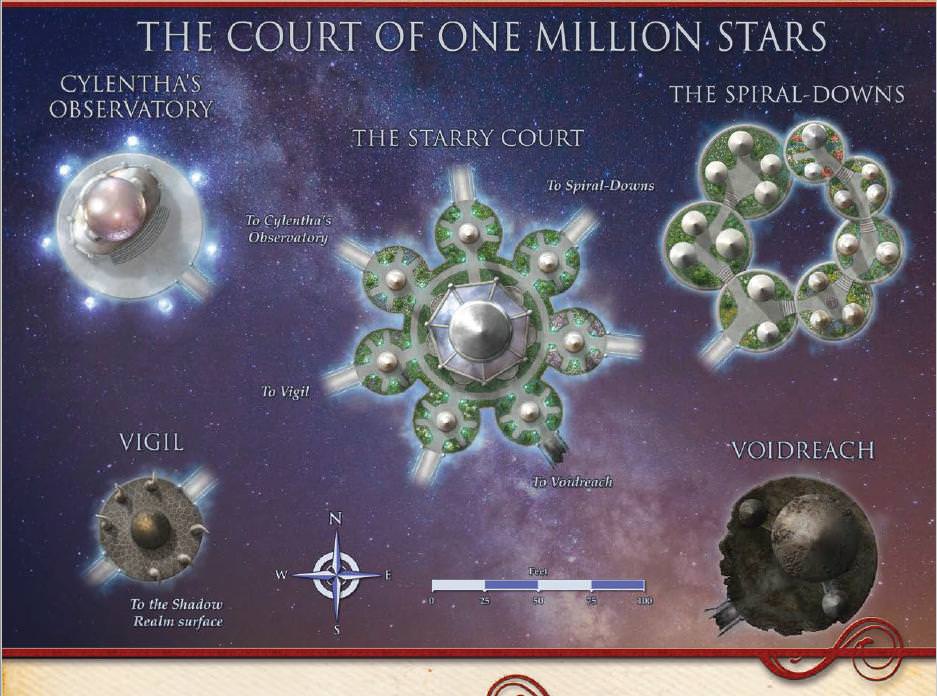
The Court of One Million Stars is our last location within the Shadow Realm, a beautiful airbone cluster of spherical, domed buildings flying in the sky. Pearly-white stone gates link clusters of buildings via walkways, with the more prestigious inhabitants living closer towards the center. The largest residential spires are known as the Spiral-Downs which connect to each other via staircases made of moonlight. Each ascending level is home to more beautiful features such as buildings made from starlight and dreams. The court is home to beautiful gardens containing plants from the Shadow Realm as well as Midgard, and fey of all kinds (not just shadow fey) are frequent visitors. The Court's primary function is for those seeking to study Illumination magic, the stars, and celestial movements. To this end many of its domes provide a perfect view of every star, celestial cloud or nebula, and even the farthest reaches of the utterdark and the Void. The Courts' more notable inhabitants include Prince Valendan, an oddly non-evil selang and accomplished wizard of Illumination magic; Cylentha the Silver Mistress, a star* who descended down to Veles' encircled realms for unknown reason and serves as the Prince's adviser; a friendly yet insane void dragon named Phaerliggath who's eager to teach supplicants about Void magic and who Lady Cylentha does not trust.
*We learn more about the stars of Midgard. When they land on Midgard or the Shadow Realm, they take the form of cloaked, hooded humanoid figures shrouded in an aura of starlight. They have their own language, and even those who communicate with them via magical aid find their manner of speech confusing. They often reuse terms, but with vastly different intended contexts and meanings even within the same statement. "The Void calls to the Void. It must not be allowed to answer" is one lf Lady Cylentha's few warnings about accepting Phaerliggath's tutelage.
Entry to the Court is not an easy task. Witchlights can form bridges of solid illumination provided it trusts a traveler. Warriors of the Court guard gate houses which can form star-bridges leading up to the spires at certain times of the year. The most famous (and well-guarded) house is known as Vigil, a hovering disc whose gates are nearly indestructible by either mundane or magical means.
One of the most powerful denizens of the Shadow Realm may not be the leaders of the aforementioned nations, but in fact a dragon known as the Endless Hunger. Vizorakh the Ravenous is the oldest cave dragon in existence who embraced lichdom via a ritual. His phylactary is an onyx gemstone the size of an elephant, and he prolongs his existence by hunting down other cave dragons in the depths of Midgard to add their souls to his phylactary. He frequently joins the Twilight Empire's expeditions into Oshragora as a disguised ghoul for unknown reasons. Beyond this his schemes are considered mysterious and spanning centuries, and he frequently meddles in the workings of the other factions of the Shadow Realm.
Thoughts so far: An interesting thing to note is that the Shadow Realm did not have its own chapter in the 2012 setting book. Thus the reason I did not include any METAPLOT mentions. But overall it's a grand addition to the updated Worldbook. In most campaign settings the Shadow Plane or its equivalent is a one-note "dark place of evil and undead" without much variety. Here the civilizations/factions are varied, full of adventure material and good writing, and interact with each other in interesting ways. I did like the thematics of duality between light and darkness present throughout the chapter, such as the Court of One Million Stars, witchlights, and illumination magic. This makes sense of a sort in that shadows cannot exist in complete darkness.
We're done with the realms of Midgard, but the party's not yet over! Join us next time as we meet and greet the divine Pantheons!
Pantheon
Original SA post
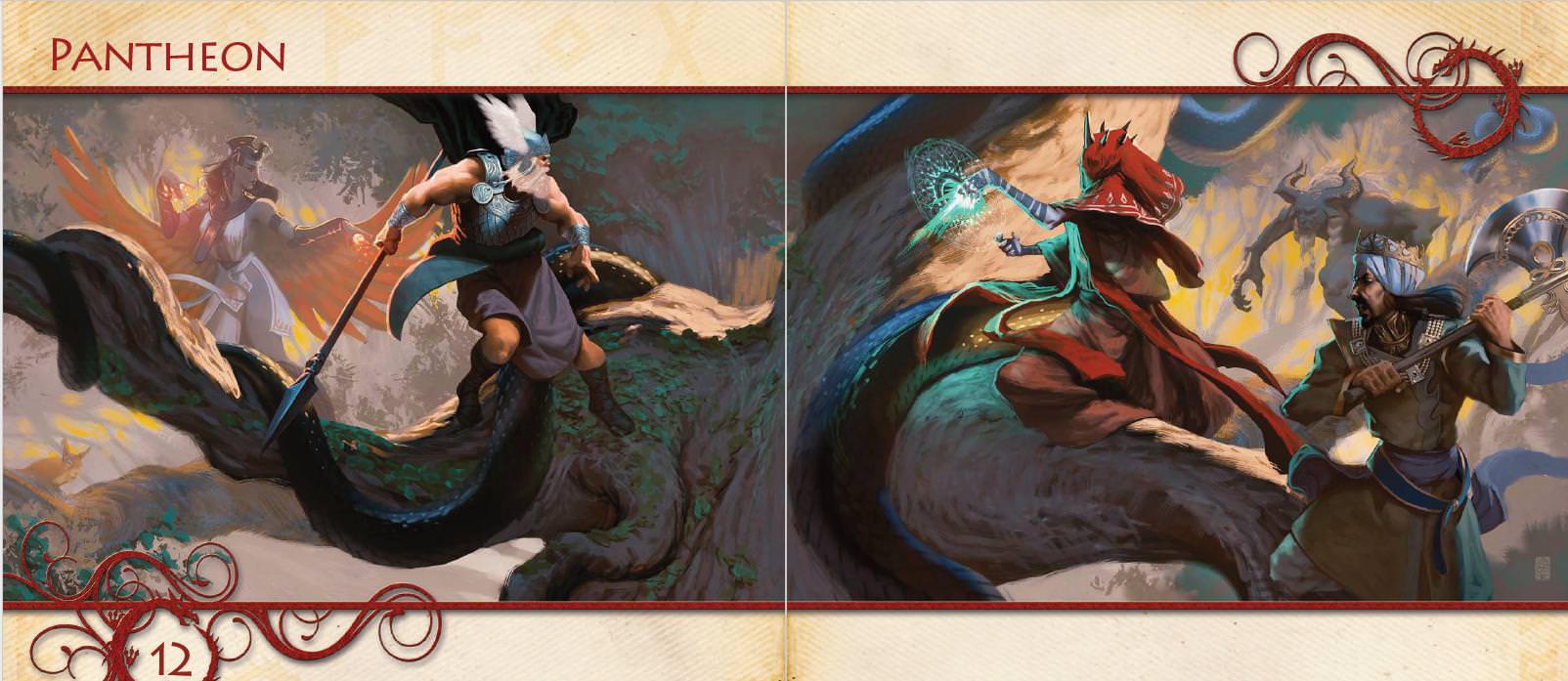
The gods and goddesses of Midgard are not timeless, eternal entities. During the era when Veles created and encircled the world of mortals, there were no gods. It was a prehistoric time where the few races that did exist were just developing the spear and the secret of fire, and the only kinds of spellcasters were druidic pseudo-priests who could speak to the dead. This all changed when Wotan bathed in the blood of a slain dragon and learned the secrets of godhood. He climbed the World Tree, learned rune magic among its branches, and he uplifted his fellow priests to become what we know now as the Northlands pantheon. Although they took pains to guard their wellsprings of power, Loki betrayed his fellows by granting the secret to his lover Bastet in the southern realms. From there more gods and eventually pantheons arose, and it was a time of great war and chaos. The specifics of history are highly biased as the current gods and their followers accuse the others of all forms of misdeed.
But what is agreed upon is that Veles issued an ultimatum for the gods to no longer war openly. Instead they would wear masks and act through mortal champions and divine servants. This created a near-universal tradition among the deities of Midgard: a "mask" is not so much a literal garment as a deity taking a different form, title, and even domains and moral codes for their followers. There are still some similarities, and gods with some overlap in themes (such as Thor and Mavros) are often believed to be masks of the other. Not only does the tradition of masks prevent an accurate estimate of the true number of deities, it also allows a god to extend their influence to other cultures without the stigma and restrictions of the host faith. In fact, it makes it easy for a deity to fake their own death, only to masquerade by another realm in another culture of Midgard.
Pantheons are generally grouped by geographic and racial territories: Northern Gods, Crossroads Gods, Dragon Gods, etc. This is not uniform, and various countries and city-states may swap out a certain deity or two in favor of one closer to their needs: an example is the worship of the Nurian god Thoth-Hermes in the Magocracy of Allain, whose emphasis on written lore makes him popular there. Sages claim that only 30 true gods can exist at a time, and only five within a great city, six within a great kingdom. More than this causes excess deities to fall into the ranks of demons and angels; still powerful, yet not true gods. The aforementioned realms of previous chapters hew to this format, with many countries and city-states with a listed regional pantheon of five deities (sometimes 4 or 6). They also mention the masks of a deity who goes by a different name in said place: for example, Wotan is honored in Ishadia by the name of Az, as is Perun who goes by the title Mavrash.
Pantheist Worship: Most lay worshipers and divine spellcasters do not serve a single deity; instead they pay homage to a cultural god who most closely meets their needs at a certain point in life. In fact, both the Pathfinder and 5th Edition system supplements provide mechanical options for a Pantheist Priest. They are basically clerics, but instead of a single patron deity they worship five gods of their kingdom/region/city-state as a whole. Once every one or two weeks (depending on system) they pledge themselves to a single deity, gaining the domains and code of conduct of said deity. After the weeks' duration they switch to a new god to repeat the process anew. As deities even within the same pantheon can be at odds, violations of dogma only count when a pantheist priest is pledged to that specific deity during the time frame.
The exceptions to pantheist worship are the Dark Gods and the Southern god Aten, who are too jealous to share their worshipers with any other gods.
Design Notes: The author Wolfgang Baur is not as much a fan of the classic good/evil divide, instead preferring Midgard's gods to be akin to amoral forces of nature concerned with their domains of influence rather than championing Law, Chaos, etc. However, he acquiesces to the "requirements of role-playing games" and has most gods with a partial alignment axis. Instead of being Lawful Good/Lawful Neutral/etc, Wotan of the Northern pantheon is merely Lawful and clerics may be of any Lawful alignment. There are a few deities who have a traditional alignment (Khors is Lawful Good). Baur also notes that alignment-specific domains are optional in Midgard.
I agree and disagree with the above. While it is true that the vast majority of deities in Midgard do not have alignment-specific domains, the exception are the Dark Gods, most of whom are quite clearly antagonistic and have the Evil domain in Pathfinder. It makes playing a Pantheist Priest impossible alignment-wise, as quite a few pantheons have deities of diametrically opposed alignments: Wotan/Loki, Baal/Azuran, and Horus/Bastet are Lawful/Chaotic, while Ceres/Hecate are Good and Evil. Finally, the stat blocks within this Worldbook show important NPC clerics who are two steps away from their patron deity in multiple places. This includes several Lawful Good Ironcrag and reaver dwarf priests of Voldun (Neutral). In Nuria Natal, the Reborn Queen-Goddess Meskhenit is a Neutral Evil cleric of Bastet (Chaotic). Meskhenit in particular had this same alignment in the 2012 sourcebook as well as the 2015 Southlands Campaign Setting expansion. The sheer repetition of such examples points to intention rather than accidental typos, and indicates that Baur desires for clerics to be unrestricted by alignment. If anything, choosing to keep partial alignments has only weakened internal consistency.
The entries for deities are grouped by pantheons of related figures with rather detailed entries. Just about every god has an illustration, cleric domains for both Pathfinder and 5th Edition (and subdomains in Pathfinder's case), mechanical elements such as alignment and favored weapons, and fluff background with entries for common worshipers, holy symbols, notable books, their faith's common temple locations and designs, their suspected masks, relationships with other deities, and what the god demands from followers. The last part is important, as it is the deity's code of conduct and failing to abide by it results in a loss of class features for divine spellcasters. Some deities have codes easier to follow than others. For example, Loki has no tenets beyond "do what you think would amuse me," while Anu-Akma forbids tomb-robbing and stealing from corpses which is a heavy burden for most D&D adventurers.
The Great Serpent
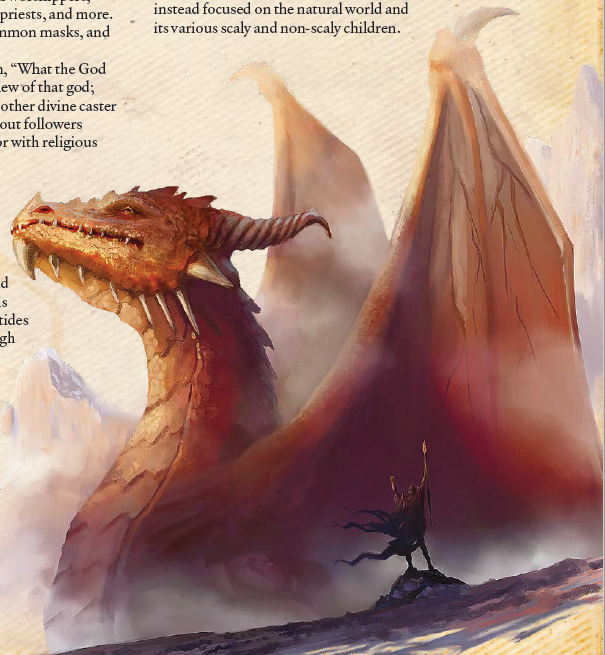
Veles is special enough to be an entry all his own. The great World Serpent defines the edges of Midgard as a coiling dragon-god biting his own tail. Veles is most well-known in the Northlands and the Mharoti Empire, although he is not worshiped elsewhere. The tides of the sea are due to his breath and storms originate from his great snorts and sneezes. A few sailors of the western seas claim to have seen his body in the form of a gigantic moss-green scaly wall in the ocean. Veles does not demand much from his worshipers and is unconcerned with rewards in the afterlife; instead he charges his few followers to take a nihilistic doomsday preparation outlook and ensure that the ley lines run smooth.
Northern Gods
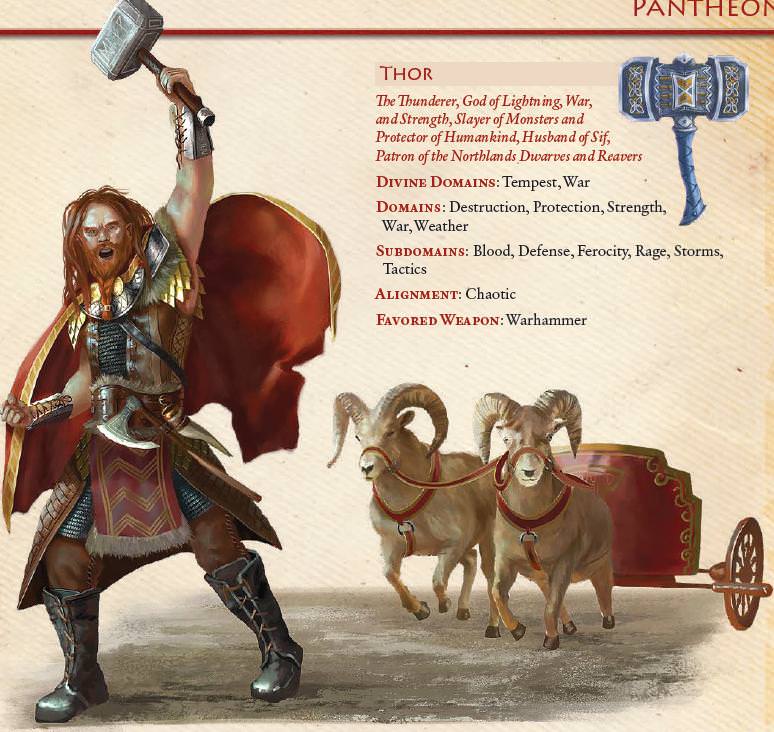
The gods of the Northlands are the oldest known pantheon in Midgard. They are men and women of action, who fight hard, party hard, and demand the same of their followers. Being a priest is not considered a full-time occupation, and clerics/druids/etc often belong to a more mundane occupation in their day to day life. Besides the dwarven worshipers of Thor and Volund, temples do not really exist save in consecrated ground of a deity's portfolio: battlefields, thunder-strewn mountaintops, etc.
Freyr and Freyja are twin deities often worshiped together, who hold sway over fertility, magic, and farming. They gather fallen warriors to form an army for the Vanir. It is believed that the two are masks of Yarila and Porevit of the elven pantheon, or vice versa.
Loki the Trickster is a man of many tales, a confusing web of lies, half-truths, and truths which but create more questions. He is many things the Northlands pantheon is not: duplicitous, allied with giants and monsters, and prophesied to betray his kin Baldur and bring about the twilight of the gods. He is most known for his mastery of fire and supposed invention of the net, two aspects of life vital to the Northlands' cultures.
Sif is the wife of Thor and just as skilled in battle. The bow and arrow are her weapons of choice, and she is the leader of valkyries and shield maidens. She is worshiped in Perunalia and the patron goddess of Huldramose, and has a following in Krakovar due to the heroism of Saint Adelind against the undead occupiers.
Thor is the larger-than-life champion of human and dwarfkind. Not a god to sit and wait for adventure to come to him, he rides across the planes in a goat-driven chariot, striking down giants and other monsters with his signature hammer Mjölnir. Thor is a popular god in the North, worshiped by reaver dwarves, vikings, warriors, and those who seek to drive back the monsters of the night. It is widely believed that Thor, Perun, and Mavros are all masks of the same god, but there is a rivalry among cultures of which one is the "true face."
Wotan is the wise leader of the Northern pantheon and the one who started up all this godly business in the first place. He is a man associated with magic and wisdom, who gave his eye for wisdom and learned the mysteries of the universe from runes. He is also master of Valhalla, a gathering of the spirits of great warriors for the upcoming Ragnarok. He tends to be a god most Northlanders come to later in life, with the brash and young favoring other deities. But ravenfolk of all ages adore him, both for his wily nature and close association with ravens.
Baldur is a popular god of the North, although he is a mask of Lada who is detailed in the Crossroads entry.
Crossroads Gods
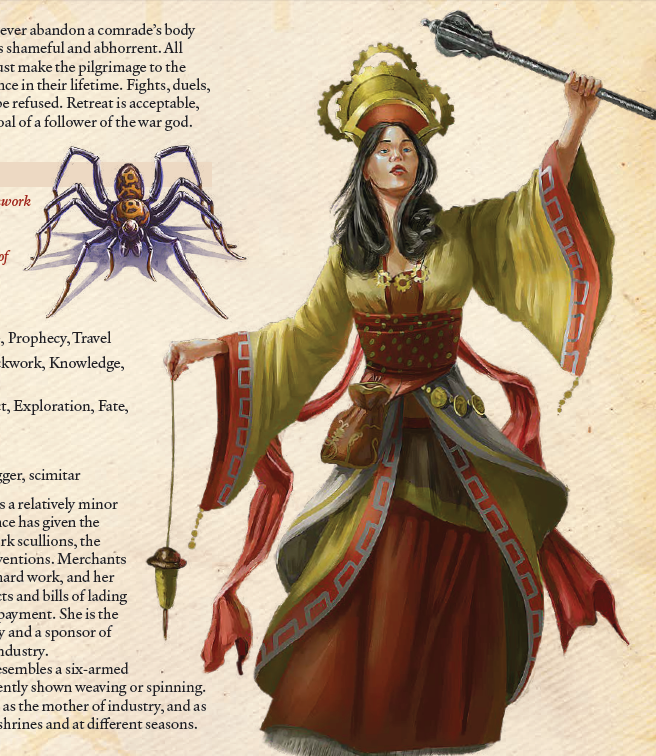
The gods of the Crossroads are a diverse bunch, given the regions' geographical centrality. The common conception of a "united" pantheon is a recent one, and gods and goddesses came and went in popularity, some given up once mortals found more suitable patrons or suffering death, enslavement, or adopting a new mask. The elven gods were once popular, and Khors was once considered the king of the pantheon but finds his worship fading outside of Grisal and the Magdar Kingdom. Rava's dominion over the gearforged and advanced technology marks her as the rising star of the region. More than any other realm, the faiths of the Crossroads are fluid.
Khors is your stereotypical Lawful Good deity of knights, light, and justice. His priests number among many knightly orders, and his main focus is on safeguarding people from mundane and supernatural evils.
Lada is the goddess of dawn, love, and healing. Her pacifistic teachings are standards most cannot live up to, but she and her faithful are held in high regard. Her priests operate public works projects such as hospitals and shelters for the poor and at-risk children and mothers. Lada's followers believe in voluntary euthanasia for those whose suffering is beyond the ability of divine magic to cure, which is the most controversial aspect of her faith.
Perun is the god of war and thunder, who also governs the cycle of birth and cleansing of the soul. He is closely associated with Mavros who is believed one of his masks (they even share the same code of conduct), and as such his worship extends far beyond the Crossroads. His priesthood is 80% male, save in Perunalia where women warriors predominate.
Rava (Ariadne) is the patron goddess of Zobeck and oversees knowledge, industry, and technological innovation. She is closely associated with spiders, often portrayed as a six-armed weaving woman. Although credited with the creation of the gearforged and closely associated with clockwork artifices, she is worshiped by alchemists, scribes, weavers, and other artisans. In Zobeck and the Crossroads she is known as Rava, but in the Seven Cities and southern realms she goes by the mask-title Ariadne.
Volund (Svarog) is the god of earth and fire, one of the patrons of the reaver dwarves. He is closely associated with smithwork but also governs family, hospitality, and marriage. Among the Rothenian Plains the Kariv and Khazzaki hold him as a patron of horses, and the former have a creation myth of how the god stole the first horses from Boreas and taught mortals how to tame them. Volund is one of the most widely-worshiped gods and thus has many masks.
Dragon Gods
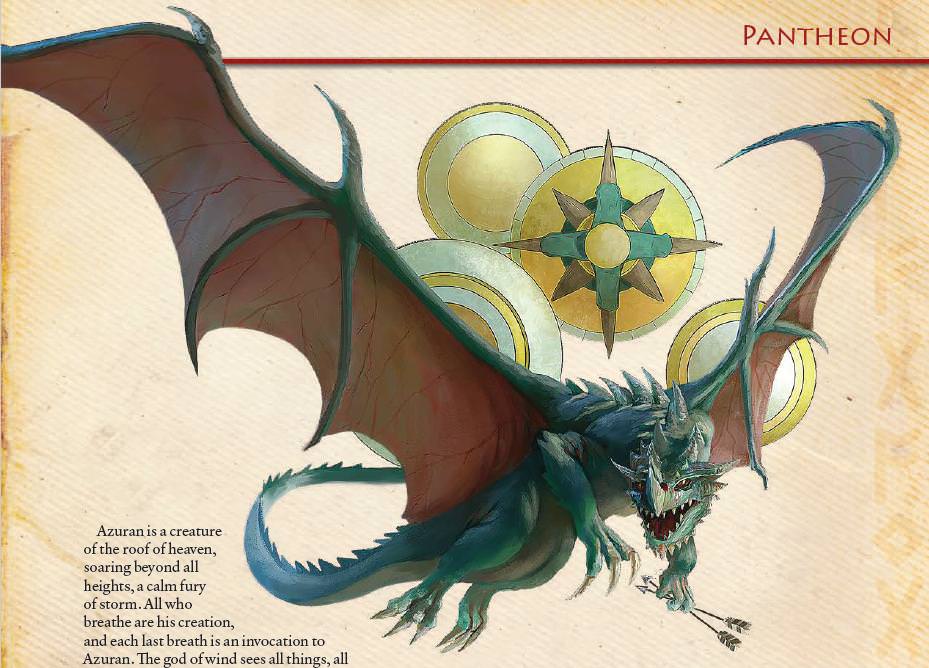
The gods of the dragons are closely tied to the four elements and considered to be the literal children of Veles. They are not widely-worshiped outside the Mharoti Empire, but thanks to said empire's sheer size and number they are powerful and popular religions. Astronomy is a common practice among worshipers.
Azuran is the four-fold god of the winds, closely associated with life, for it is said among the faithful that "all who breathe" are of his creation and every last breath is Azuran taking his due. The god's sects are divided into four directional winds. The East is associated with fate and fortune, the West with battle, the South knowledge and wisdom, and the North travel and wandering.
Baal is a fire god considered the patron of the entire Mharoti Empire. All nobles of this realm worship him, and in turn he protects their divine right to rule. Many martial orders pay him homage, and his priesthood is heavily entrenched in the empire's bureaucratic institutions. His teachings are in no holy books, and instead his teachings are learned from a special order of priests known as the Baal-Shek. They recite his 444 sacred stories daily in order to maintain clear memory.
Khespotan is a primordial deity of the earth and originally not a dragon at all. A dragon once swallowed him, and the god fought back from inside its belly. Khespotan absorbed his would-be devourer from within and emerged as one of the race's own. He stores millions of souls in flawless gems, all located within a great vault deep beneath the earth. Although not as active as Azuran and Baal in the mortal world, his faithful serve a vital function in funerary rites and burials: their temples provide free gravesites to the poor, dragonkin and non-dragonkin alike.
Seggotan is the dragon god of the sea, rumored to have existed since reality's creation and will continue to do so until the end of time. He is a keeper of oaths, and his word is spread to the faithful via sea drakes known as Kyree. His holy verses take the form of songs written on sheets of silver foil, although there is no grand collection and many groups fight for control over the records. The reality is that the Song Pearls the sheets are transcribed from are dangerous to all of creation if combined together, thus the need for their scattering.
Elven Gods
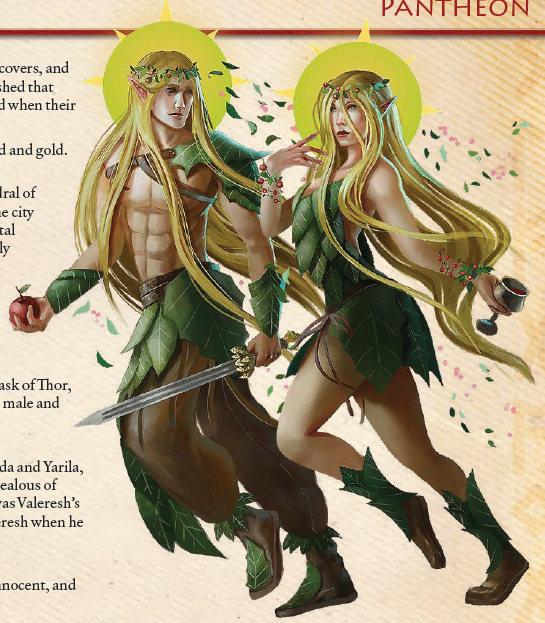
The gods of the elves were until very recently nearly forgotten among the peoples of Midgard. Their temples fell into ruin or where converted to other faiths. The only exceptions are Sarastra, the goddess-queen of the Shadow Fey who seek to make their move in Midgard, and the Church of Yarila and Porevit in the Grand Duchy of Dornig. The knowledge of other major gods of the elves are now returning with immigrants from the Summer Lands.
Baccho is a whimsical god of poetry, wine, and madness. The Great Retreat hit him the hardest, and many of his faithful left behind in Midgard fell into a deep despair. His sacred teachings are many and self-contradictory, leading to factionalism and divergent faiths among his followers. What's ironic is his code of conduct is both short in comparison to others and quite hippy-ish: "Make art, and celebrate life to the fullest. Leave no stone unturned and unpainted. Rage, love, and make your mark on all things. Embrace the dragon and the lamb; both are your children."
Holda is the mother goddess of all elves and oversees the seasons, hearth, and harvest times. She taught her children ways to create magical clothes (cloak/boots of elvenkind), and although much of this lore has been forgotten they still have a reputation as expert tailors. Her teachings are a mix of good living and natural conservation, with some holy book's containing farmer's almanacs and diagrams of ley lines.
Sarastra is the patron of the Shadow Fey and the elven goddess of night and magic. She has no grand ideology or plan, instead driven by petty vendettas and fleeting whims. Her holy book is a tome of confusing puzzle-like riddles for her worshipers to figure out her desires. She encourages followers to master magic and the tools of deceit and for the latter her faith is outlawed in many regions. She counts many enemies among the other deities, but oddly enough she and Hecate are on neutral terms in spite of both faiths having deadly rivalries. This leads some to suspect one is a mask of the other.
Valeresh is the honorable elven god of battle, his order famed for the creation of great and powerful magical weapons. A handful of them still exist in protected vaults of the former Empire of Thorn in Midgard, but otherwise the legacies of his teachings, holy books, and temples no longer remain.
Yarila and Porevit are the most popularly-worshiped elven deities in Midgard. They are twin faces of the same deity: Poreveit is the god of harvest, wine, and greenery, and turns into the goddess Yarila during the next spring planting. They govern the harvest, are patrons of the forests, and dispense seemingly-indecipherable teachings to their druidic followers. It is in fact unknown which deity should be venerated at what times: this mystery is known only to the dual-deity's priests and peasants who rely on their blessings. Their code of conduct has a peculiar rule based on the gender of worshipers: male followers honor Porevit by participating in the harvest, while women followers honor Yarila by participating in spring planting.
Southern Gods
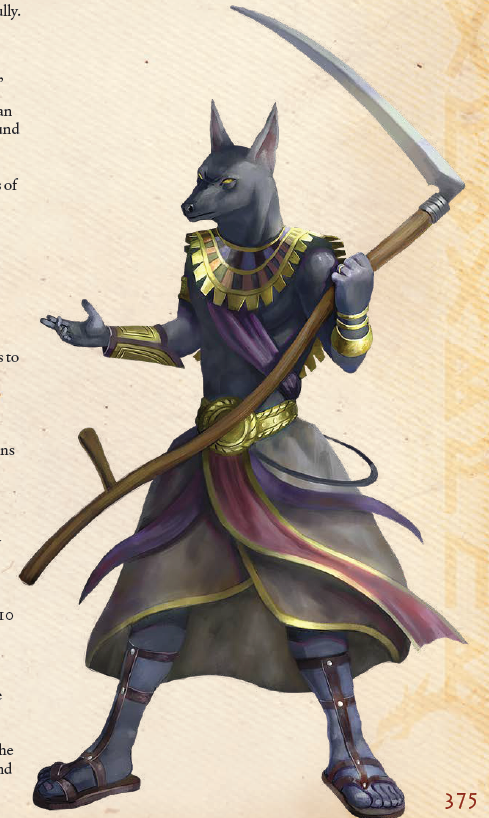
The deties of Nuria Natal are ancient faiths who persevered in a grand human kingdom when other realms fell into chaos. They saw the rise and fall of hundreds of smaller gods within their realm, and as such seem impervious to time. Save for Aten, they all have animal heads and are fond of visiting their worshipers in physical form.
Anu-Akma (Anubis, Hades, Hel) is the god of death, guardian of graveyards and tombs. His priests know anointing rituals for the nobility to help them rise as mummies and liches to defend their lands when the time is right. His worship takes a much darker aspect in the Ghoul Imperium, who revere him as a provider of new dead flesh for feasting. Anu-Akma is one of the most popular deities of Nuria Natal, and is the husband of Bastet; both faiths are known to have worshipers enter into marriages in emulation of their patrons.
Aten is a jealous sun god who forbids the worship of all others by his followers. He is a foe of the dark gods and defends the faithful with his blinding light. However, he is intolerant to the point of violence, encouraging his followers to violently expel non-believers from villages, to pillage and desecrate temples of other gods, and to convert unbelievers or slaughter them as circumstances dictate. They reserve an exception for Khors and Lada who are viewed as Aten's semi-divine offspring: worshipers of these deities are considered to be in error and in need of being shown the proper path. His center of worship is in Per-Xor, and his greatest prophet Ra-Amon-Ra was turned into a martyr when he was slain by Mharoti dragonfire. This "messiah cult" is growing in popularity in both Nuria Natal and the Dragon Empire. The devotees of Ra offer hope and forgiveness, almsgiving to the poor, and dwarves and women comprise a majority of their followers (half of Ra's disciples were female). Both countries banned the cult's worship, which has turned the messianics dangerously violent as a result.
And the kicker of this is that Aten is a Lawful Good god! This may sound downright insane, but keep in mind that Dungeons & Dragons settings have a rich, storied tradition of portraying Lawful Good gods of light as oppressive tyrants in savior's clothing. From the Istaran Kingpriests of Dragonlance to Pholtus' anti-magic sentiment in Greyhawk, Aten is just the latest in a long line of Lawful Stupid idiots.
There's also a Chaotic Evil heretical cult who worships "the True Aten" as a lord of fire, and is believed to be the mask for Loki or one of the Dark Gods.
Bastet (Ailuros) is a chaotic goddess of desire and wild abandon. She is revered among perfumers and alchemists, but also venerated as a huntress for her lioness aspect. She draws a diverse array of worshipers, from farmers who prize a cat's ability to kill mice, alchemists and perfumers honing their craft, temple prostitutes and dancers who heed her guidance for beauty and invoking passion, and gnolls and hunters seeking a fortunate hunt. She is popular in the Duchy of Bourgund due to their perfume industry, where she wears the mask of Ailuros. Bastet's center of worship is the metropolitan city of Per-Bastet, and while men may worship her the goddess only grants the right of priesthood and spells to women.
Horus is the kingly lord of the Nurian pantheon. Although weakened from his battles with Aten and once engulfed by the fires of the desert, like a phoenix he rose from the ashes. He seeks to establish a lost Nurian golden age, and does this by both personally and encouraging followers to slay demons, push back the Mharoti invaders, and bring order out of chaos by putting down usurpers. Horus is popular in the eastern city-states of the Free Cities of the Desert as well as the Tamasheq nomads, and his teachings known as the Code of Horus serve as a legal foundation for Nuria Natal's governance.
Ninkash did not originate among the dwarves, but is so closely associated with them that she is most often depicted as one. The Kariv brought her faith to the dwarves of the Crossroads, and she adopted the brewing rituals of Wotan's priests into a more joyful celebration. The goddess is closely associated with alcohol, beer particularly, and emphasizes its use as a form of social bonding in taverns and festivals. The priesthood is completely egalitarian, sporting both men and women with unrestricted access to hierarchies and training. They are well known for brewing Holy Ales, beverages laced with beneficial magical effects akin to potions.
Thoth-Hermes is a god admired by scholars, thieves, merchants, and wizards alike. He is the patron deity of the Magocracy of Allain, and when those mighty mages found themselves stumped with a supernatural conundrum they often turn to Thoth-Hermes' priests. The deity has books containing his teachings, but all tomes are "holy books" to him: although knowledge may be safeguarded from prying eyes, the destruction book is an abominable act no matter the context or subject material. His temples are libraries, and many markets have small shrines with scales and a locked box for offerings (whose theft is sure to invite deadly retribution from his followers).
City Gods
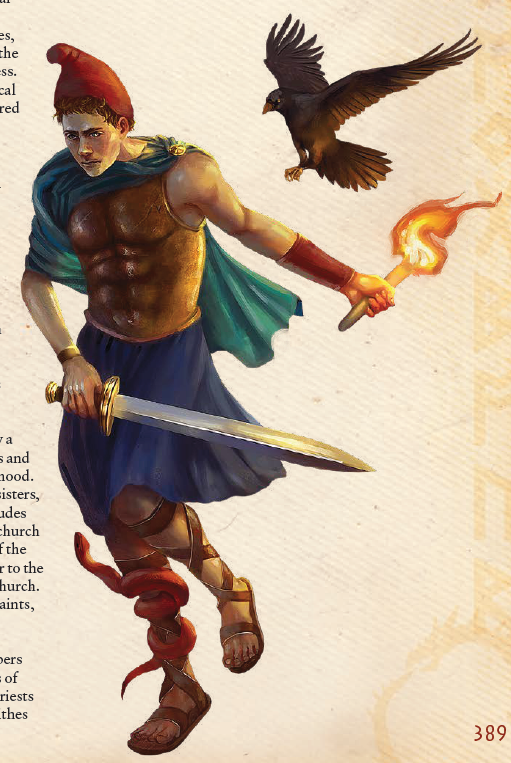
The elven pantheon was once the religion of the Valeran Empire, a vassal of Thorn. But after the Great Retreat the rising war culture saw the development of a different pantheon. Mavros is by far the most popular and considered the head of the Seven Cities pantheon, but every deity encourages their followers to war against each other and the forces of foreign gods. Religious debates are heavily discouraged in public forums, as one faith's is quite often tied to more earthly political alliances.
Ceres the Provider is the goddess of harvest and civilization. She also oversees trade and the roads connecting communities, also vital features of society. Her holy days take place during harvest times and the changing of seasons. Although not pacifists, her followers' emphasis on "reasonable peace" makes her not as popular as other gods in the region. Darker cults worshiper her as Ceres the Reaper, using humanoid sacrifices and slaughter of enemies to ensure a good harvest. Ceres has no long-standing temples, with any such structures demolished via fire on their 50th anniversary to reflect the seasonal winds of change. We also get 5th Edition stats for the scythe: it's a simple melee weapon costing 3 gp. It deals 1d6+1 slashing damage, is 4 pounds, and has the heavy and two-handed properties. A pretty good deal at an affordable price!
Charun is a death god tasked with overseeing the passage of souls from birth to death and to the afterlife byond. He protects planar travelers and his boat sails the rivers of realms beyond Midgard. He is an enemy of many fey and outsiders who visit the world of mortals: such beings often traffic in souls and thus disrupt the natural order. He is not respected in the Ghoul Imperium, and slaves secretly venerate him by pretending to offer rites to Anu-Akma. They hope the gods' protection will offer escape from a terrible existence.
Hecate is an evil goddess of magic and the moon. Her motives are inscrutable even to other gods, and she takes one of three forms depending on the lunar phases: during the new moon she is the vengeful Lady of Darkness; during half moon she is the Lady of Sighs who whispers arcane secrets to the faithful; and during the full moon she's the Lady of Tears, a more benevolent aspect who reveals the future of the world as she grieves for its pain.
Her enslavement of and marriage to the sea god Nethus resulted in the two churches uniting, although some priests of the latter think there's more to the story and suspect the worst. Her priesthood is strong and organized in Khammae Straboli, but beyond that city she has a diverse following of various sizes and among many races.
Mavros the War God and His Order is the patron deity of the Seven Cities, whose entire culture revolves around fulfilling his tenets of holy war. His church is extensive, and the formal order of the House of Swords is both large and whose grounds are considered politically autonomous in the Seven Cities. Most citizens of the Seven Cities plus warriors of all kinds venerate him, but among women and children his aspect as a chivalrous protector is considered just as important as his military aspects. Mavros has two holy books, one of which is the rare Annals of Mavros whose text is impervious to copying and often moved or stolen by various divine heralds.
Mavros used to be married to Hecate, but after her infidelity with Nethus he spurned her in favor of a marriage with Marena the Red. We have a sizable entry on the Order of Mavros, which trains martial orders as their own private army. Due to their politically autonomous nature, their grounds are often havens for criminals fleeing the law. Much like the French Foreign Legion IRL, said criminals can gain legal immunity and a new start by joining the order. In order to discourage opportunists, the Order sends such criminal-converts out as the first wave into high-risk wars. Deserters are hunted down by both the church and whatever authorities they first sought to flee.
All worshipers of Mavros are expected to make a pilgrimage to the Seat of Mavros at least once in their lives, which starts at the House of Swords in Valera. The 900 mile journey through the Western Wastes is dangerous, but those who make it through alive take pride in their survival as testament to their faith and warrior skills.
Nethus is the god of the sea. He was once a powerful deity worshiped all across Midgard, but ever since his imprisonment by the worshipers of Hecate he is but a shadow of his former self. Although freed, he is little more than a pawn of Kammae Straboli's oracles. It seems that he's forgotten his first wife entirely, although some believe that Nethus made a vow of service in exchange for his freedom. He was the patron deity of the island nation of Ankeshel before it sank, and his most devoted followers are all those who rely upon the sea for their livelihood. He is now a sworn enemy of the Mharoti Dragon Gods and wrought great devastation against the priesthood of Seggotan.
Dark Gods
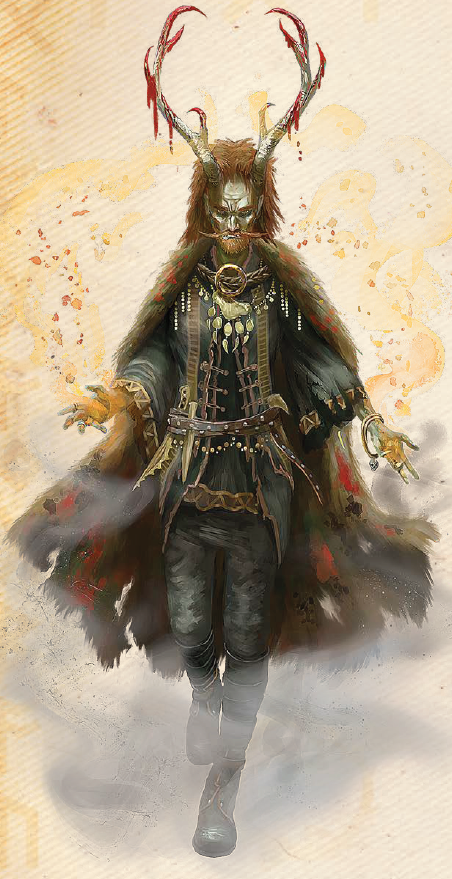
The wicked and forbidden entities known as the Dark Gods are not a single pantheon per se. Rather they are gods who fell from the ranks of true divinity into the realms of demons and devils. Desperate to regain their former power, they demand terrible deeds from their followers. Like Aten, they permit no diversity of faiths and demand that they and they alone be worshiped by priests.
Addrikah is the insane derro goddess who is an oracle and interpreter to even more alien gods. She has little approaching an organized dogma beyond driving others into insanity and the sacrifice of sapient races. Most of her worship takes place among the deep caves of the earth by derro and other inhuman entities.
Boreas is the son of Marena, tasked with one day plunging the world into a deathly, eternal winter. He lairs in the far North, brewing storms and sending minions of cold throughout the world. He is also fond of shapeshifting into the forms of animals and impregnating female members of the species whose forms he takes. Some of the best horses of Midgard are his spawn, and he claims to be the father of all winter wolves for similar reasons.
Chernobog is the embodiment of mortal fears, known for his rapacious hunger and whose presence causes entire graveyards to rise in answer to his call. He is served by all manner of scum and monsters, and his greatest temple is in the gnomish kingdom of Niemheim. His teachings promote Social Darwinism of might makes right, to take what you want from the weak and never show mercy or weakness. As a mortal you are lesser than Chernobog and thus expected to serve him.
The Goat of the Woods is one of the only two non-evil Dark Gods (Chaotic). During the time of the old human magocracies of the west, the Goat of the Woods was known as Bacchana, a deity of night, wealth, and fertility. She encouraged her followers to pursue all manner of lusts and excess, and was one of the most hawkish deities in the arms races of the Great Mage Wars. The atrocities of war, as well as her gazing into the alien realms, irreversibly changed her body and soul. Now both male and female, the Goat of the Woods is a hideous morass of monstrous appendages, worshiped in isolated groves. The Goat of the Woods encourages satiation of sexual desires and to expand one's mind beyond the bounds of sanity while flaunting mortal laws and traditions. The deity's followers consider cross-dressing as an act of devotion as well as a means of breaking laws and taboos.
Conversely, the priests of the Goat are defenders of social outcasts, who seek to defend these people from the society that failed them. One of the most popular gestures among the faithful is the totally metal Sign of the Horns.
The Hunter goes by many names and walks in countless forms. He represents the universal aspect of the predator, the one who pursues the thrill of the chase and the "eat or be eaten" cycle of life and death. He is worshiped by the most violent centaurs and bandits, and among the fey he is famed for his Wild Hunts which can enrapture even gods into riding a bloody path alongside him. In civilized societies his gatherings of faithful take the form of hunting lodges and assassin's guilds. The Hunter's priests claim that their god wears no masks, but others attribute like-minded gods to him.
Mammon is the archdevil of greed, his claws capable of holding entire treasuries. He seeks to claim everything as his property, and to that end he will never be satisfied. He attracts many who lust for wealth and do not care about the ethics of how it's gained. He encourages wealth accumulation through means both fair and foul.
Marena is the goddess of lust, death, and plague. She is the patron deity of vampires, ghouls, and female prostitutes. She is the state religion of the Greater Duchy of Morgau, but encourages evangelism among the poor in other lands. Her priesthood is one of the few means of social advancement for living citizens of the Blood Kingdom. Flagellations, branding, and executions by beheading are her most favored means of punishment. Orgies are a common form of worship and social gatherings in her temples.
Vardesain is the other non-evil Dark God (Neutral) and holds dominion over hunger. He encourages gluttony, cannibalism, and wasteful excess. His followers are frequently power-hungry mortals and predatory monsters who care only for satiating their base needs. Vardesain's temples contain purple worms to devour sacrifices. He is the patron deity of the Ghoul Imperium, and encourages priests to devour the hearts of their enemies.
The White Goddess was born beneath the skin of the world. The first entity she saw after clawing her way to the surface was Khors' divine radiance. It is said that she chased him across the horizon, devouring the surface-dwelling races along the way and forming armor out of their bones. The faithful point to the continual cycle of day and night as their patron's eternal struggle against the sun god. Her primary worshipers are orcs, a near-extinct race which was once numerous but now confined to the underground and most isolated reaches of Midgard. Her holiest days are the solar eclipse, believed to be a hole made in Khors' head when the White Goddess tore a portion of flesh and bone from his skull. During this time the orcs mass in great hordes to raid and kill.
We get 5th Edition stats for a temple sword (one of the White Goddess' favored weapons). It is a martial melee weapon costing 25 gp. It deals 1d8 slashing damage, weighs 2 pounds, and has the Versatile (1d10) and Finesse properties. Besides the Core rapier and other possible 3rd party books, this is the only other 1d8 finesse weapon in 5th Edition D&D. Its 1d10 Versatile property can push this damage even further.
Thoughts So Far: I really like Midgard's pantheons. The mask aspect is a cool and innovative concept for a divine origin, and I like how there's cross-cultural adoption of deities rather than having them be consigned to geographic areas. I liked the idea of de-emphasizing alignment, although I feel that the Worldbook did not go far enough in this regard. But besides the Dark Gods, it should not be too hard to let clerics be of any alignment given how most of the deities aren't innately tied to moral systems or demand atrocities. There is a bit of gender stereotypes among deities called out as being favored by women or have male-focused orders (Bastet, Lada, Mavros, etc) and associating cross-dressers and female prostitutes with the "evil pantheon" is more than a little problematic*. But overall I felt this to be a good chapter.
*unless we count Bastet as a non-evil alternative for the latter.
We're entering the home stretch now! All we have left to cover are the 5th Edition and Pathfinder Rules Appendices!
Appendices
Original SA post


Although the Midgard Heroes' Handbook and the Midgard Player's Guide each cover nearly 200 pages worth of material for 5th Edition and Pathfinder respectively, that hasn't prevented the Worldbook from providing new mechanics. Ordinarily the two appendices are split into their own entries, but to avoid repeating myself I figured to cover them both in one sitting. In some cases there are mechanics found only in one version (usually 5th Edition). I assume that this is because existing material is in the other system already, such as the Lust domain which already exists in Pathfinder. For ease of use, (5e) stands for 5th Edition D&D, while (PF) stands for Pathfinder.
Character Options
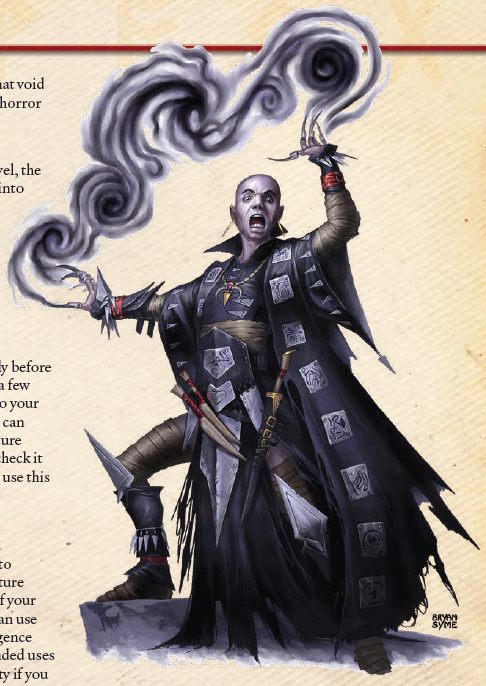
Gnoll Caravan Raider is a background (5e) and is exactly what it says on the tin: it provides proficiency in Acrobatics, Intimidation, Alchemist's tools, and nomadic gear along with the Feature where you have advantage on sifting through and appraising trade goods. In Pathfinder gnolls get two new archetypes: Havoc Runner for Fighters, and Caravan Raider for Rogues. The Havoc Runner has some mobility-based features where you gain increased speed when you move, and you can impose penalty on attack rolls and movement speed to people you hit while running. The Caravan Raider has some bonus feats, but its signature feature is a Shock Bag which is a limited-use-per-day item generator which can replicate an alchemical weapon. We also have a pair of new Rogue Talents (PF) which increase the damage values and save DCs of alchemical weapons, which work great with multiclass Alchemist builds.
Paladins get a new Sacred Oath (5e) of the Giving Grave which is all about transcending the mortal coil. It grants some new blood-themed spells as well as more familiar necromancy spells such as animate dead. Its Channel Divinity can compel undead to attack who you want or stun a target for one minute until it takes damage. Its other class features include granting turn immunity to yourself and allies, gain regeneration when below half your hit points, and as a 20th level capstone you resurrect as a death knight if slain.
The new Lust Domain (5e/PF) in 5th Edition is possessed by Bastet, Freyr and Freyja, Marena, and Bacchos. It focuses on enchantment spells, grants proficiency in one of Deception/Performance/Persuasion, and its Lustful Gaze channel divinity is a single-target debuff which impacts perception related abilities and at 17th level can obey your verbal commands. In (PF) the already-existing domain has replacement powers akin to a bard's fascination or enthrall abilities.
The Hunger Domain (PF) is exclusive to Vardesain and grants the cleric a rounds-per-day bite attack along with feast of ashes as a spell-like ability (which can starve people). Its domain spells are predictably related to food and water creation, buffs usually in the form of bite attacks, and debuffs like energy drain and a new spell Ravenous Hunger (which forces an affected creature to drop what it's doing and eat something nearby).
The Serophage Sorcerous Origin (5e) is all about the dark powers of the blood. It includes reduced damage from bludgeoning weapons, the ability to regain sorcery points or add +1/+2 to save DCs (based on level) if you deal 1d4 slashing damage to yourself, and the ability to form a ring of blood from a recently killed creature to absorb incoming attacks or be launched at foes as a weapon. Its greatest feature at 18th level forcefully exsanguinates blood from nearby creatures to restore your own HP or sorcery points.
Wizards get a lot of fun here. They have a School of Blood Magic (5e) where they gain learn the memories of a creature whose blood they drink, and absorb poisons and diseases from other creatures into their own body...and can launch it at others as a ranged spit attack! The School of Void Magic (5e) revolves around the alien nature of the Void, where speaking the dread language as part of a verbal component can impose disadvantage to an affected target's next roll, and other features the ability to impose necrotic damage as a per-long-rest ability, and at 14th level can manifest a 20 cubic feet of darkness which imposes necrotic damage and disadvantage on Wisdom checks. Finally, the Void Savant (PF) is virtually the same as the School of Void Magic, save that they gain free Extend Spell metamgic feat a limited number of uses per day.
Occultists (PF) can play around with void magic in the form of new Implements, focus powers, etc. As I never got into Occult Adventures, I cannot really comment on this in an educated way on the base class' powers. Their implements can impose madness debuffs, create a warped major image as a Base Focus Power, and various dark magic related Focus Powers like turning into an aberrant alien form, summoning creepy creatures, devouring spells and souls, and free divinations from violent sacrifice.
We have a pair of new feats (PF): the first is the metamagic feat Strengthen Caster where you restore HP equal to twice the level of a cast spell, while Rush of Magic grants a free bull rush using your caster level and spellcasting score on all those affected by an elemental damage spell (acid/cold/fire/electricity). Yes, this applies to area of effect spells for multiple targets, the feat states as such.
Nonmagical Items (5e) presents five new pieces of gear, most focused on the cultures of the Rothenian Plains. The Centaur Lance is a super-spear which does double the normal damage as a regular spear and provides advantage against mounted enemies. The Kariv Wheel Shield can be used as both a shield and wagon wheel which act as a +3 AC shield (but needs STR 16 or disadvantage on DEX checks due to bulkiness) or if used on a vehicle grants it bonus AC and HP. The Khazzaki Trick-Bow is meant to be used to show off in archery competitions, with half the range of a shortbow yet grants advantage on Charisma (Performance) checks for archery-based endeavors. The Rothenian Spice Kit can be used to brew food during rests to regain one additional hit die with a DC 5 Intelligence check by the cook. Finally the whip-sash is an unassuming Kariv weapon disguised as a normal piece of clothing but can be turned into a whip with a bonus action.
Drugs & Poisons (5e/PF) details Requiem, a drug which allows you the ability to cast the speak with dead spell, but with risk of poison damage (5e) or suffering nonlethal damage and penalties on d20 rolls (PF). It can be imbibed as clay to smoke, or smoked in a more powerful form known as bliss which grants contact other plane or speak with dead, save the spirit cannot lie to you. We get a 5th Edition-exclusive poison known as ghoul saliva paste which can cause paralysis on a failed Constitution save, but is very smelly and as such it's hard to sneak up on creatures with Keen Smell trait while carrying it.
We have a new vehicle in the form of a Siwali Dune Ship. In 5th Edition you merely add +25% to the base cost of a ship so it can travel on desert sands; it is not in the Appendix proper but in the Southlands chapter. In Pathfinder it's listed as a vehicle in the Appendix, and provides a full stat block for a Colossal multi-purpose desert and water vehicle: it's 12,500 GP to buy and requires longstrider and pass without trace spells for its creation. A rather reasonable price for a magic item of that kind; nonmagical fortresses are 50,000 GP.
Magical Items
There's quite a bit of magic items here, 23 typical ones and 2 artifacts to be precise. But only half of them are dual-statted for both Pathfinder. I'm not going to repeat them all, just the more interesting ones.
The Black Phial (5e) can provide the effect of a Potion of Greater Healing if filled with fresh blood, but this is limited use item. Blood Mark (5e) is an appropriately creepy coin, as a person can fuel its charges with their own blood, and another person can "fulfill the pledge" to restore their HP at the expense of dealing damage to the original donor. The Keffiyeh of Serendipitous Escape (5e/PF) can be worn as a head garment but also laid out into a flying carpet. The Key of Veles (5e/PF) can be used to locate a ley line or shadow road and open the latter by expending a charge. Memory Philters (5e/PF) are favorites of the shadow fey: they impose various emotion-related buffs and debuffs to the drinker, but their creation requires a mortal to sacrifice knowledge of an appropriate memory (memory of failure or embarassment for shame potion, a nice childhood memory for a joy potion, etc). A Nullifier's Lexicon (5e) allows you to communicate in Void Speech and grants the ability to cast certain spells from its pages, but successive castings deal a cumulative 1d6 necrotic damage whose damage value only resets during long rests. The tome can also rearrange reality to your will once a week. The Staff of the First Labyrinth (5e/PF) is a creation from the days of the Moon Kingdom and can banish stricken opponents to an extradimensional maze for a limited time.
Our two artifacts are And'Ducyr (5e), the Khazzaki Khan's legendary longbow which generates its own ammunition, grants truesight to one who draws its string (but deals damage if you don't fire it at a creature within your turn), can fire blinding arrows, and grants advantage and proficiency on Charisma and Intimidation/Persuasion/Performance skills respectively. The Spark of Kjord (5e/PF) is a formless power of divinity which was last possessed by a priest of Mavros before his death at the hands of vampires. It grants advantage/bonuses on Charisma checks to rally people to your cause and deals bonus/radiant damage to undead creatures along with the effects of the bless spell. The spark leaves you to inhabit another creature if you die or waver in your convictions against fighting vampiric tyranny.
Fun Fact: the Spark of Kjord is a reference to the divine sparks in the Southlands Campaign Setting. Such things were stored ephemeral energy of the mighty titans of Glorious Umbuso. They were meant to be found as rare treasure, usually in a king's vault or well-guarded dungeon, and in game purposes granted the powers of Mythic Tiers.
Alternate Magic
This details new magic sub-systems. The first we have is Blood Magic (5e) which was created by the evil wizard Taergash the Bloodpurger. His spells are highly sought after by wicked mages of all kinds, and the book cautions against granting these spells to PCs on account that they are "evil options" not suitable for most parties.
Red Portal Magic (5e/PF) meanwhile is is a unique form of extradimensional transportation which connects not only to shadow roads but other planes, times, and alternate realities which the book calls out as being possibly other published campaign settings. It has no game mechanics beyond suggestions on their use and the most well-known red portal locations in Midgard.
Shadow Magic (5e/PF) is fully detailed in the Midgard Heroes' Handbook/Player's Guide, but for now we get notes on Shadow Corruption: it's basically a debilitative condition gained from spending a long time in the Shadow Realm, pacts with dark beings, etc and is represented in six stages. Lower stages involve minor debuffs in bright light and social penalties, but later stages make you blind/sickened/etc in light until you eventually become a Shadow Thrall. Those unfortunate souls are maddened people obsessed with the Shadow Realm and can be commanded by creatures of shadow.
Void Magic (5e/PF) gets a pretty lengthy entry here. Long story short, it's Lovecraftian magic gleaned from aboleth glyphs, but can also come from the howling denizens in the dark spaces between the stars. For 5th Edition we get a pair of feats for Void Magic: Void Channeler which ups the DC for speaking the language to 8 + proficiency bonus + Charisma modifier for its frightened effect and is no longer limited to just hearing it for the first time. The limiting factor is that you take necrotic damage if you use it too often between rests. Void Scribe lets you inscribe a glyph on an object to make it vulnerable to and take necrotic damage the round after. As far as the feats go, Void Channeler's quite good for the debuff effect of frighten, whereas Void Scribe is rather weak.
We get discussion of Void Taint, which usually comes from exposure to related magic, monsters, and terrain poisoned by the powers of the Void. It is resisted with a save appropriate to the method of taint, and people with void-related archetypes and feats have advantage on the saving throws. Failure causes affliction with a short-term madness. Further Void-related maladies can make madness effects last longer or gain physical deformities based on a numeric threshold known as Void Taint. The madness effects are generally role-play focused obsessions, but the deformities have mechanical effects: they are generally a double-edged sword, such as constantly producing slime on your skin which grants advantage on checks to slip out of bonds, but advantage on checks for other people to track you.
Spells
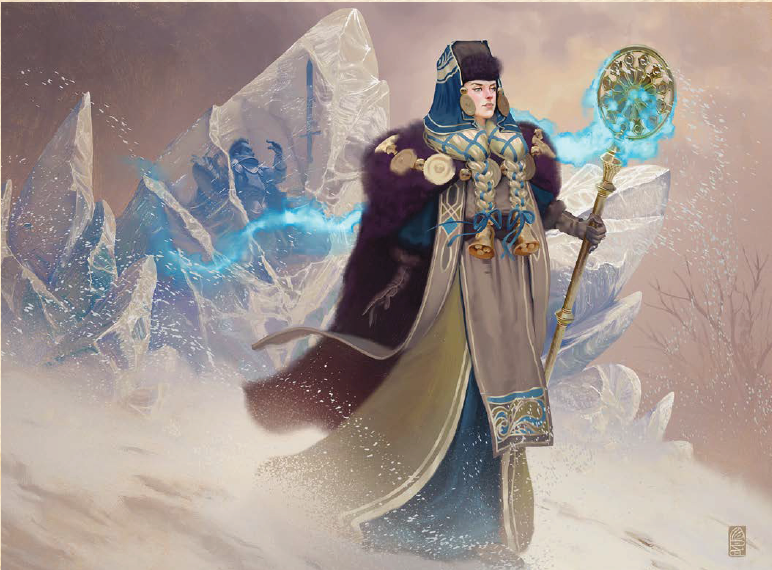
The final section of the twin appendices do not disappoint. We have 77 new spells for 5th Edition, and about half that amount for Pathfinder. For new magical types, we also have [blood] and [void] descriptors for both 5th Edition and Pathfinder entries.
While you'd think that 5th Edition would get most of the exclusive spells, interestingly there are are several Pathfinder-specific options. Two of them are incantations handled as rituals: Incantation of Fealty Given Form (geas/quest to the Duchy), and Incantation of Walking the Shadow Roads (go through a shadow road). Other Pathfinder specific spells include Essence of Instability (radiate an invisible damaging aura), Grasping Water (water sprouts attacking pseudopods), and Halt Vessel (prevents seacraft from moving).
Like the magic item section, I will not cover them all. Instead I'll focus on the most interesting ones.
Alone (5e/PF) is an enchantment spell which fools the target into thinking its allies vanished to another realm; this prevents them from interacting and gaining teamwork-related abilities and treats them as if they were invisible and silent. Blood & Steel (5e) allows you to charm a construct by pressing your own blood into a handprint on it. Conjure Undead (5e) lets you summon a shadow to do your bidding, but higher spell slots let you summon stronger undead such as wights or ghosts. Conjure/Summon Minor Voidborn (PF/5e) and Conjure/Summon Voidborn (PF/5e) summon an aberration or outsider of a relative power level, and in 5th Edition expending higher level slots lets you summon them in greater numbers. Doom of the Slippery Rogue (5e) covers a 20 by 20 foot section of wall or floor with bacon fat and can cause people to slip or fail on a failed Dexterity save or Strength (Athletics) depending on circumstances. Find Kin (5e) is a low-level ritual which allows you to learn the identity and general location of a random living blood relative of the target. Hobble Mount (5e) deals 2d6 bludgeoning damage (plus 2d6 per slot over 1st level) to a mounted creature which moves more than half its normal movement speed in a round. Ice Soldiers (5e/PF) creates one or more humanoid constructs made from freezing water poured out of a vial, which has respectable statistics for a melee-focused creature. Mammon's Due (5e) summons a burning figure of ash to grab and deal fire damage to creatures in its space to pull them underneath the ground. Open Red Portal (5e/PF) can create a two-way portal on a nearby Shadow Road to take you anywhere in Midgard in the present day, up to 1,000 years in the past, or another plane of existence. Void Rift (5e/PF) opens up a rift into absolute nothingness akin to a black hole, forcefully dragging creatures within the area of effect, deals damage, and either treats them as blind and deaf (5e) or begin to suffocate from lack of air (PF).
Also the Lust Domain for 5th Edition has 3 new spells specific to that ruleset. Throes of Ecstasy causes a target to be overcome with sexual euphoria, is incapacitated, auto-fails Wisdom saves for the duration, and suffers 1 to 3 levels of exhaustion based on how long the spell lasted. Lovesick is akin to confusion in that you roll a 1d10 for random behavior: do nothing and sulk like a lovelorn teenager, burst into tears and take the Dash action in a random direction, fly into a jealous rage and attack a random creature, etc. Finally, Kiss of the Succubus can only be used on a charmed creature or one affected by your Lustful Gaze Channel Divinity: it deals 5d10 psychic damage on a failed Constitution save and reduces the victim's HP maximum by that amount until a long rest (or kills them instantly if their HP max is reduced to 0).
Thoughts So Far: There's quite a wealth of material in both appendices, especially for spellcasters. I have to wonder how many of the 5th Edition specific material already exists in a Pathfinder book, on account that most Midgard books have been published for that ruleset. If most of them don't exist in earlier products, I can't help but feel that Pathfinder players are getting the short end of the stick here. Some of the abilities seemed to have questionable balance: the Kariv Wheel shield when combined with heavy armor and magical enhancements can push one's AC beyond bounded accuracy thresholds, the Serophage's boost to spell DC is a great deal for just a little bit of damage, and the Throes of Ecstasy is a great setup for a followup Wisdom-save effect...presuming your gaming group would be comfortable with having you cast that spell, as it's technically sexual assault if done against an unwilling creature.
As for what I liked: I found that the Oath of the Grave paladin makes for a pretty good martial necromancer archetype. The Rothenian Spice Kit brings back fuzzy memories of Final Fantasy XV's camping mechanic. The memory philters and the methods of their creation were thematically awesome. The Red Portals have great potential for multi-campaign crossovers or "guy sucked from modern world into fantasy realm" adventure ideas. Requiem's dead-speaking properties make it both a useful resource for players, as well as creating an insidious effect for addicts desperate to speak to loved ones as a social scourge.
Concluding Thoughts
My feelings for Midgard remain just as strong as they were when I first picked the book up six years ago, albeit perhaps with a more critical eye on its problematic elements. Still, the 2018 Worldbook is a worthy successor for fans and newcomers alike. There are very few settings out there like it: it calls upon fairy tale and folkloric elements without taking a stereotypical "kid-friendly" route, it has a diverse kitchen-sink world which feels naturally connected and not disparately crammed together, and its relative rules-neutrality but with system-specific booklets makes it accessible to gamers of various fantasy RPGs.
Between this and Northlands, I am probably going to take an extended hiatus from writing Let's Reads for the time being. But I hope that I demonstrated to readers the strengths of Wolfgang Baur's long-running passion project, and hope that you all enjoyed reading this review as much as I enjoyed writing it!